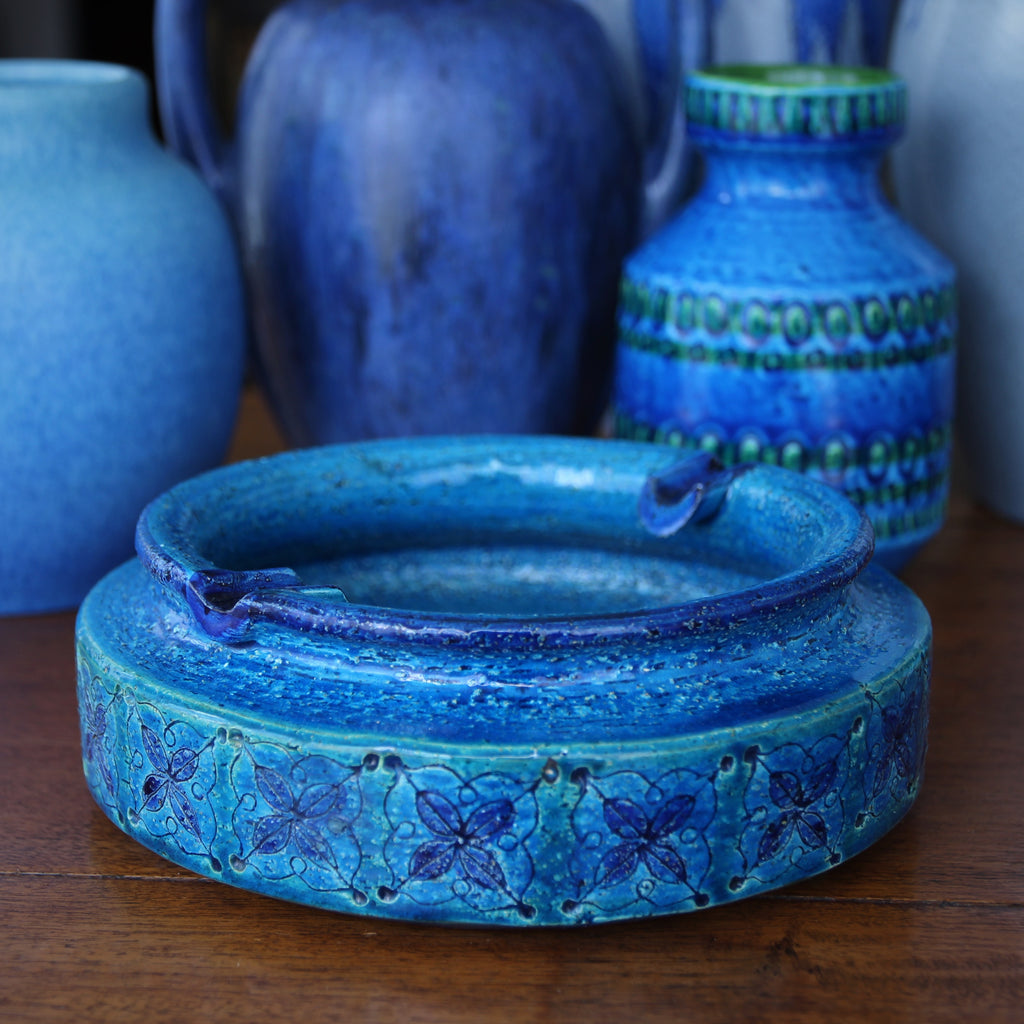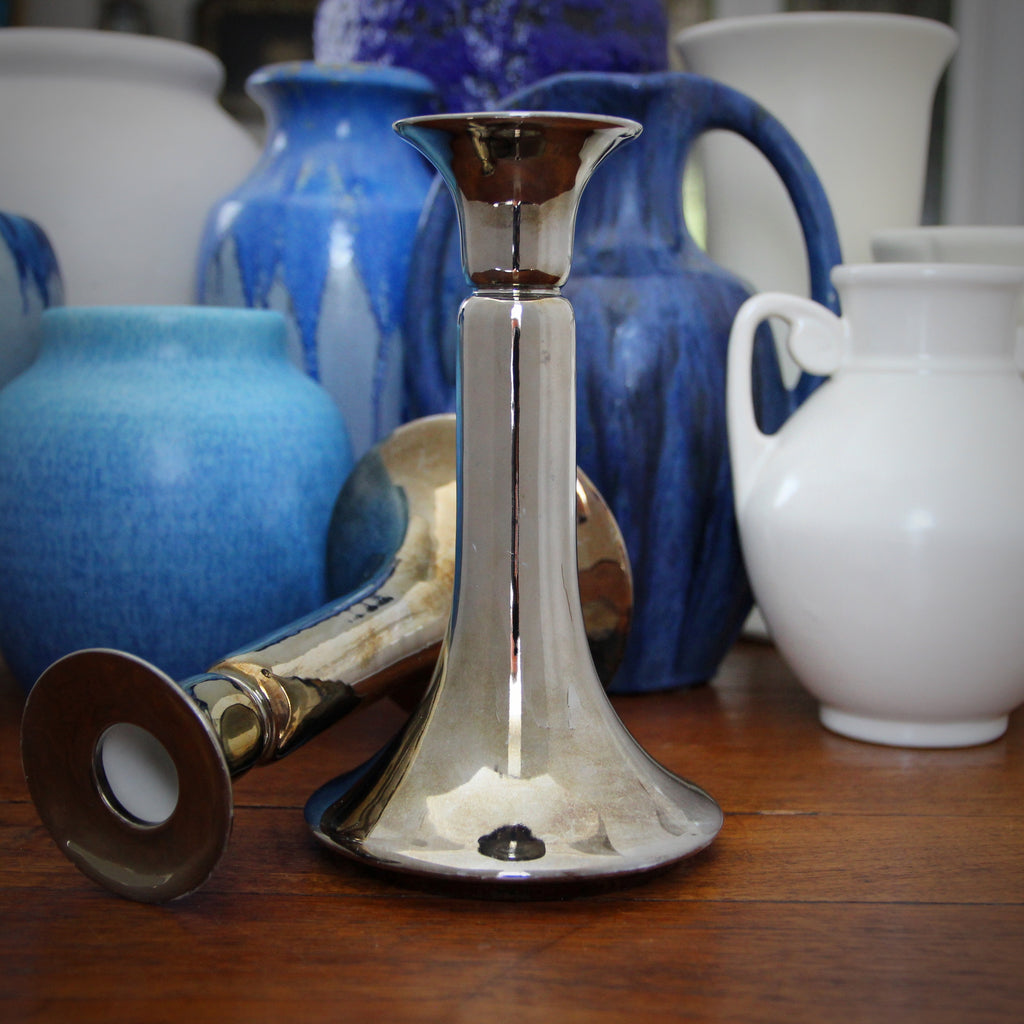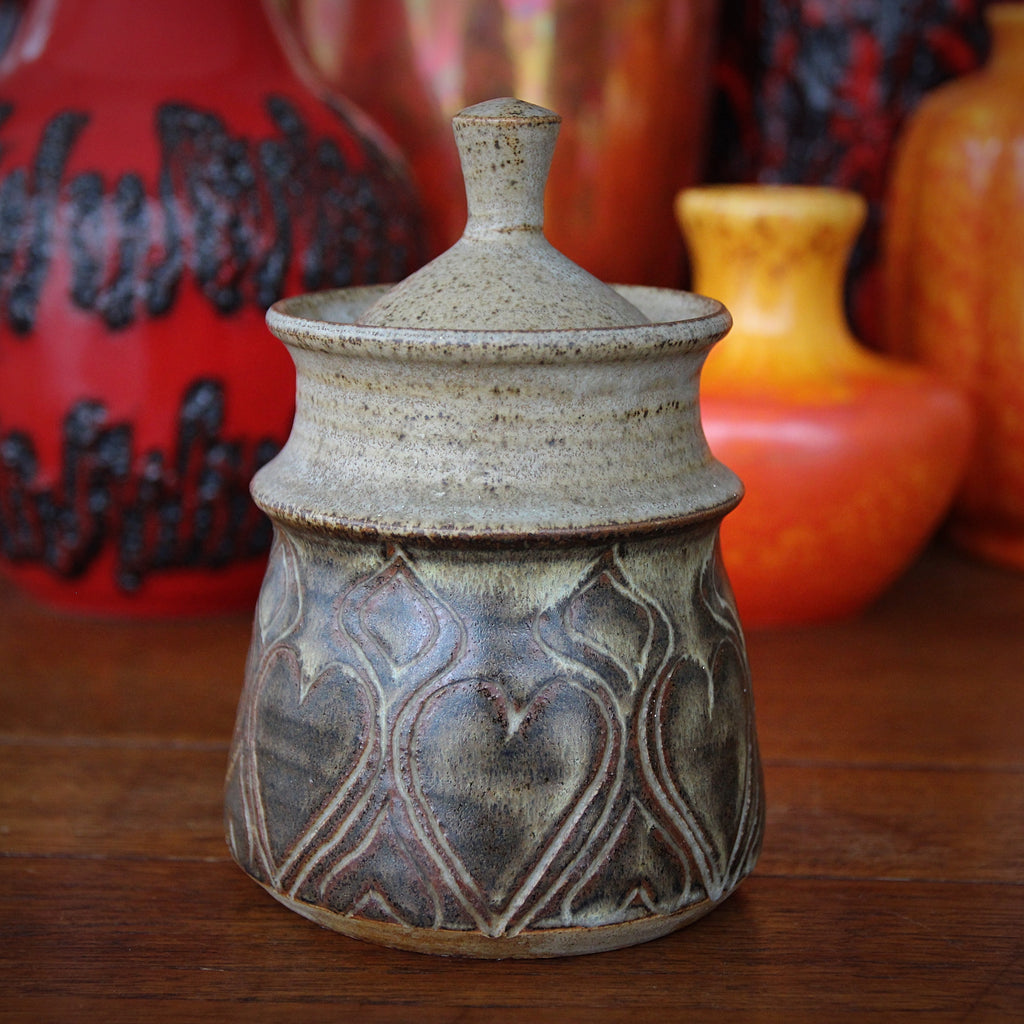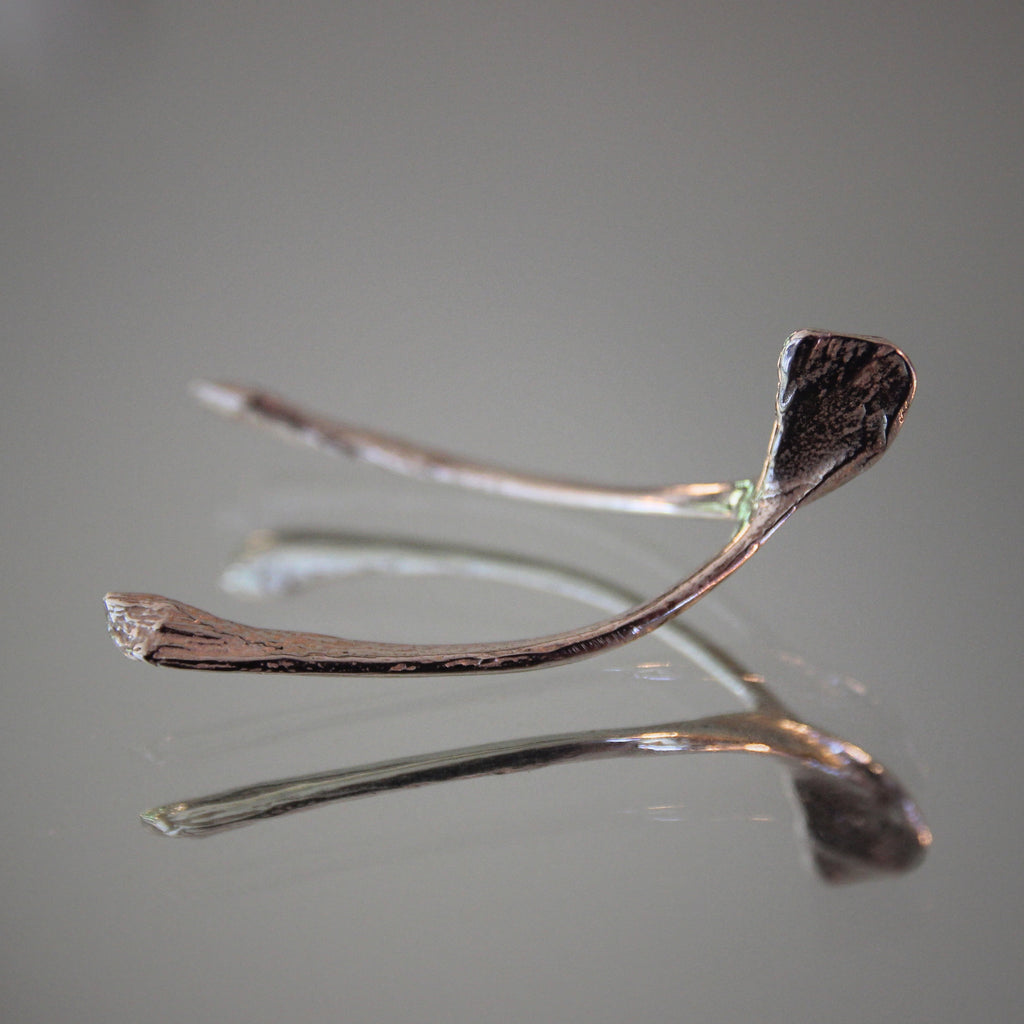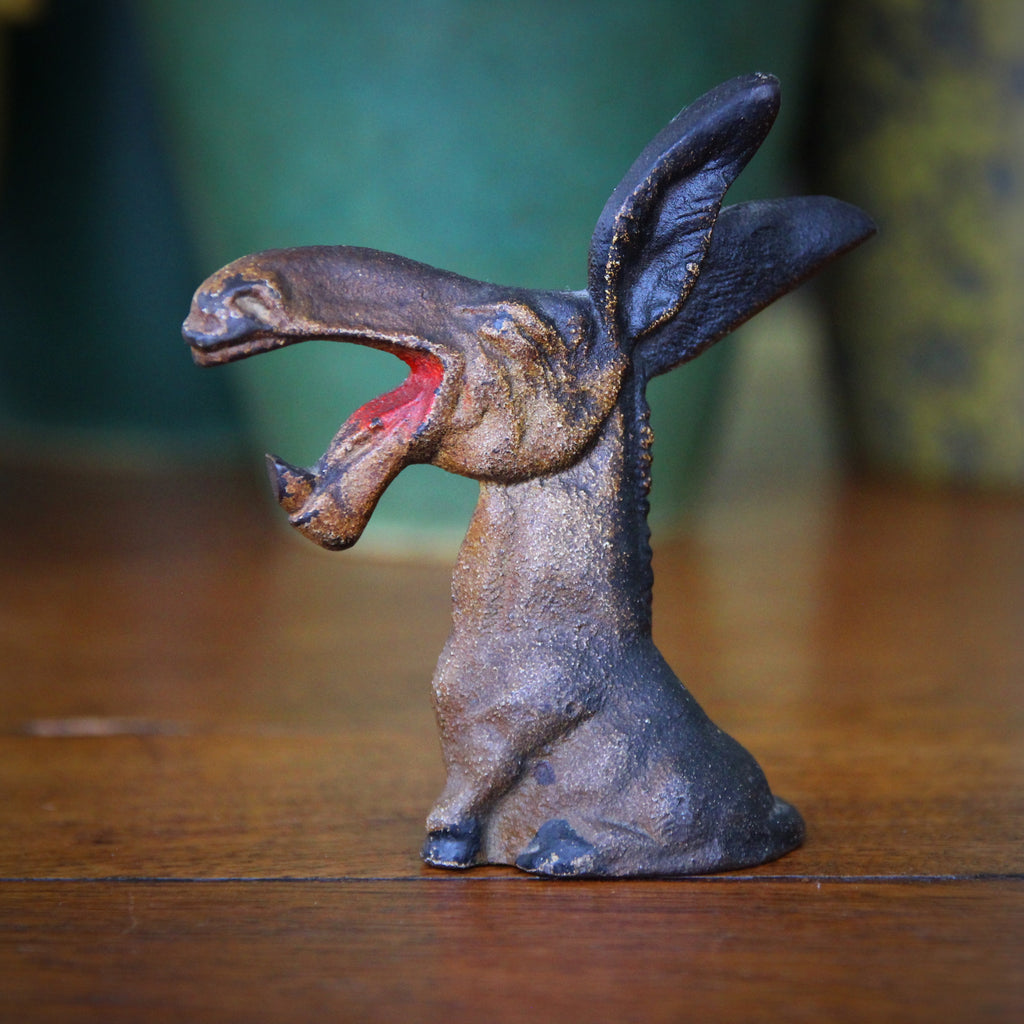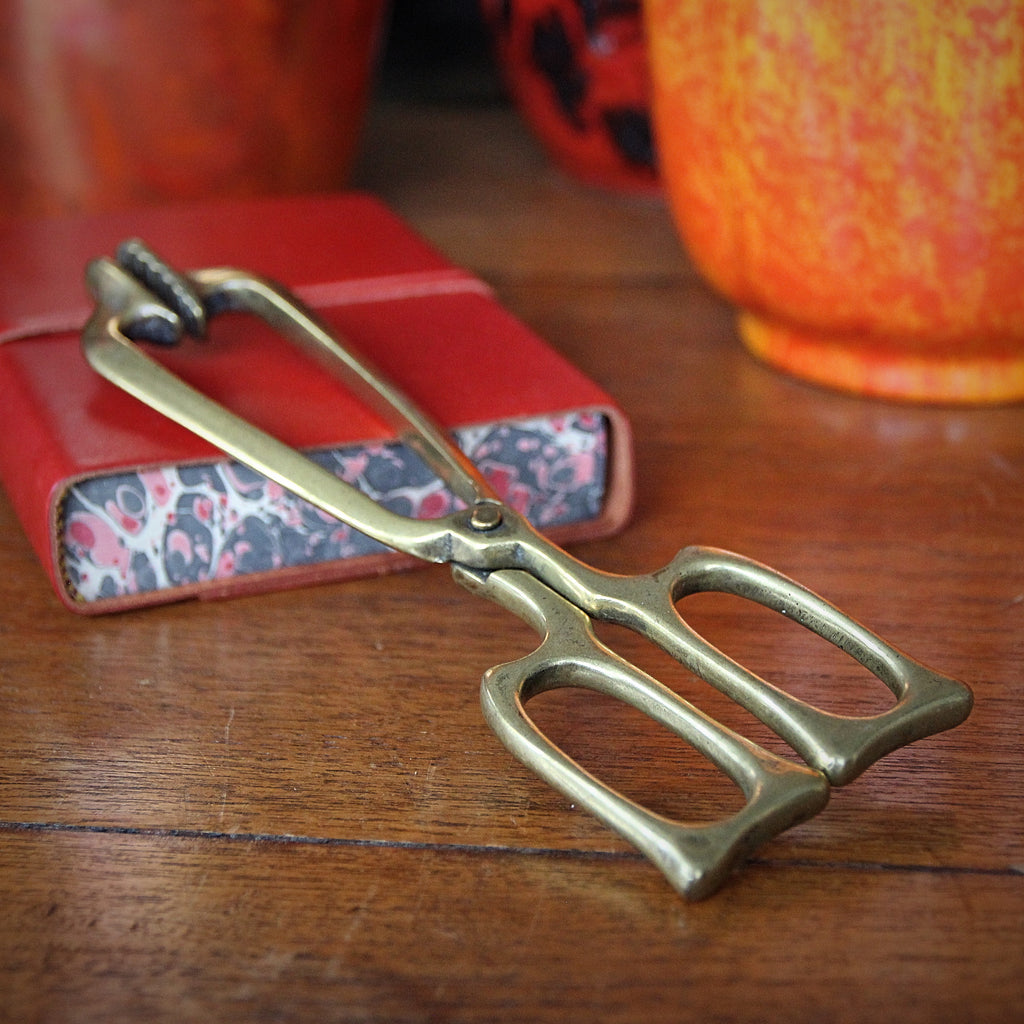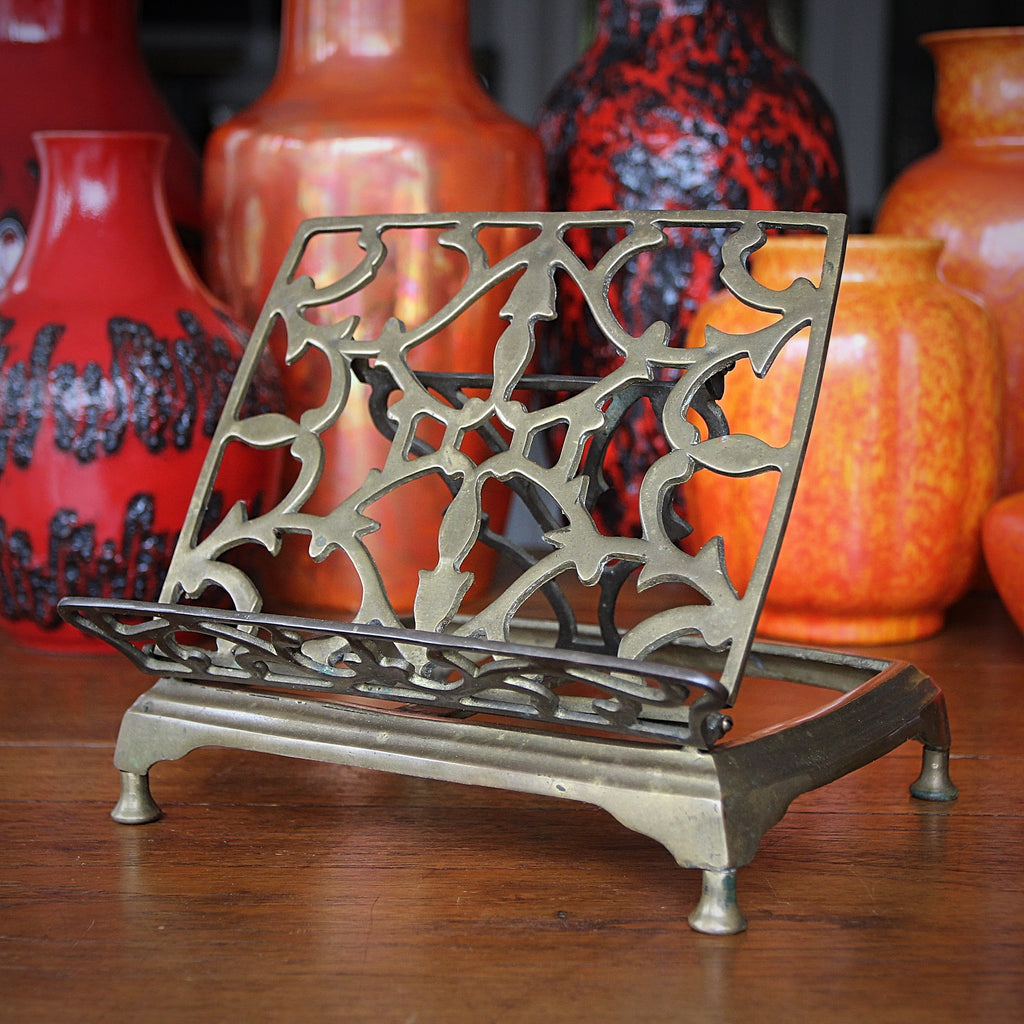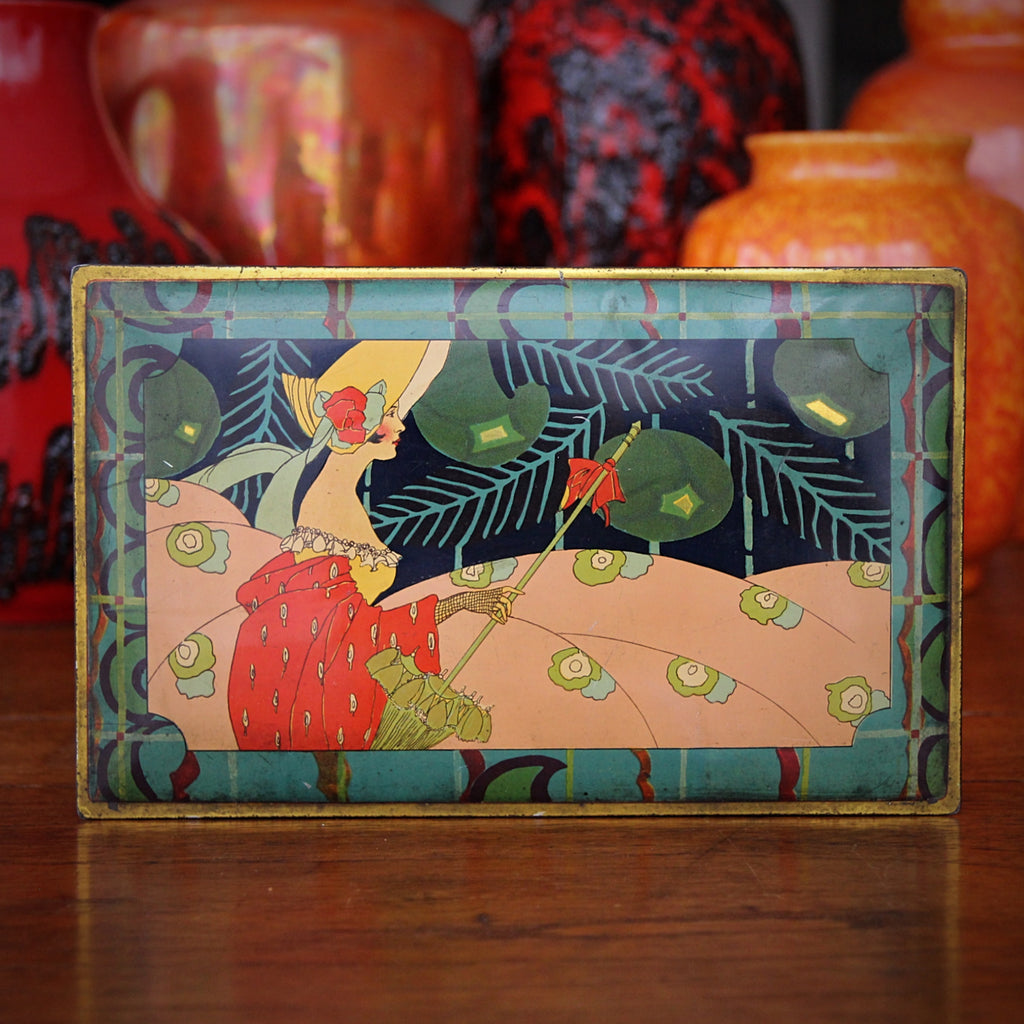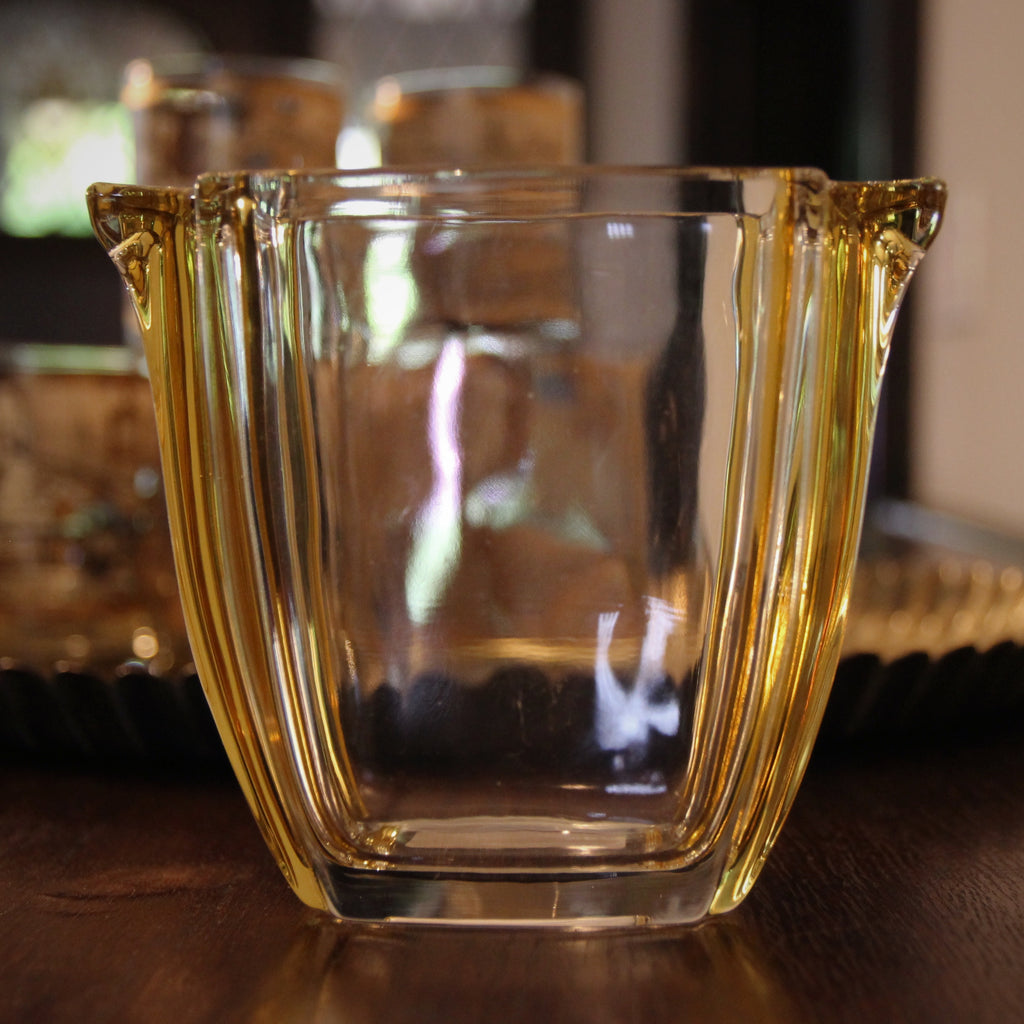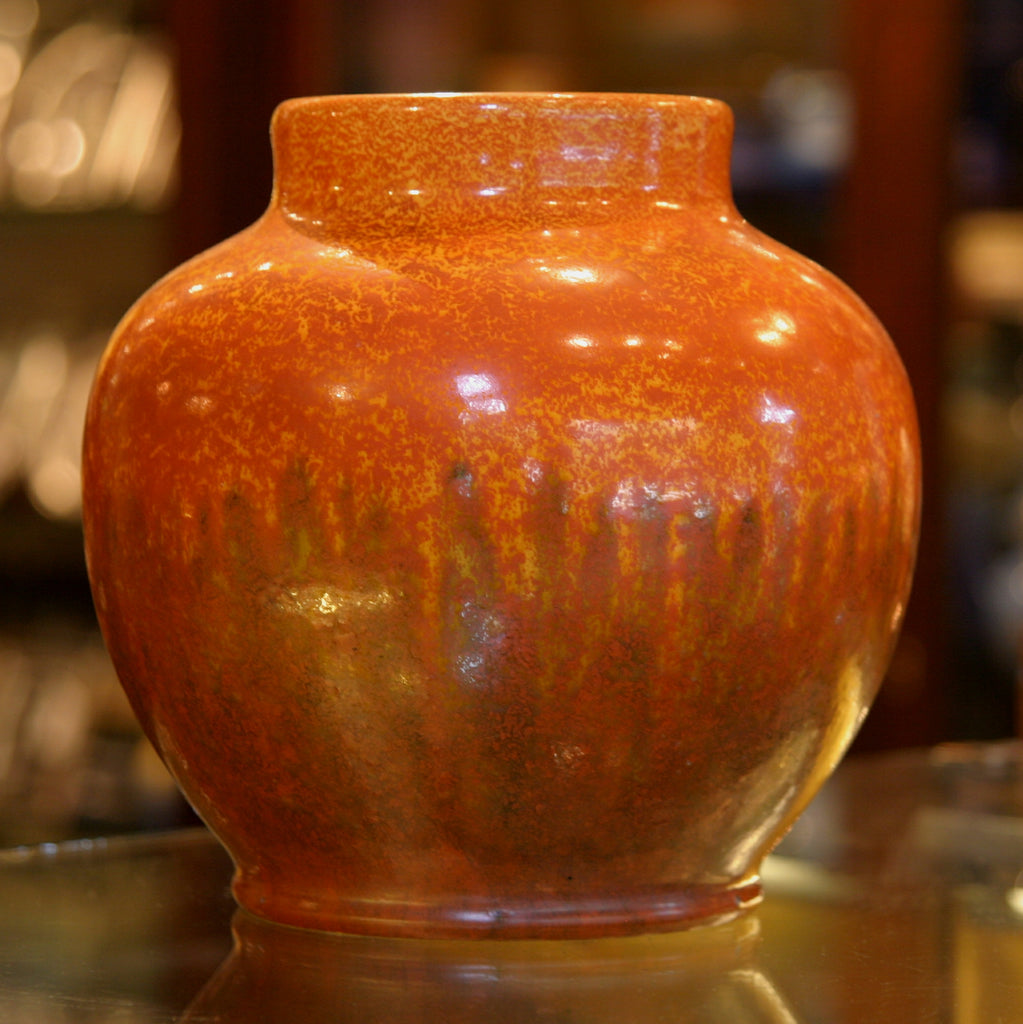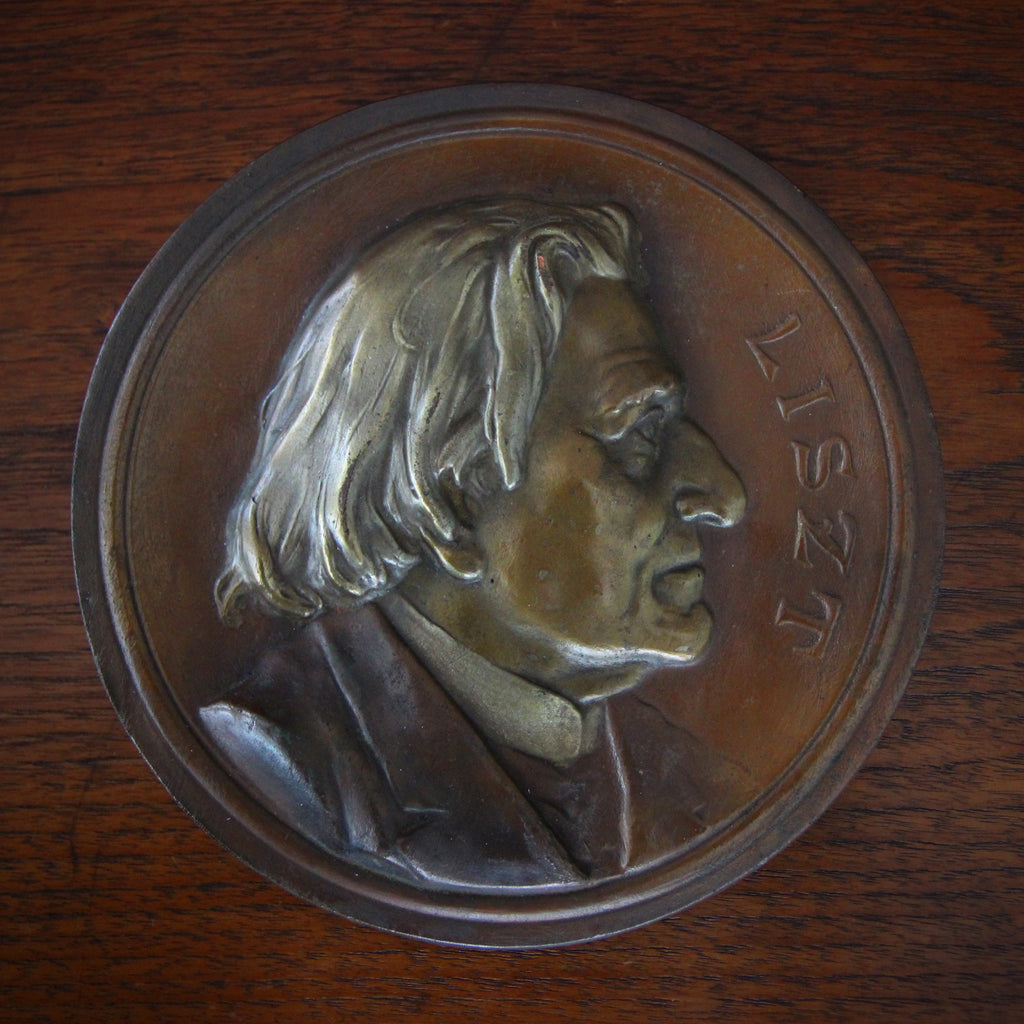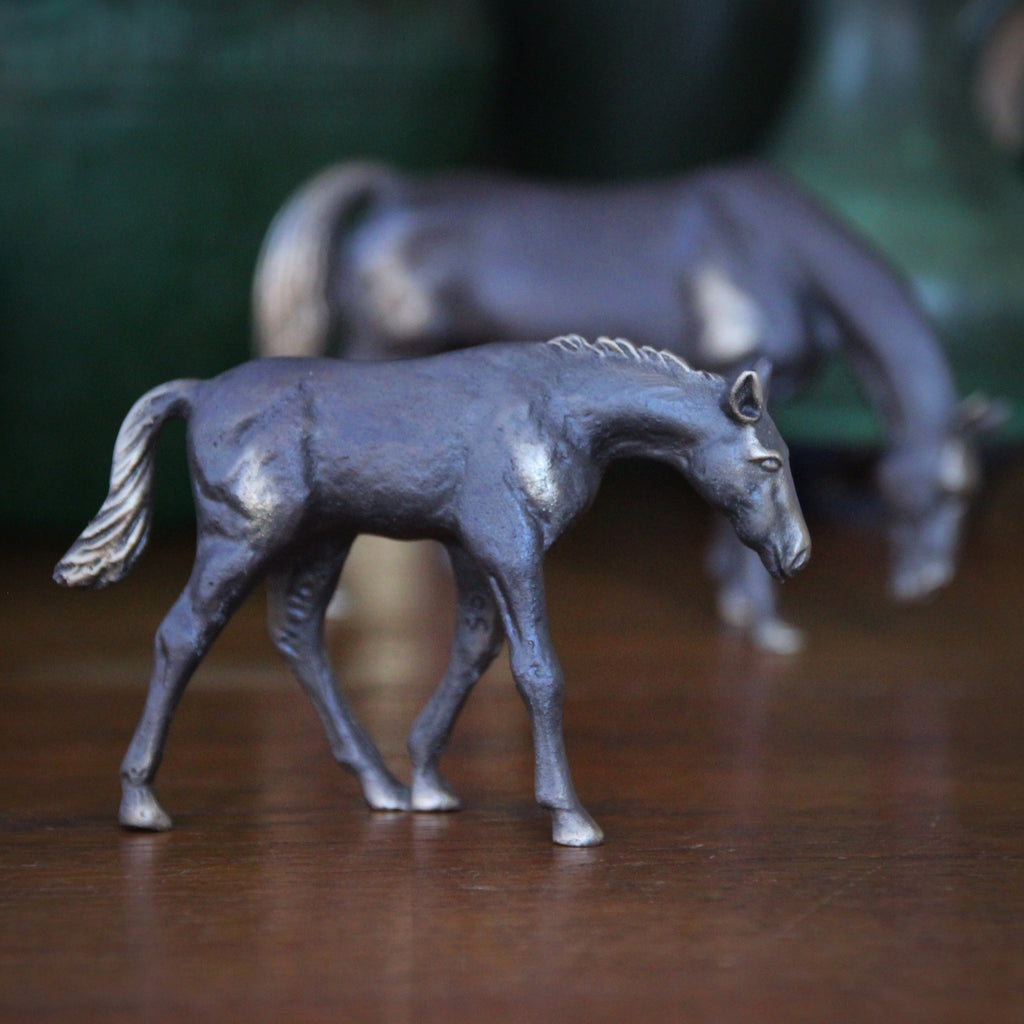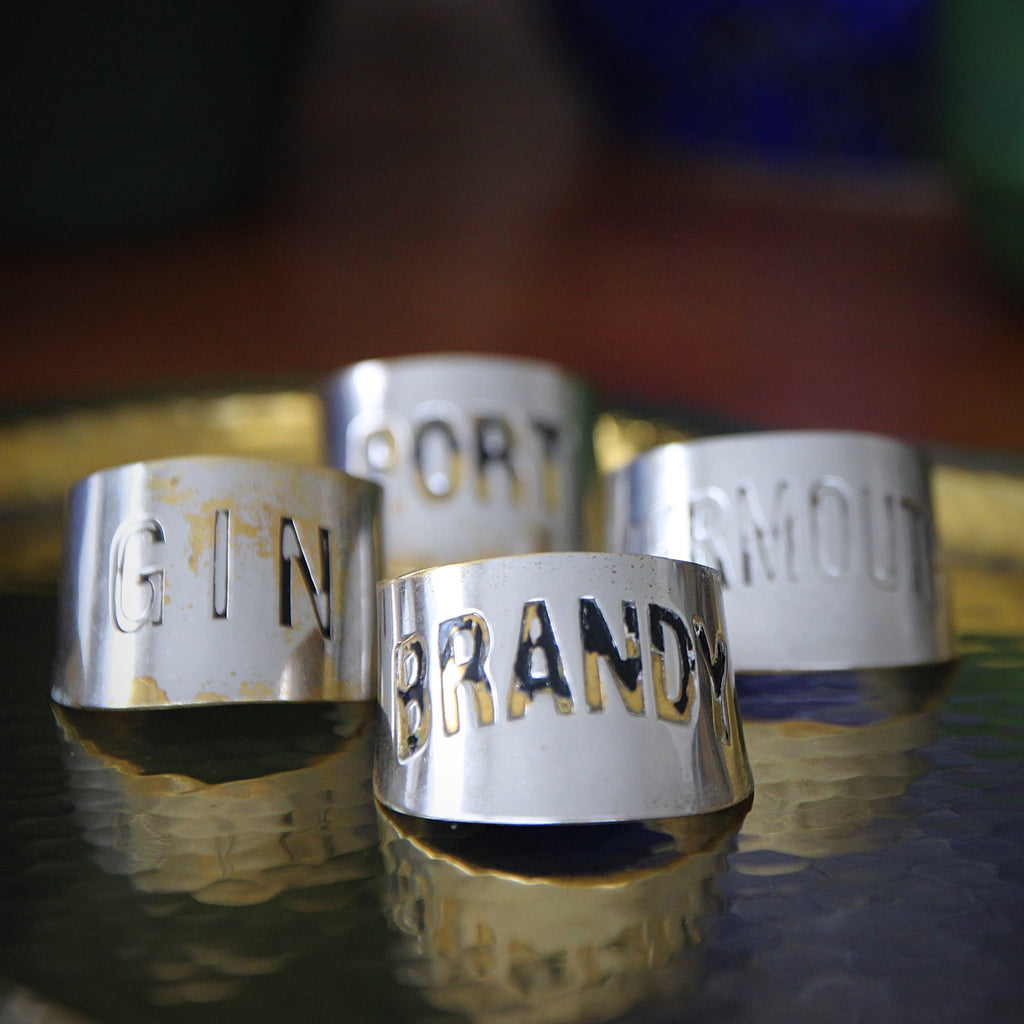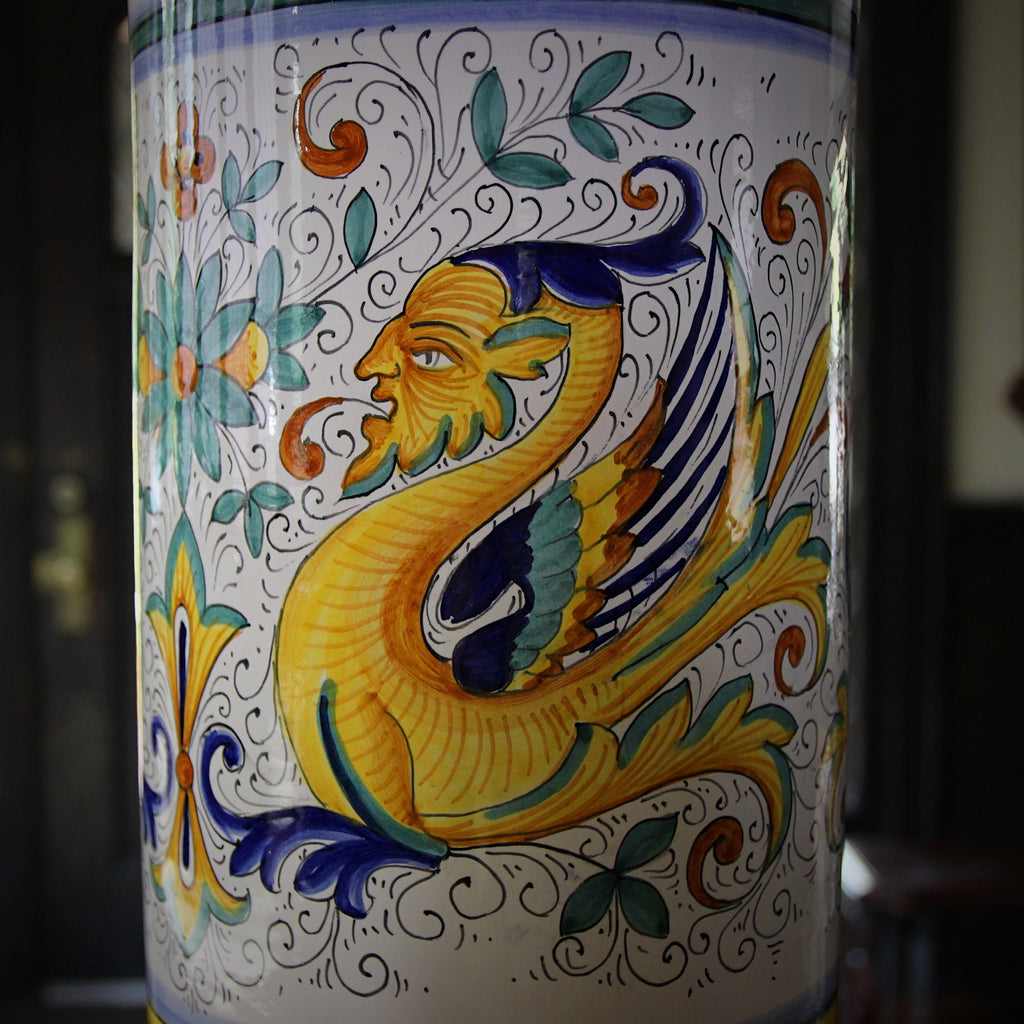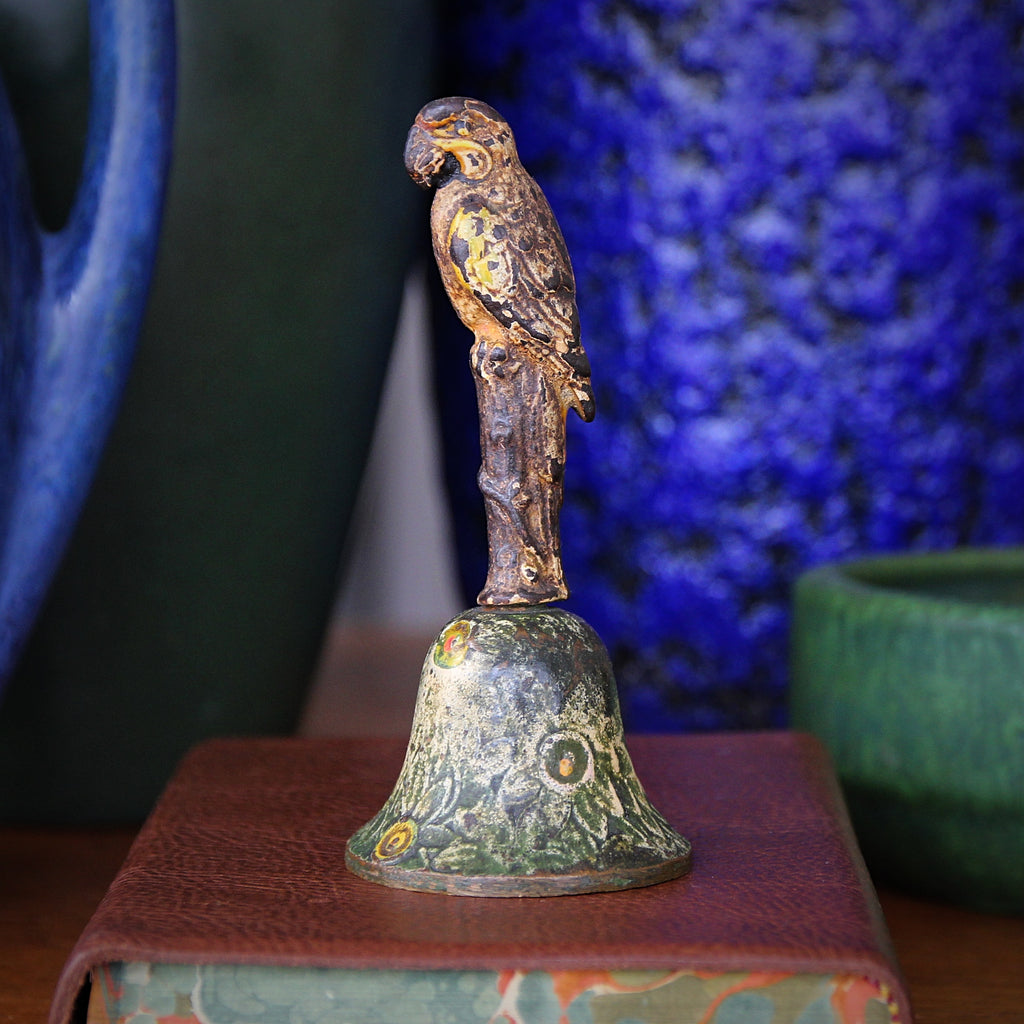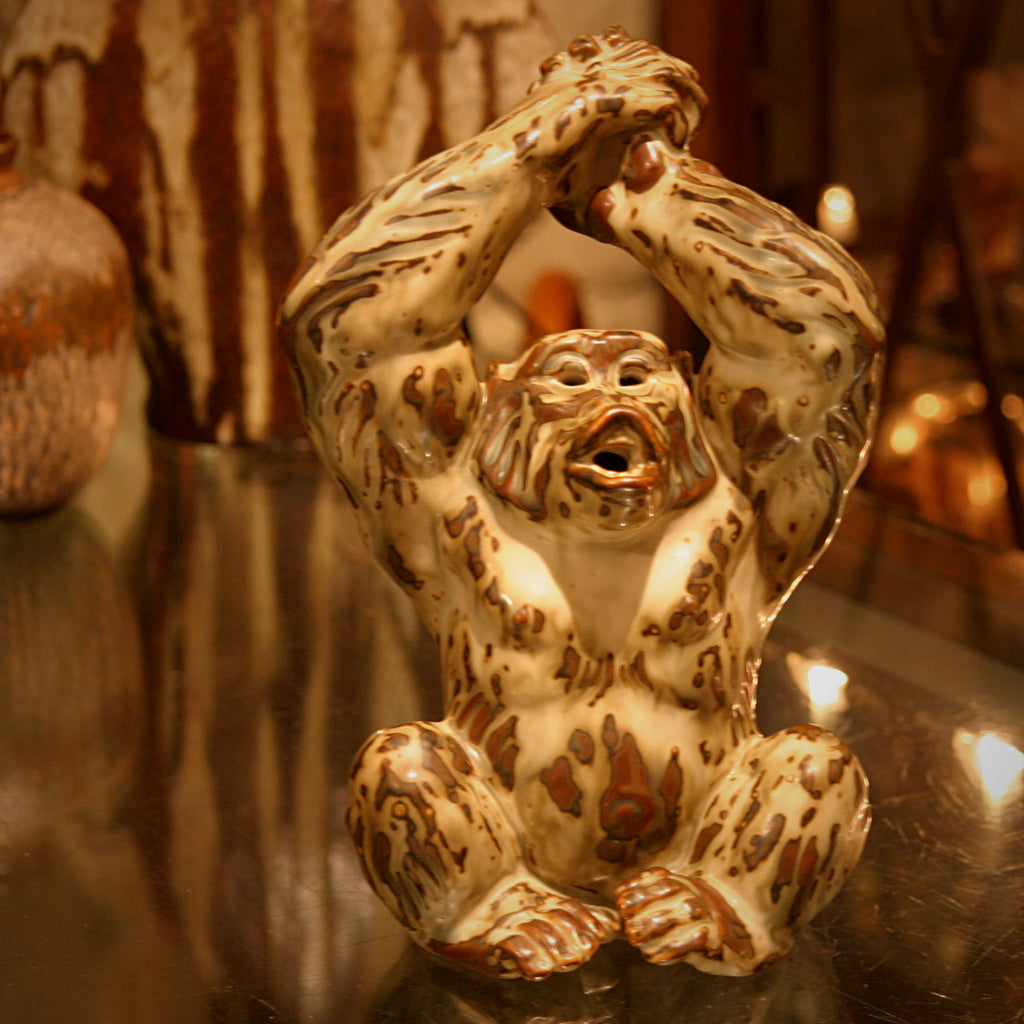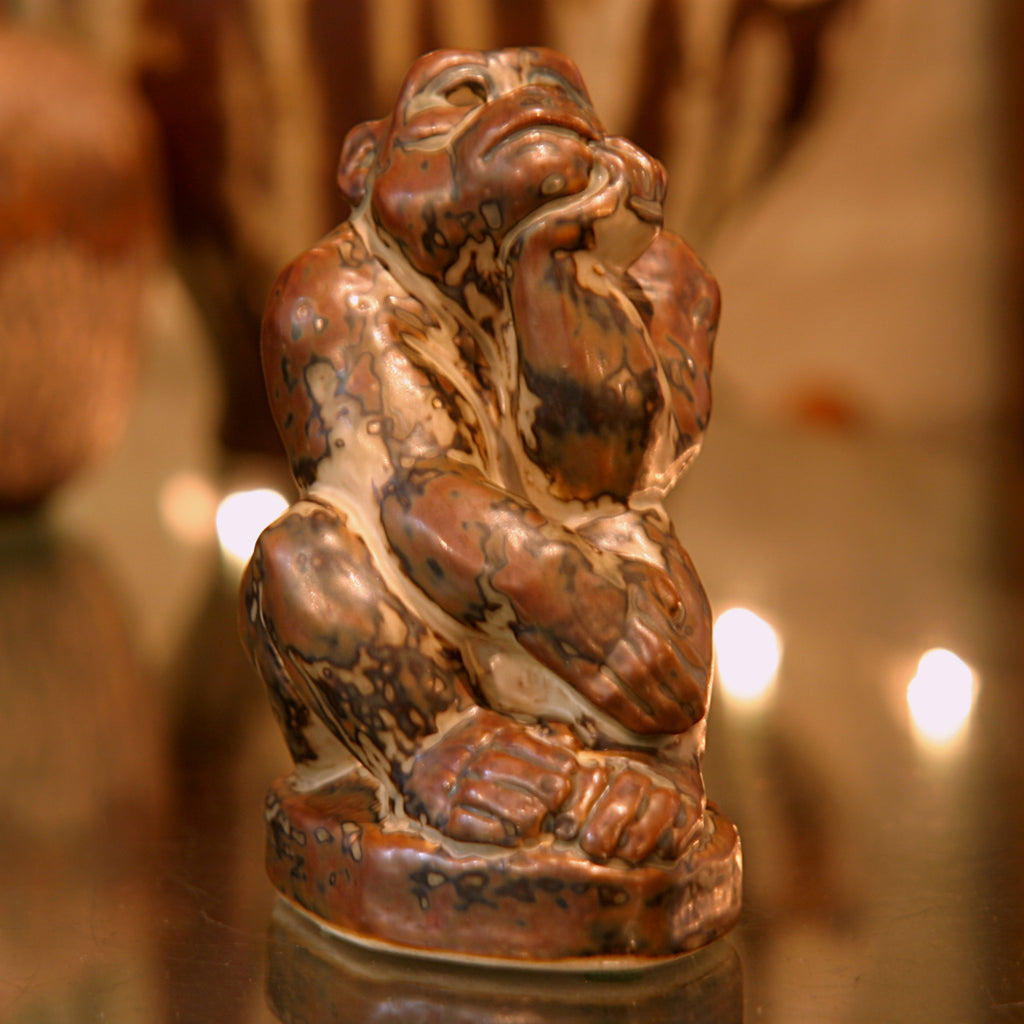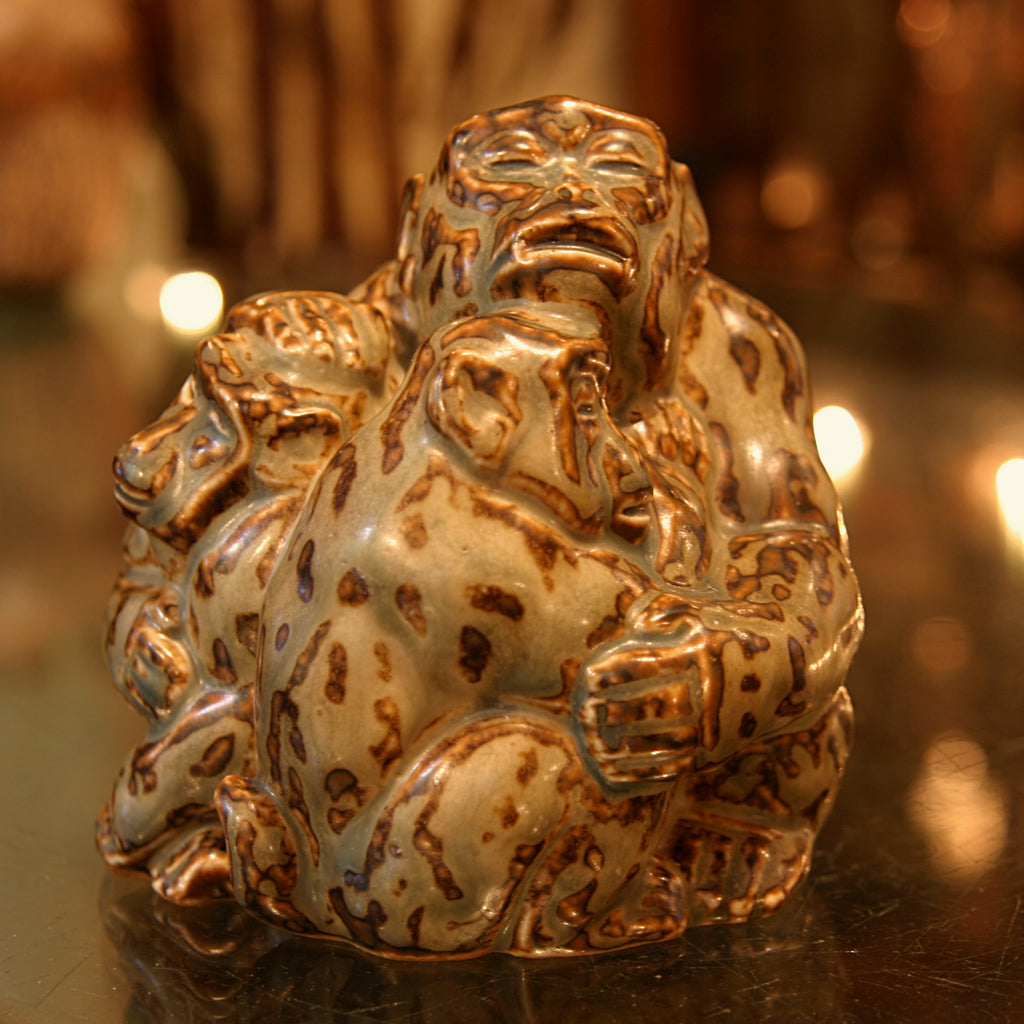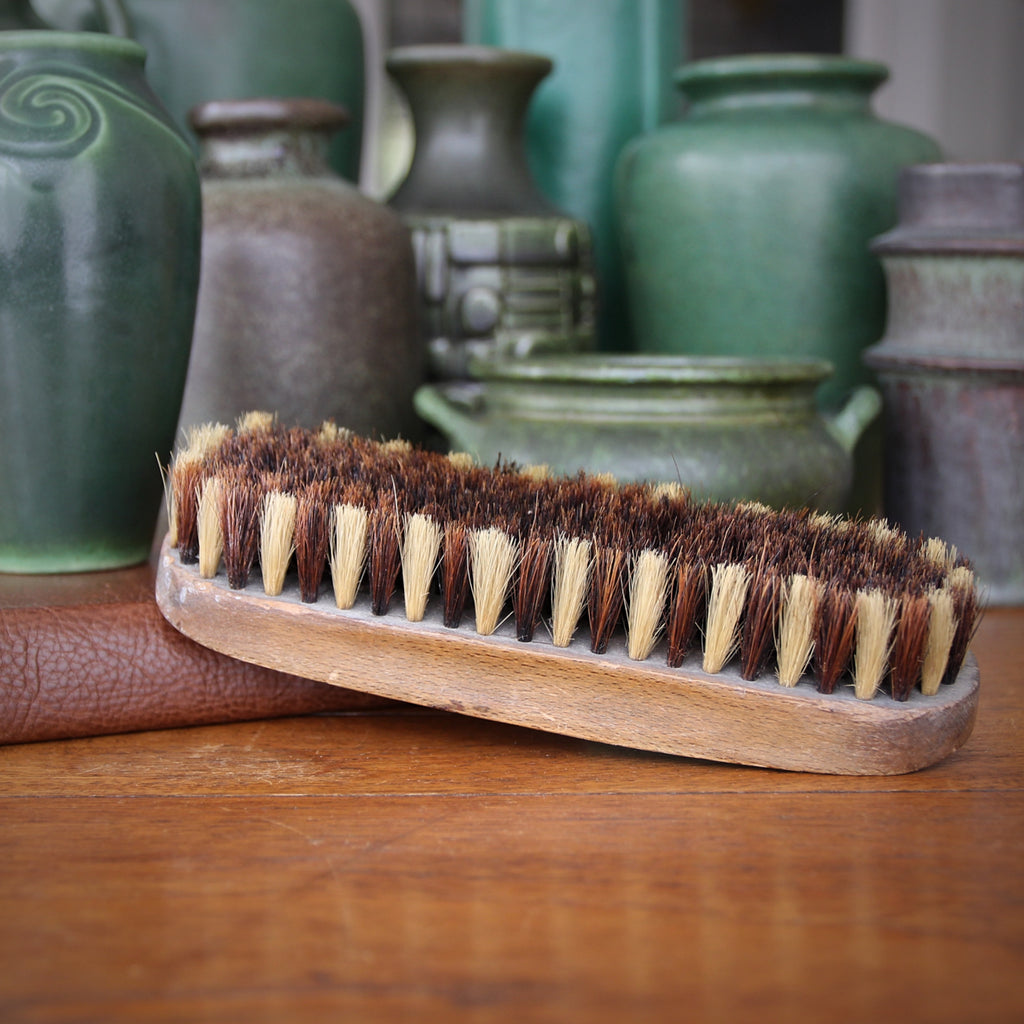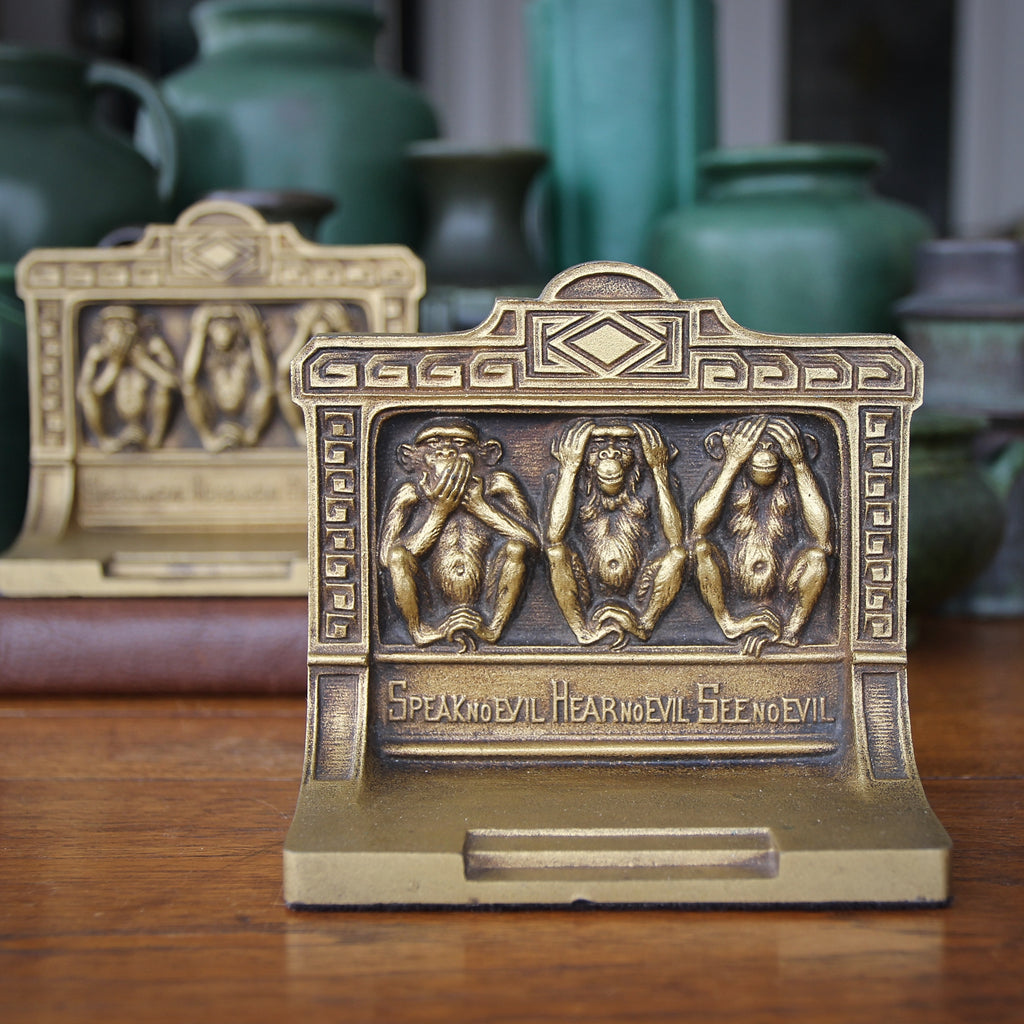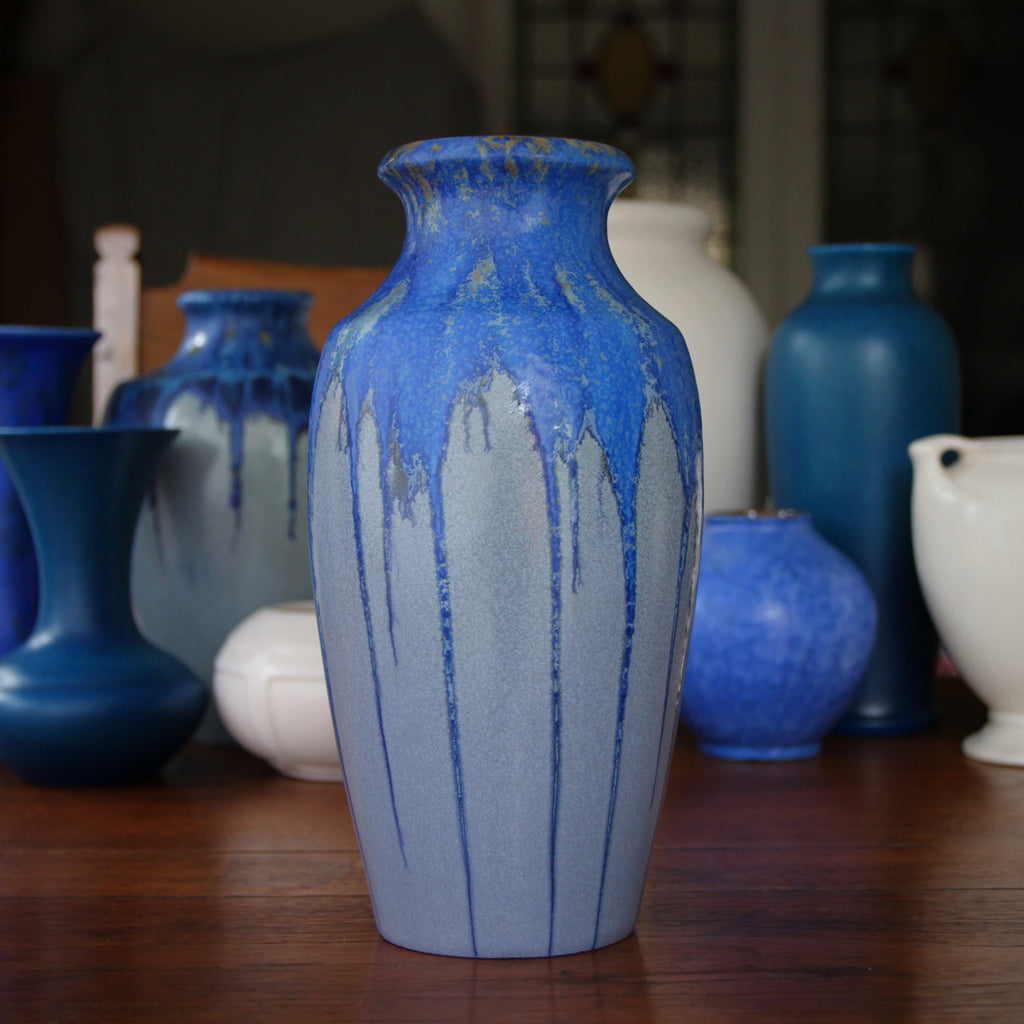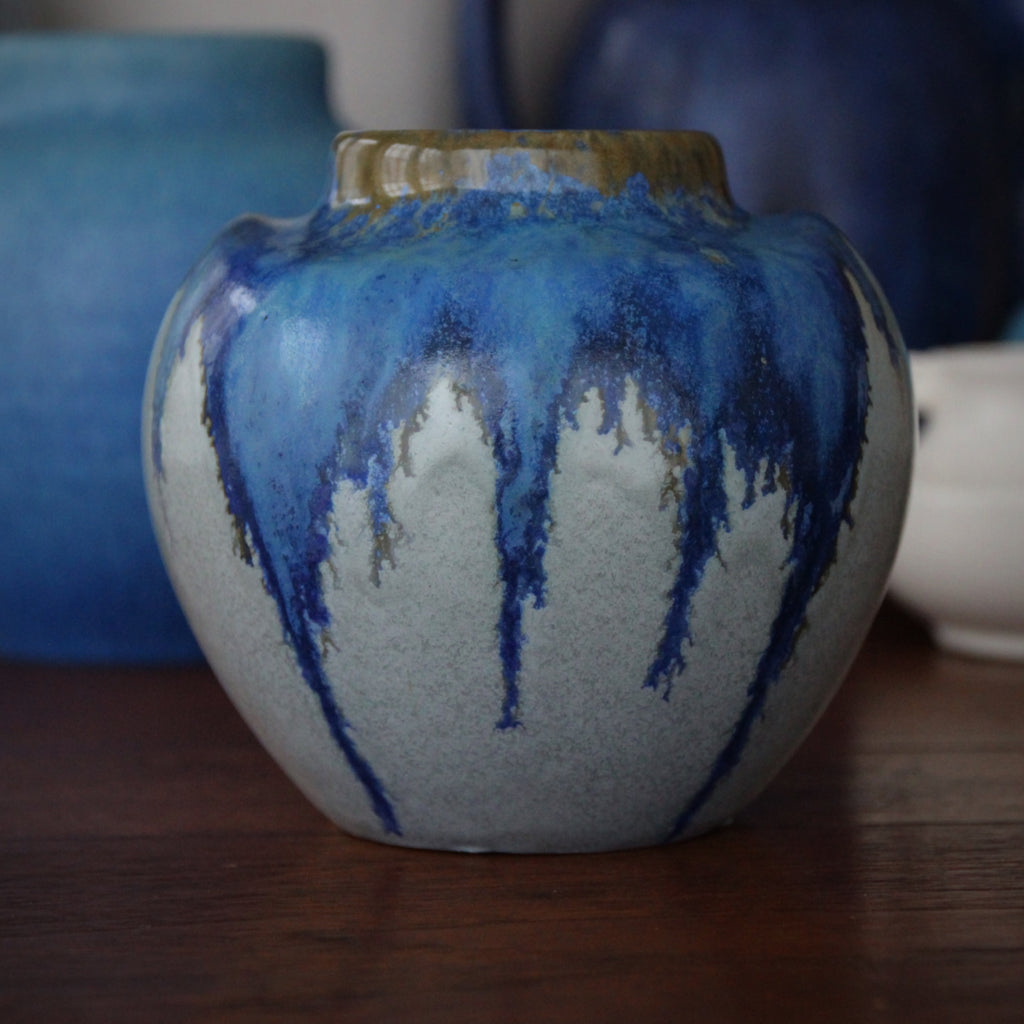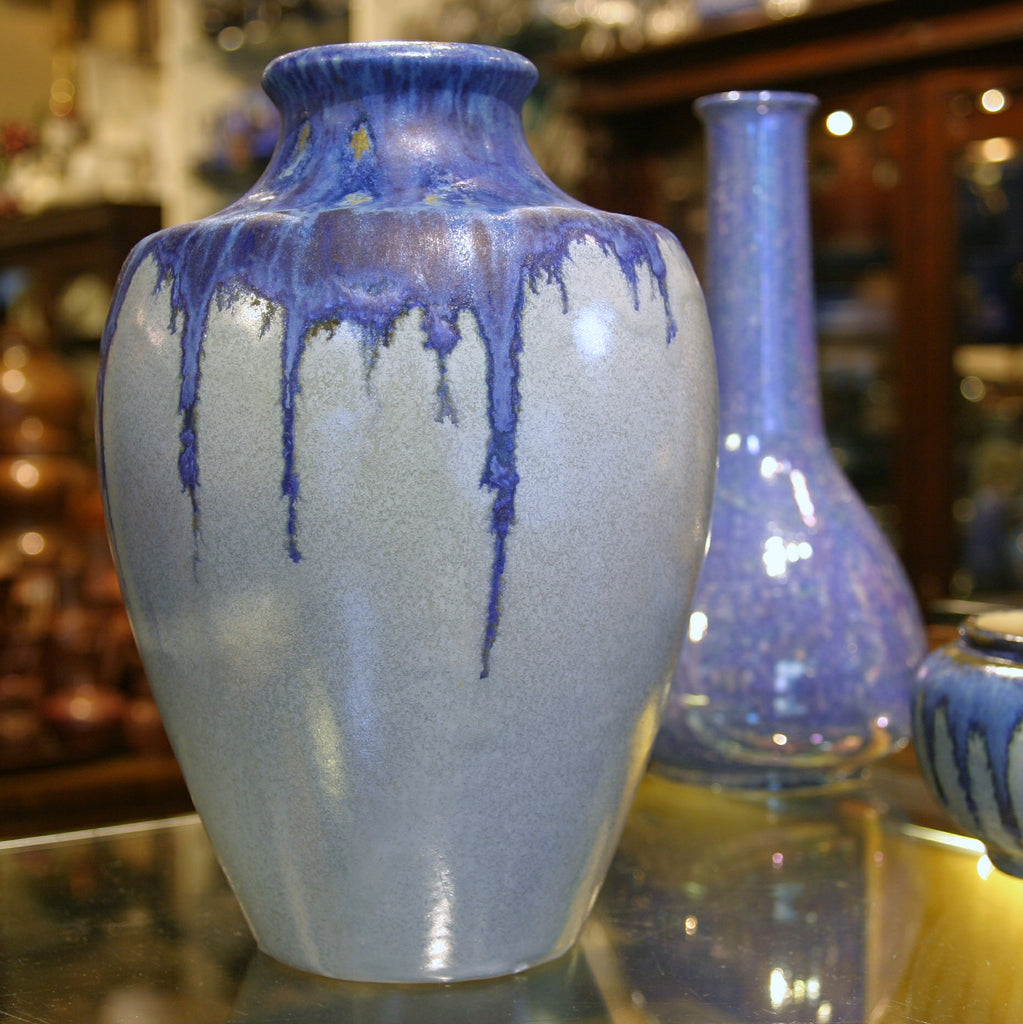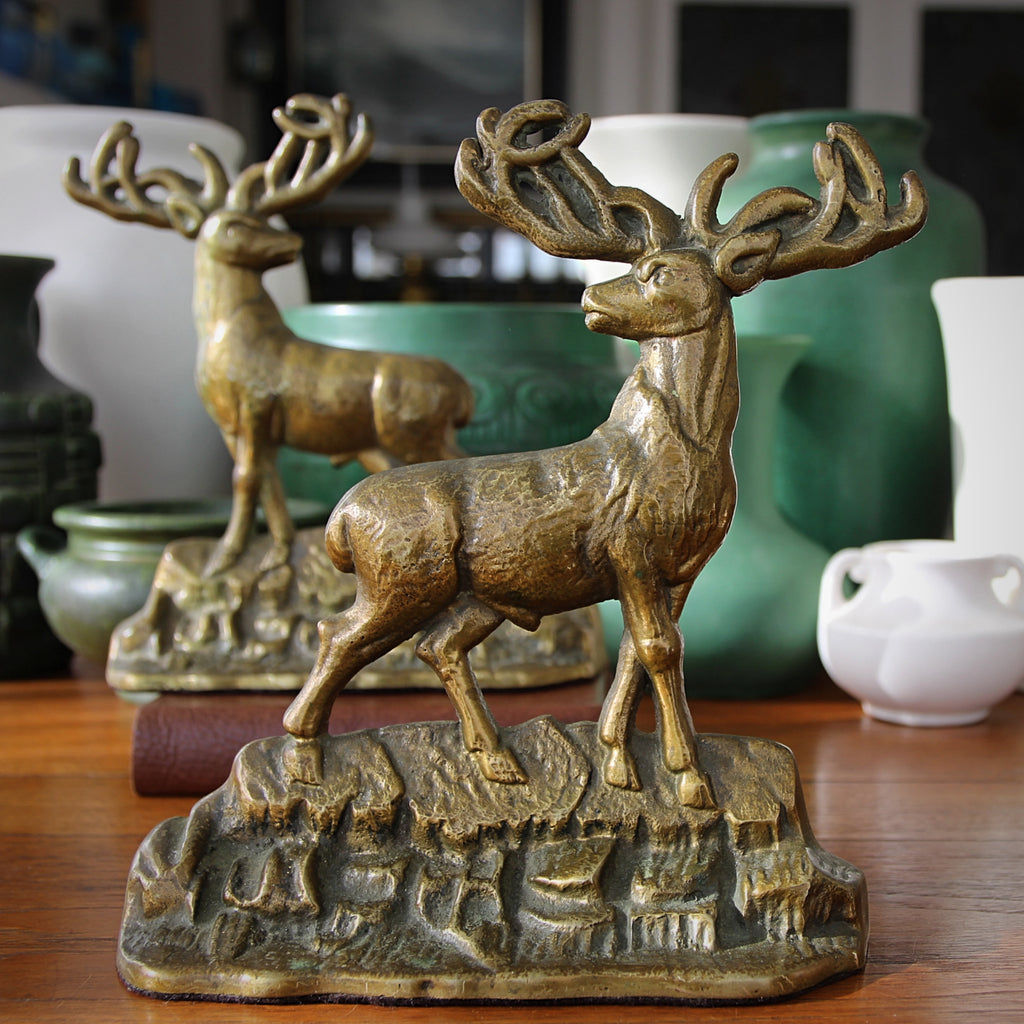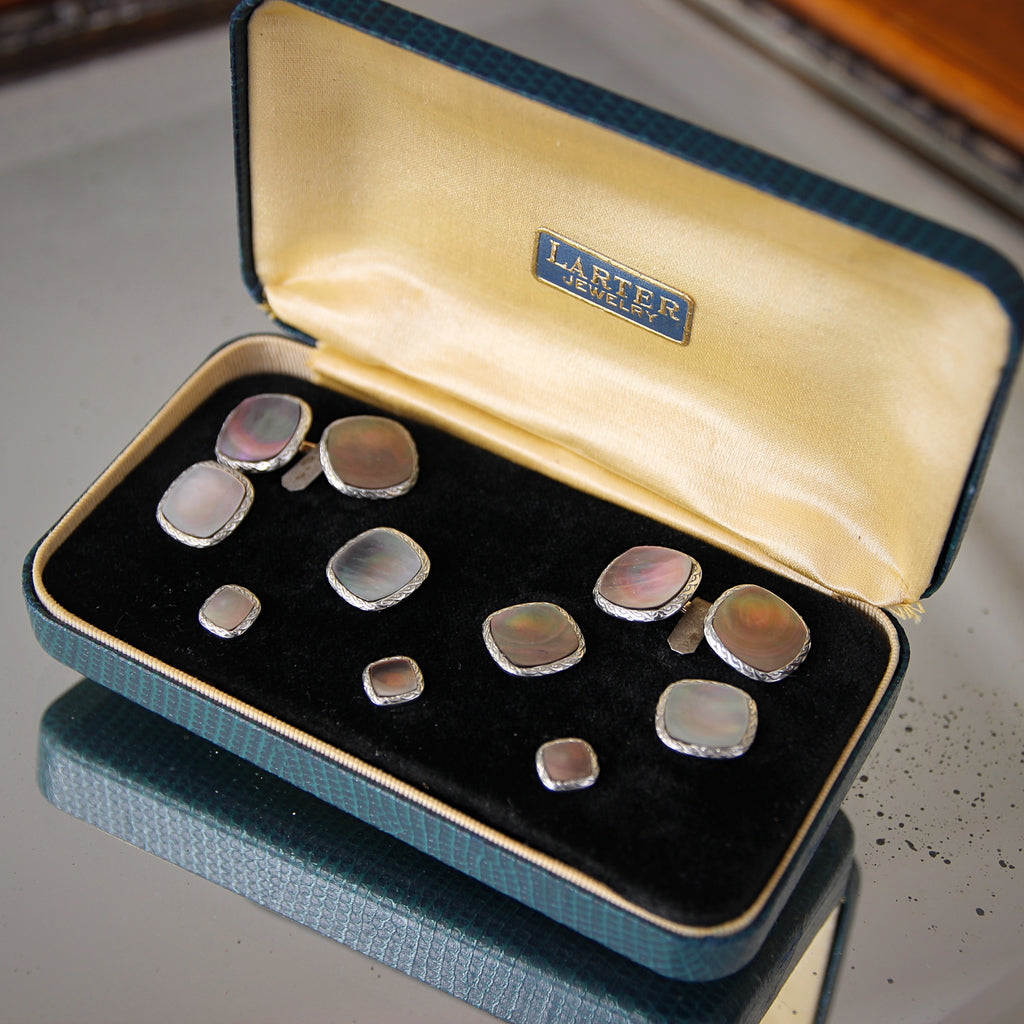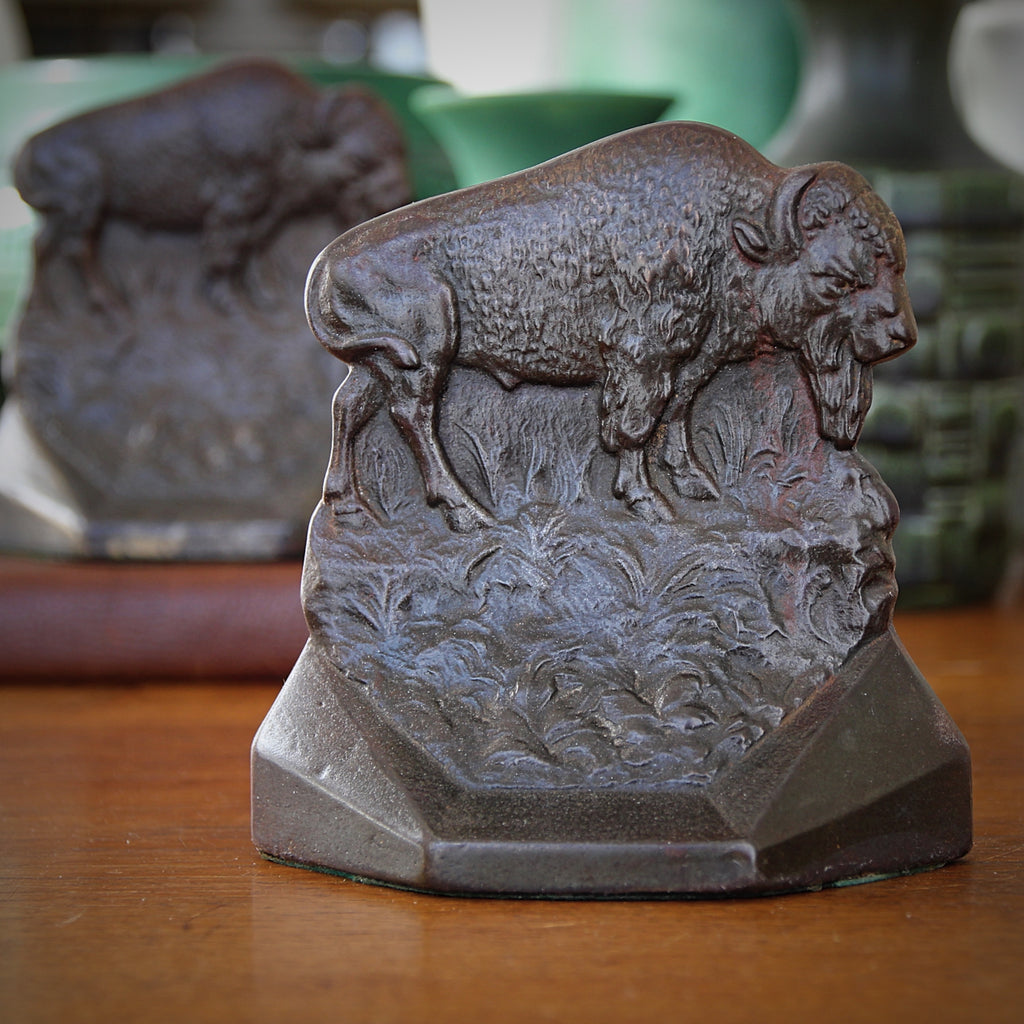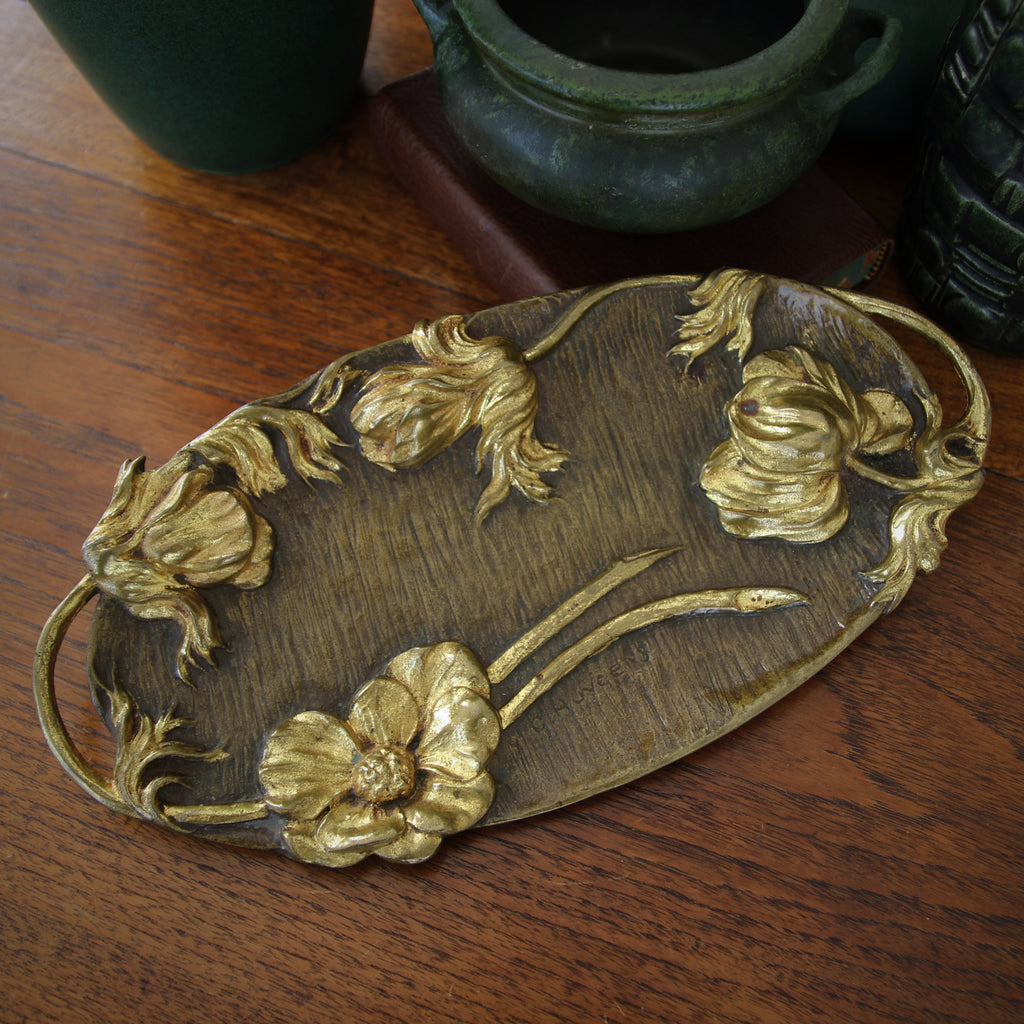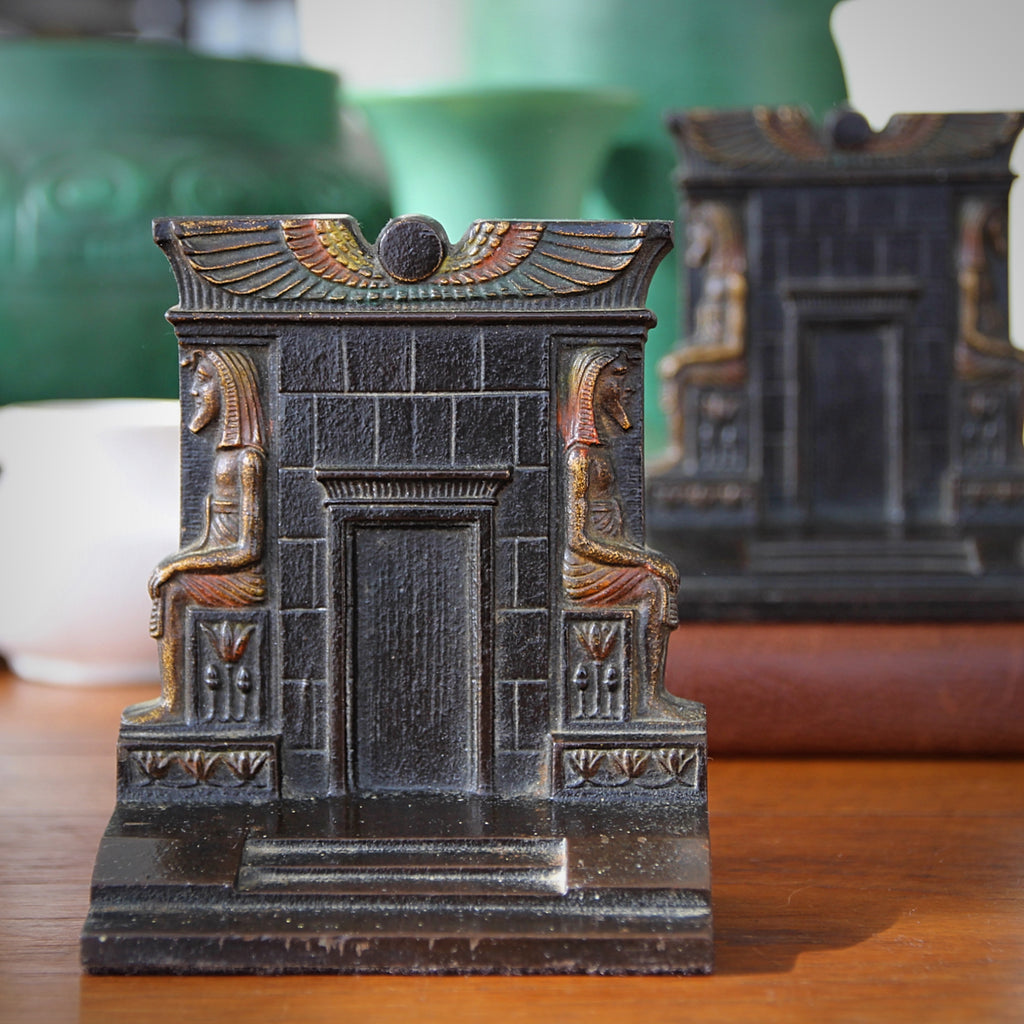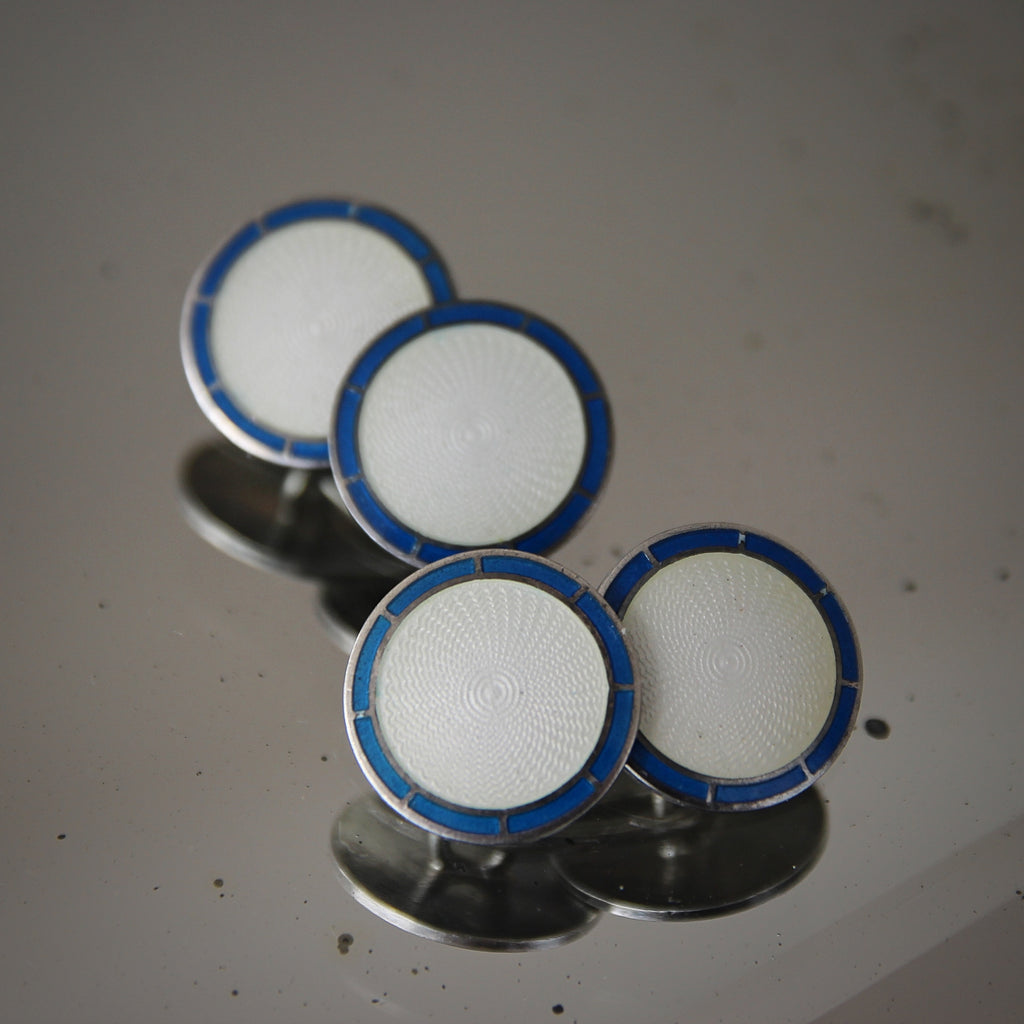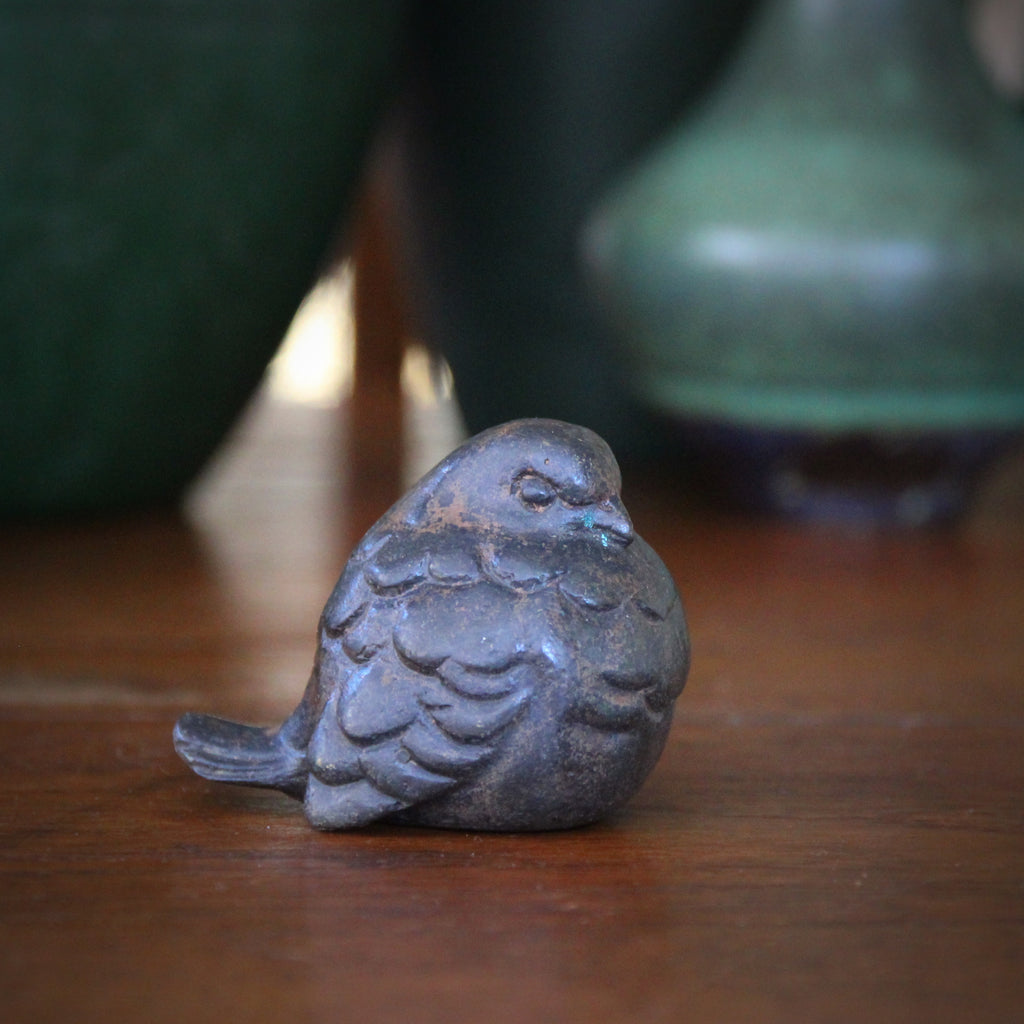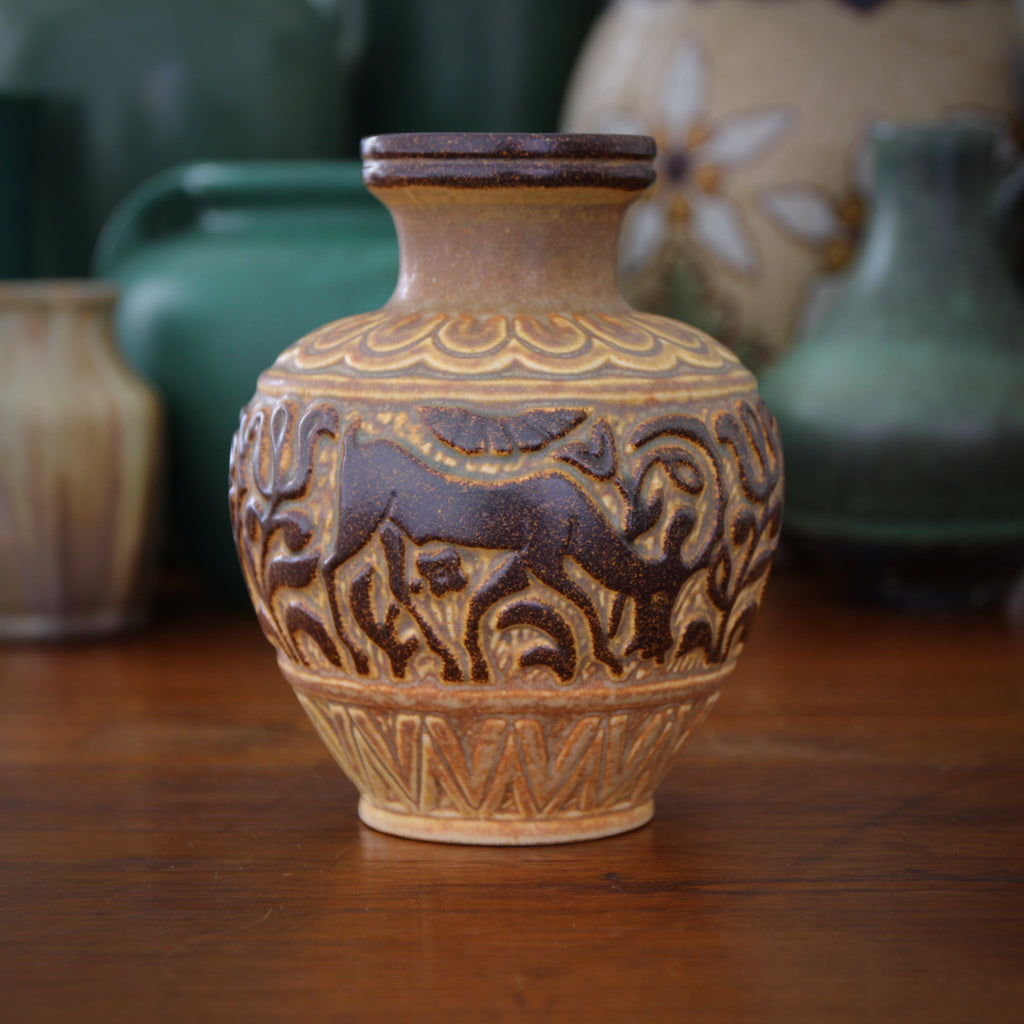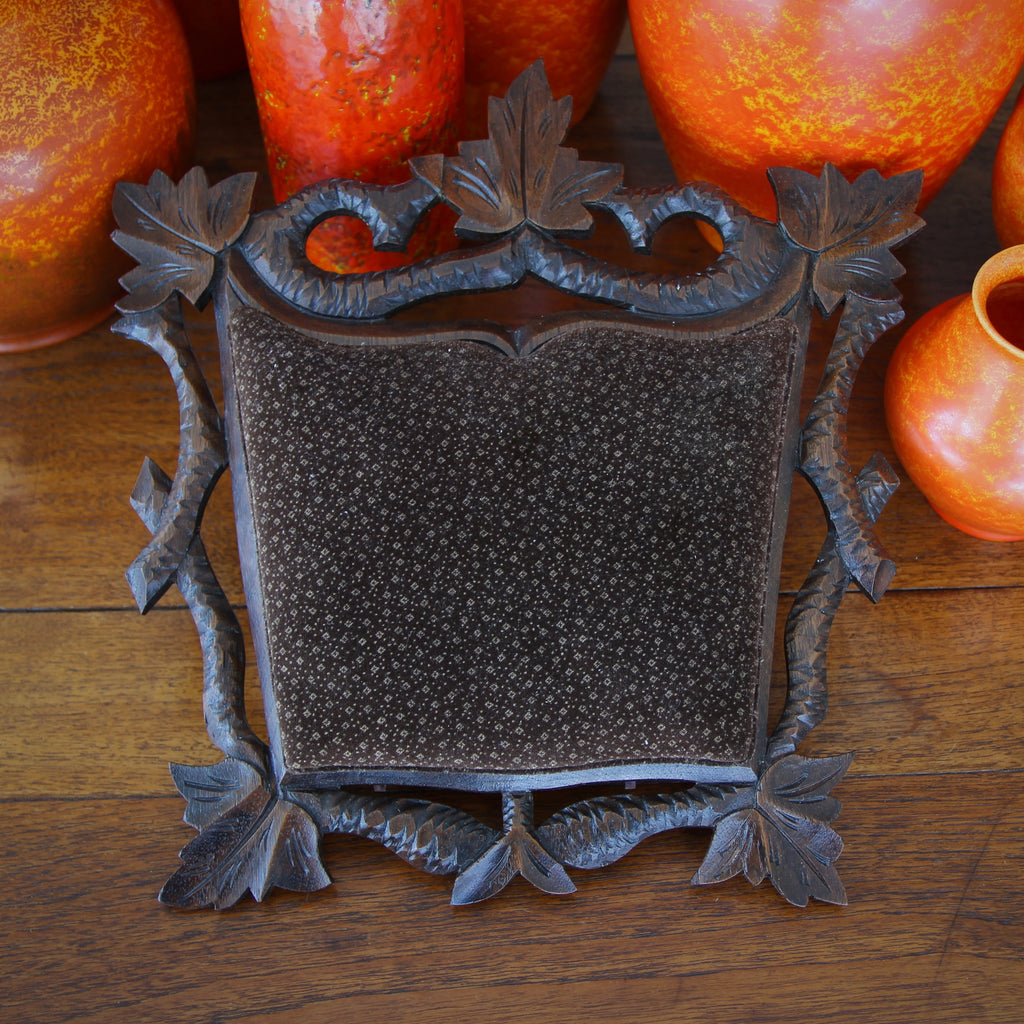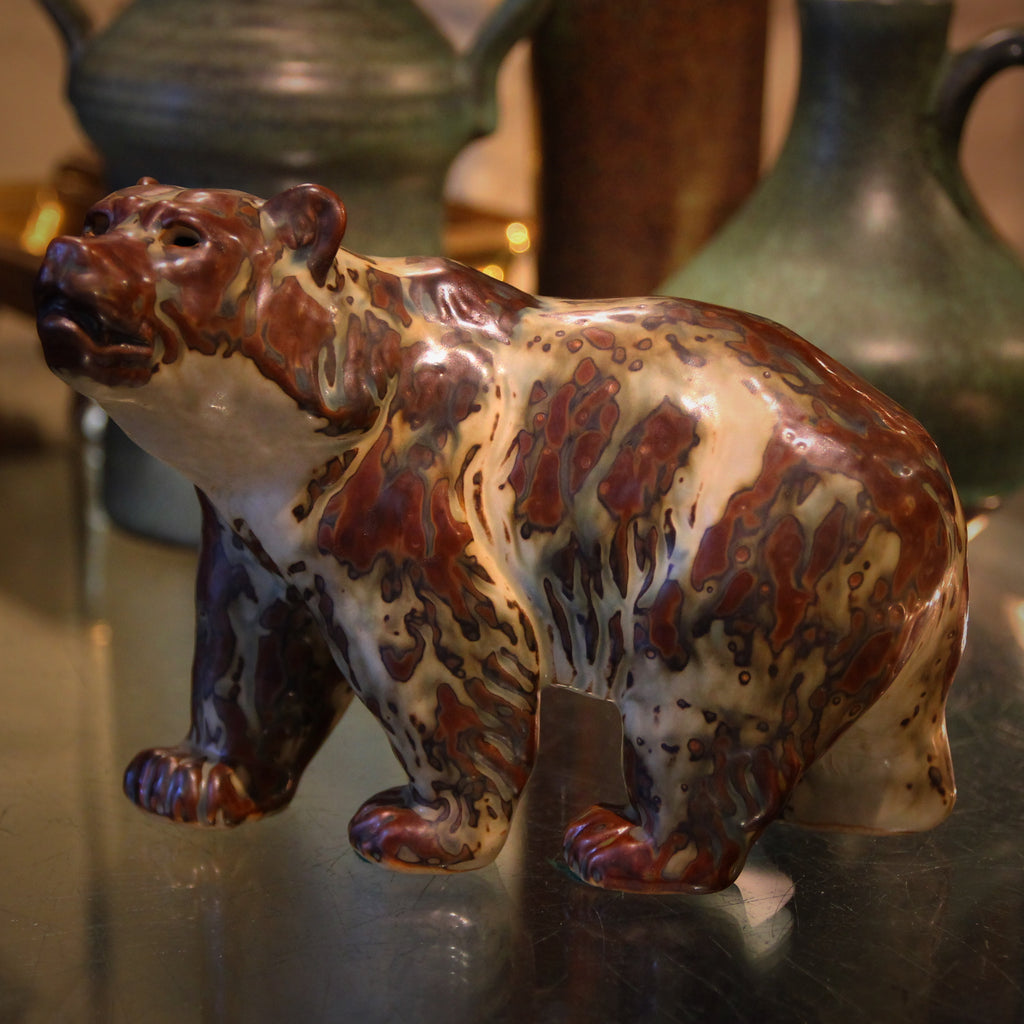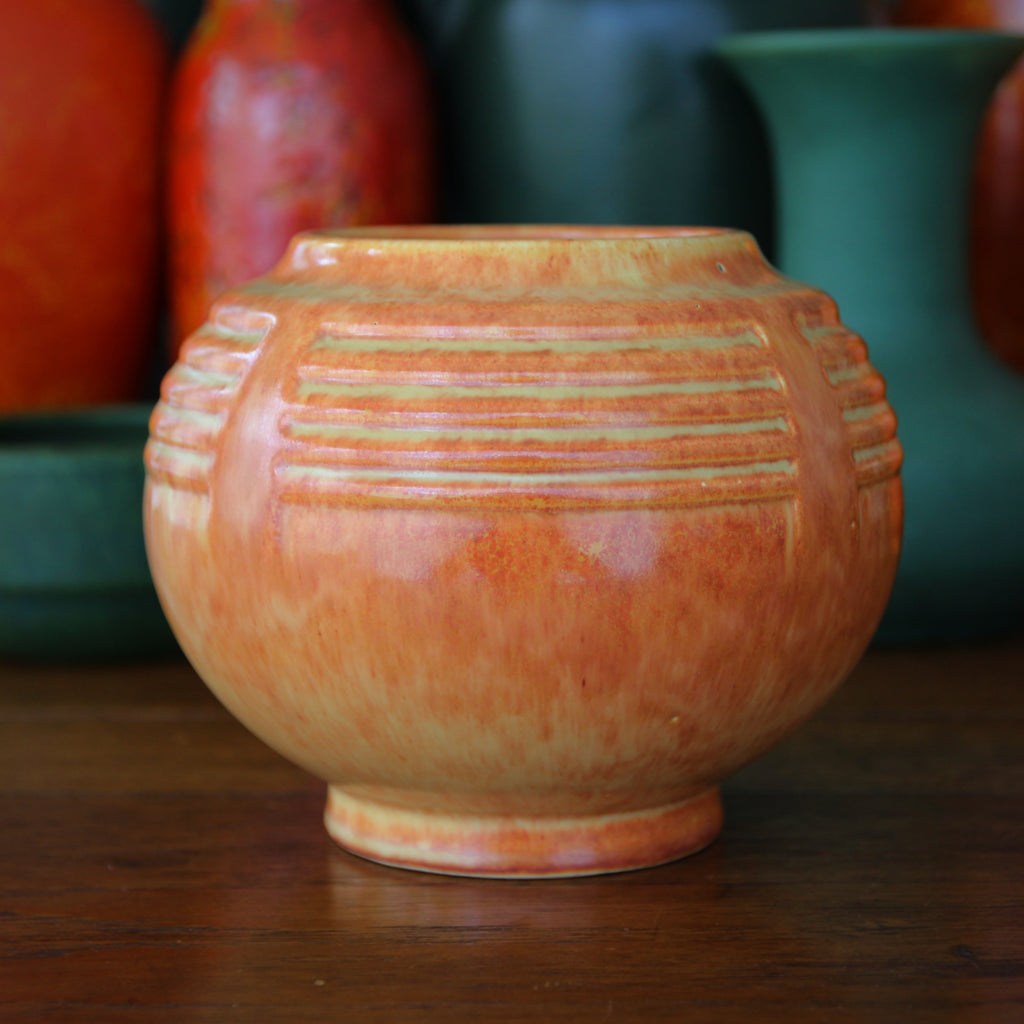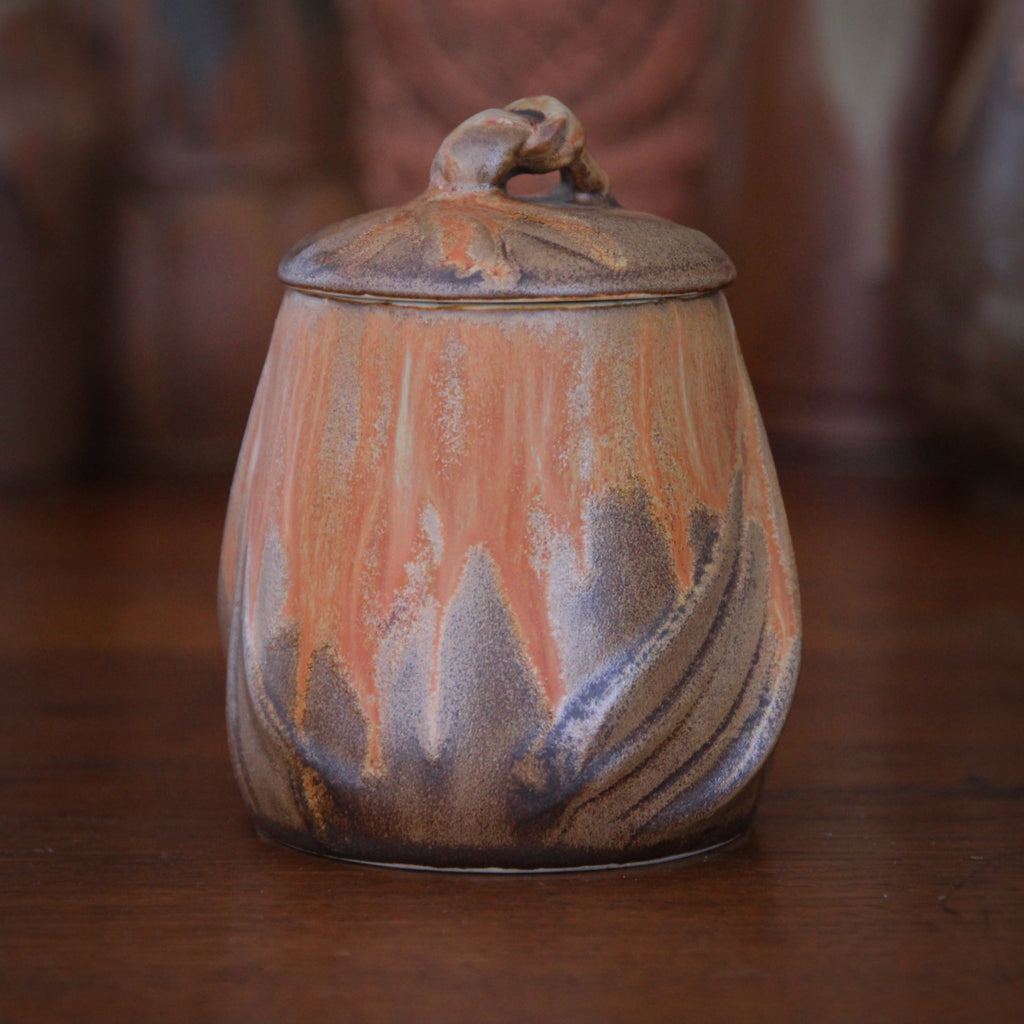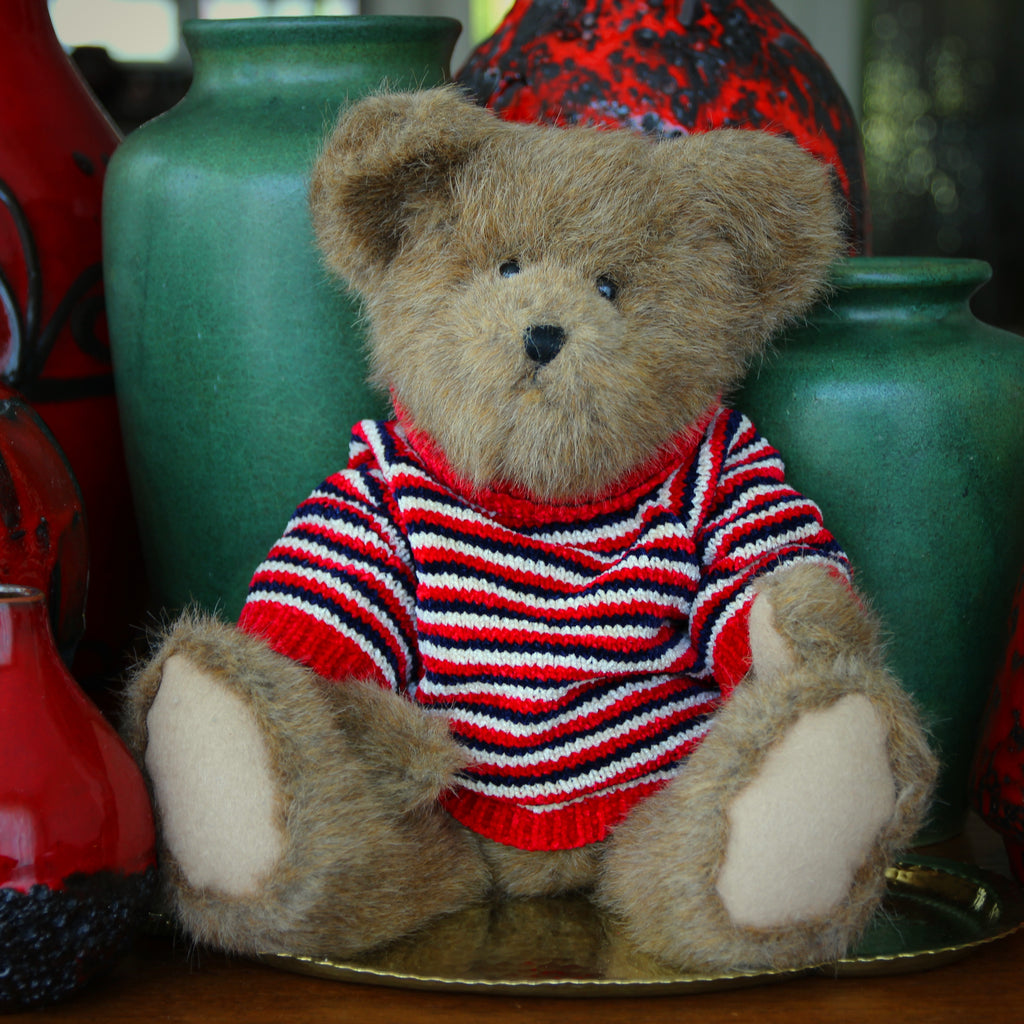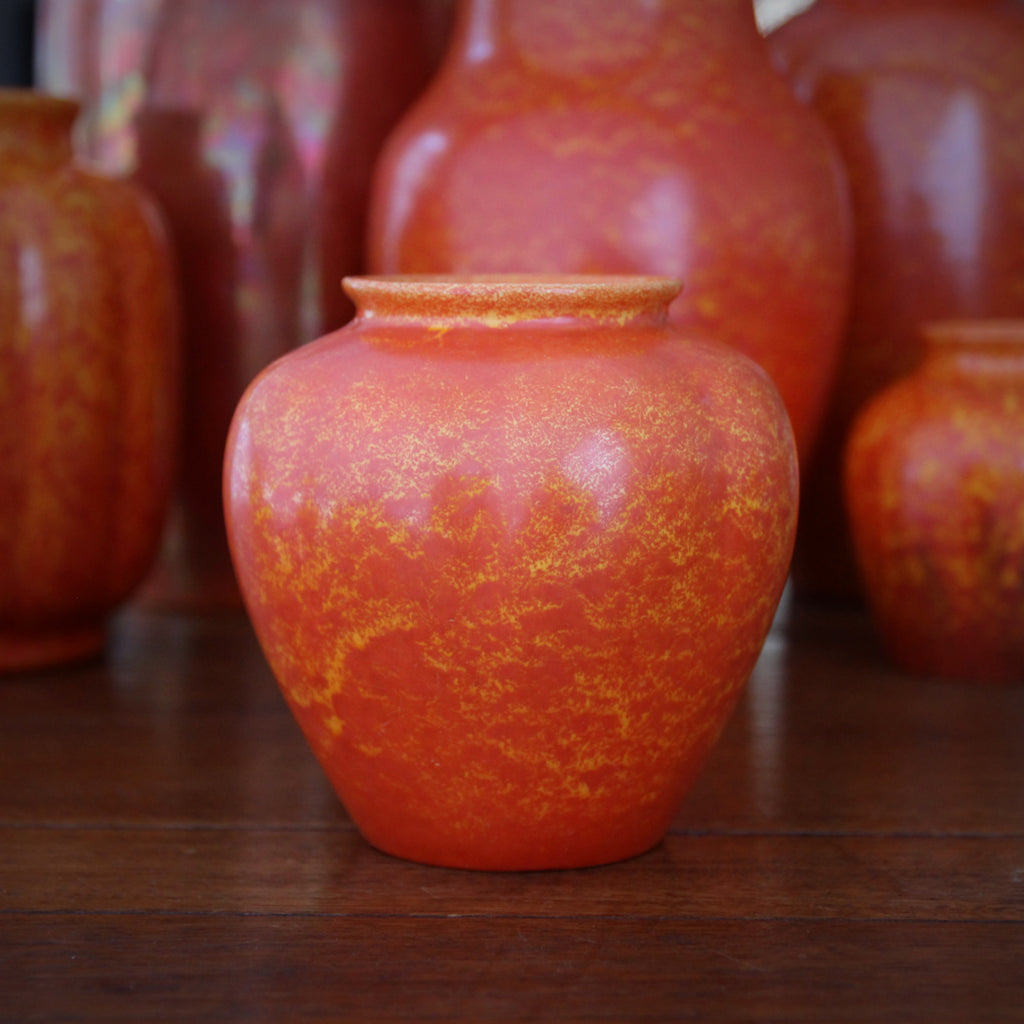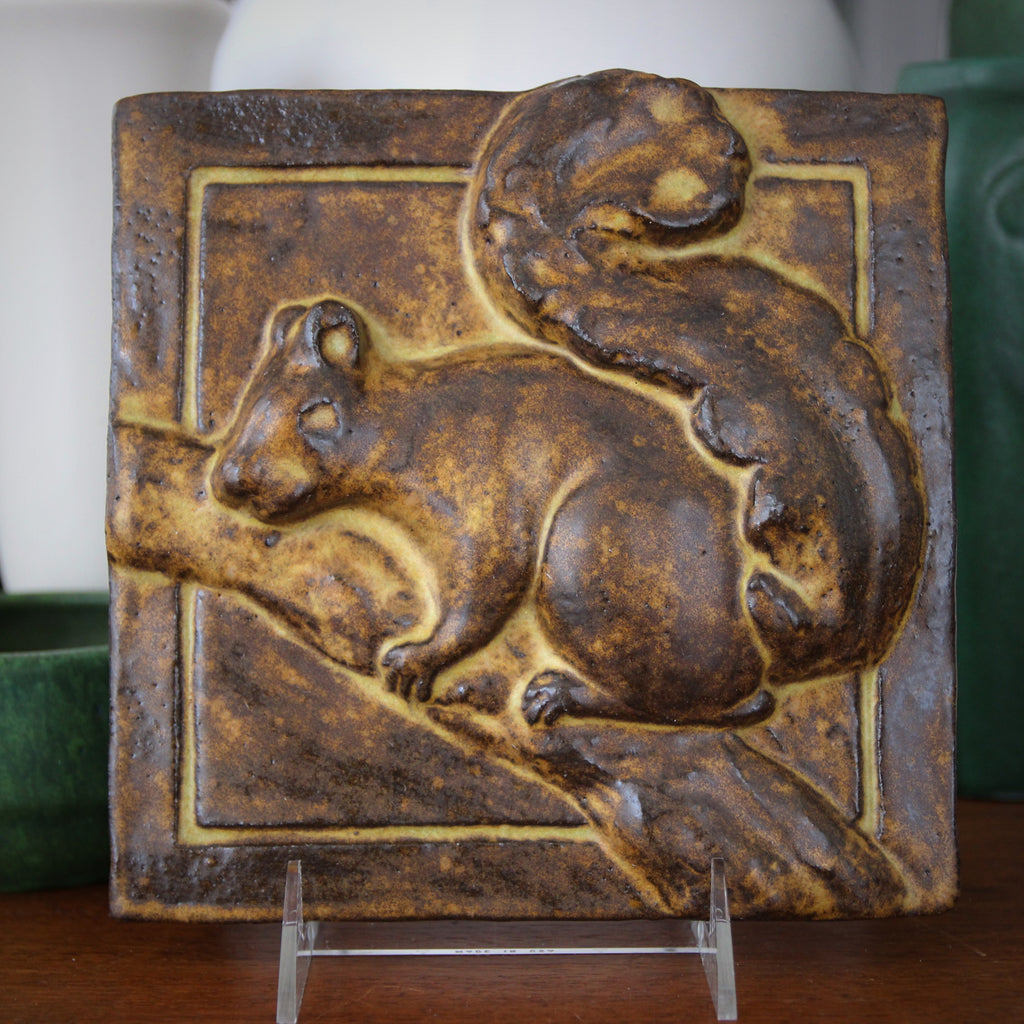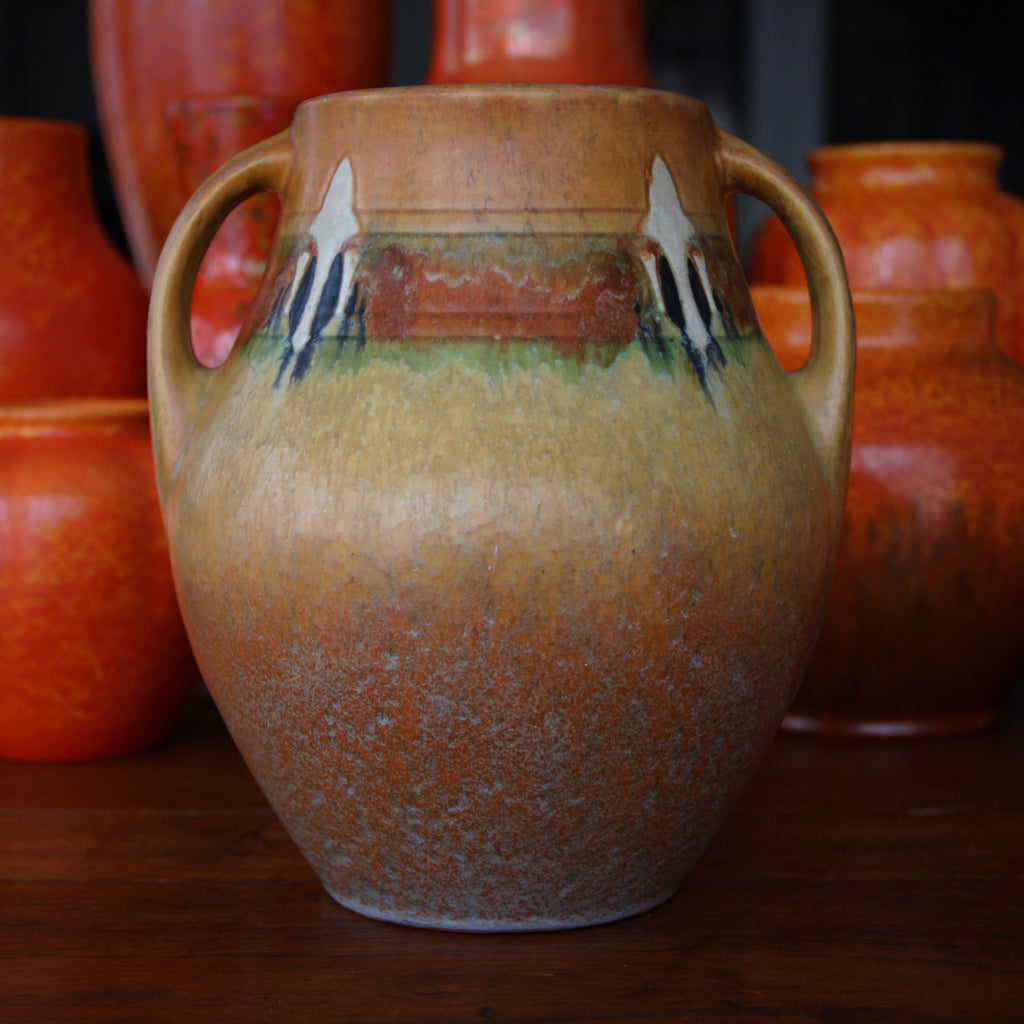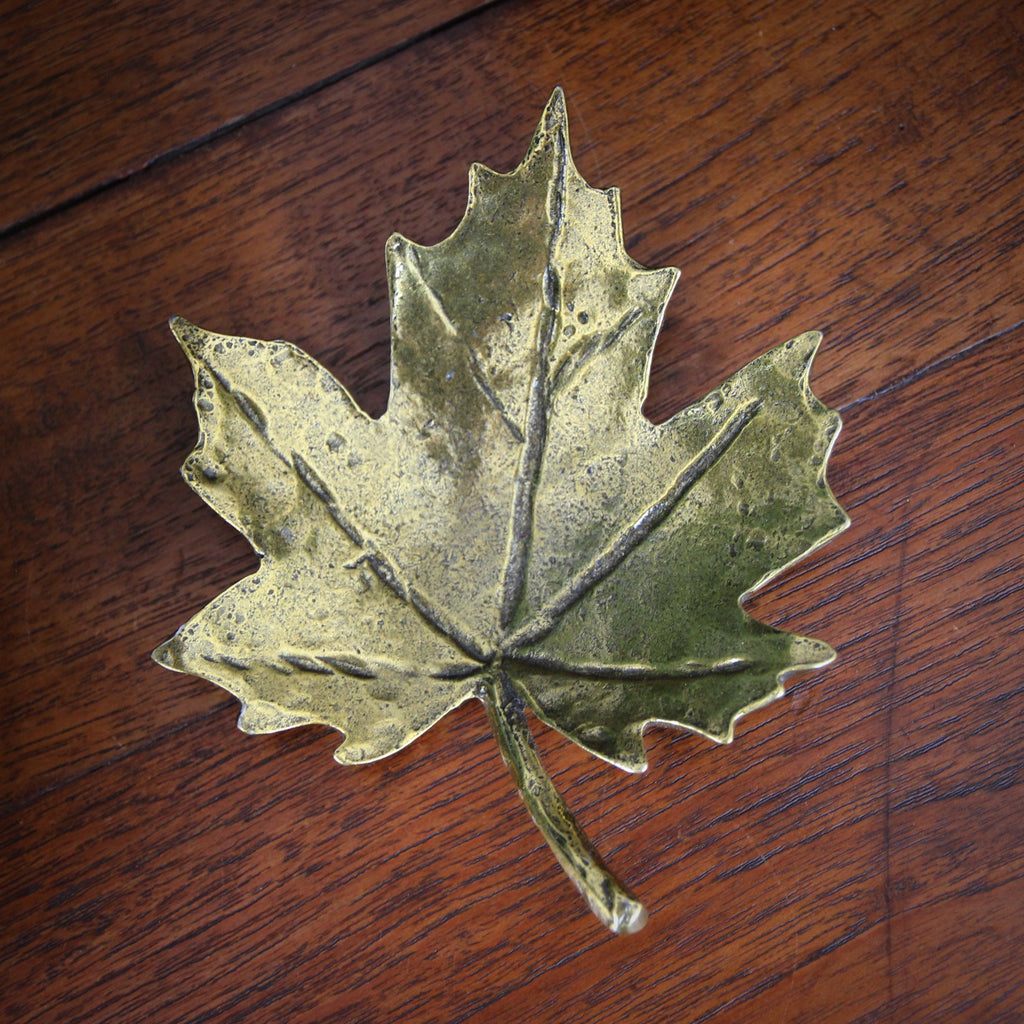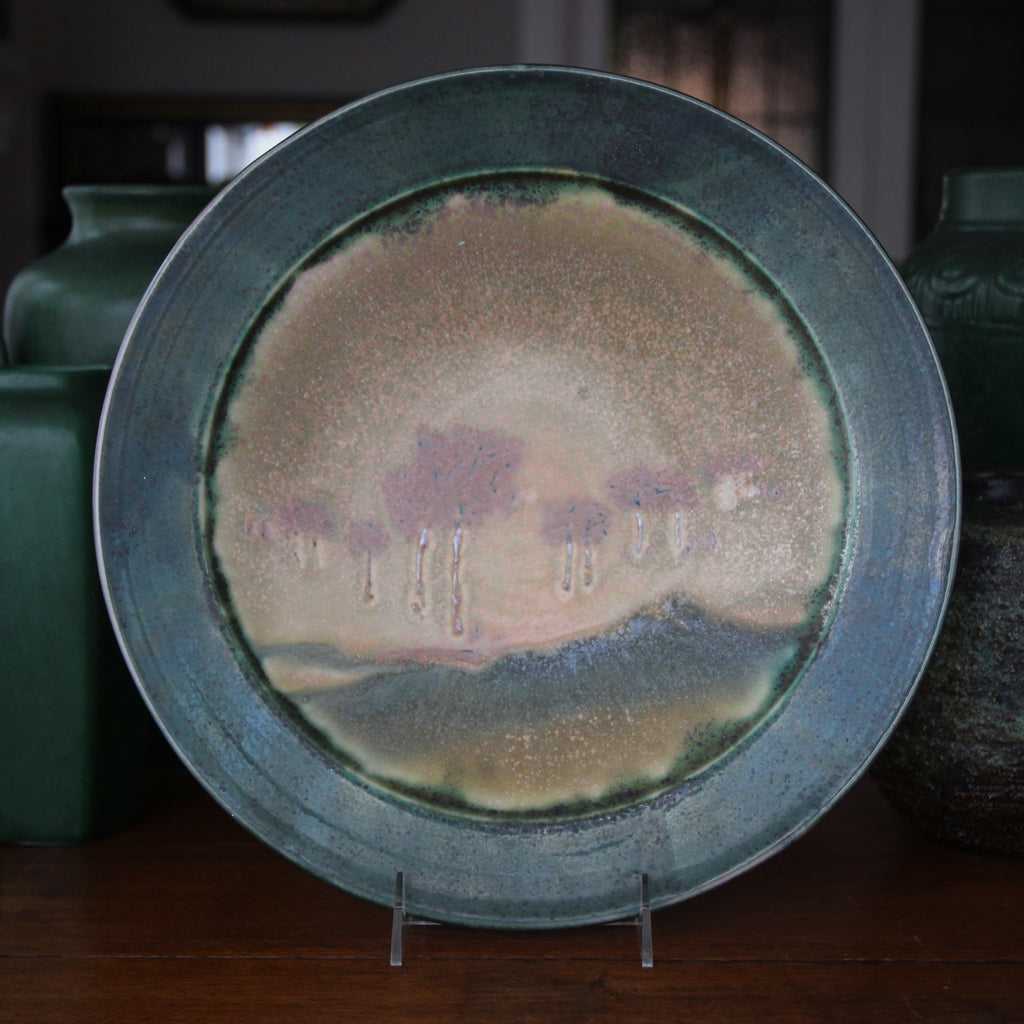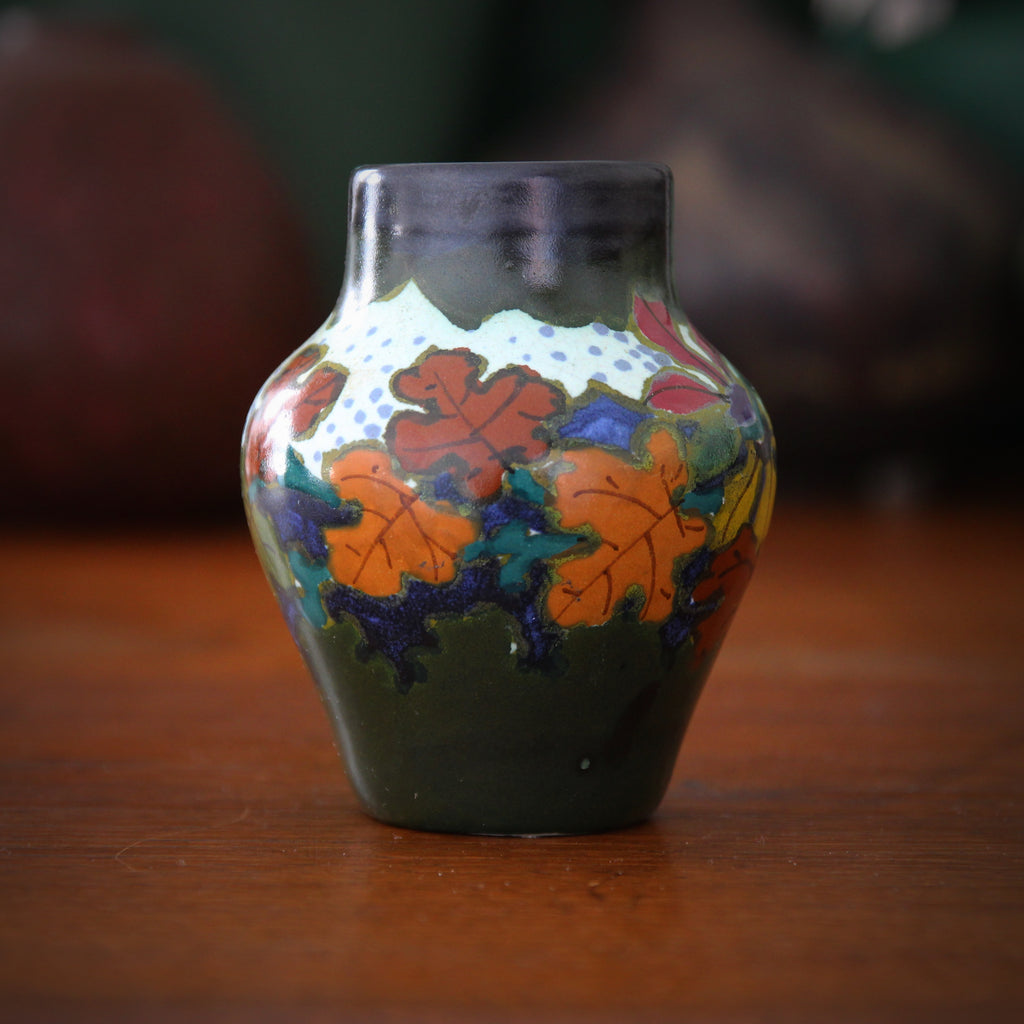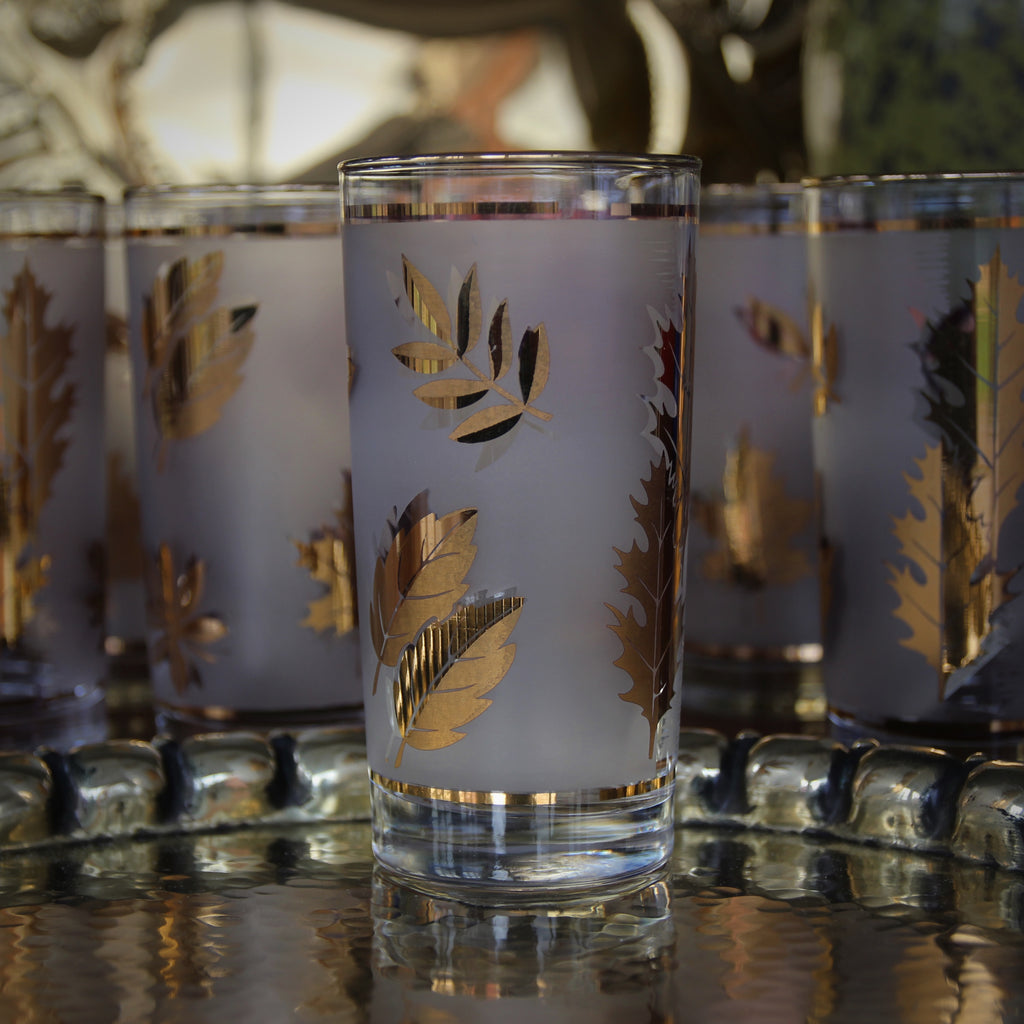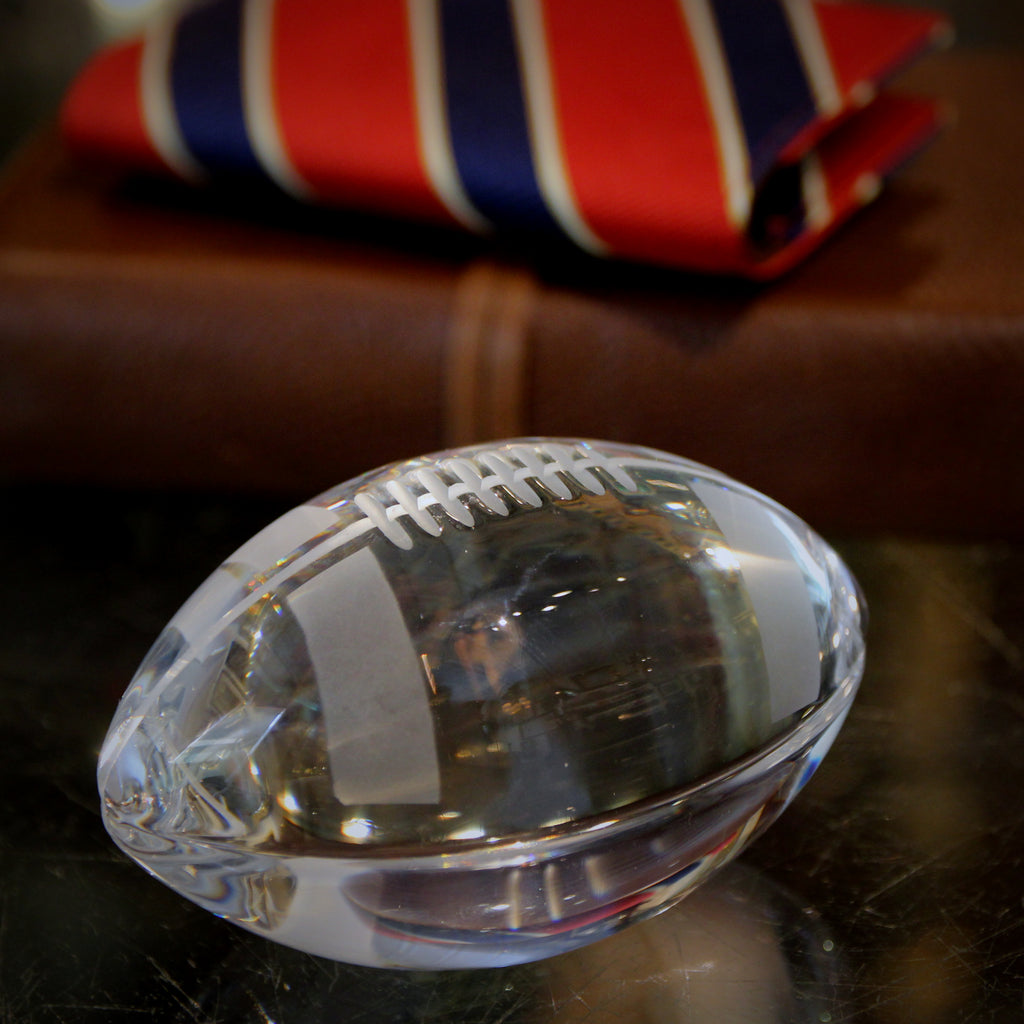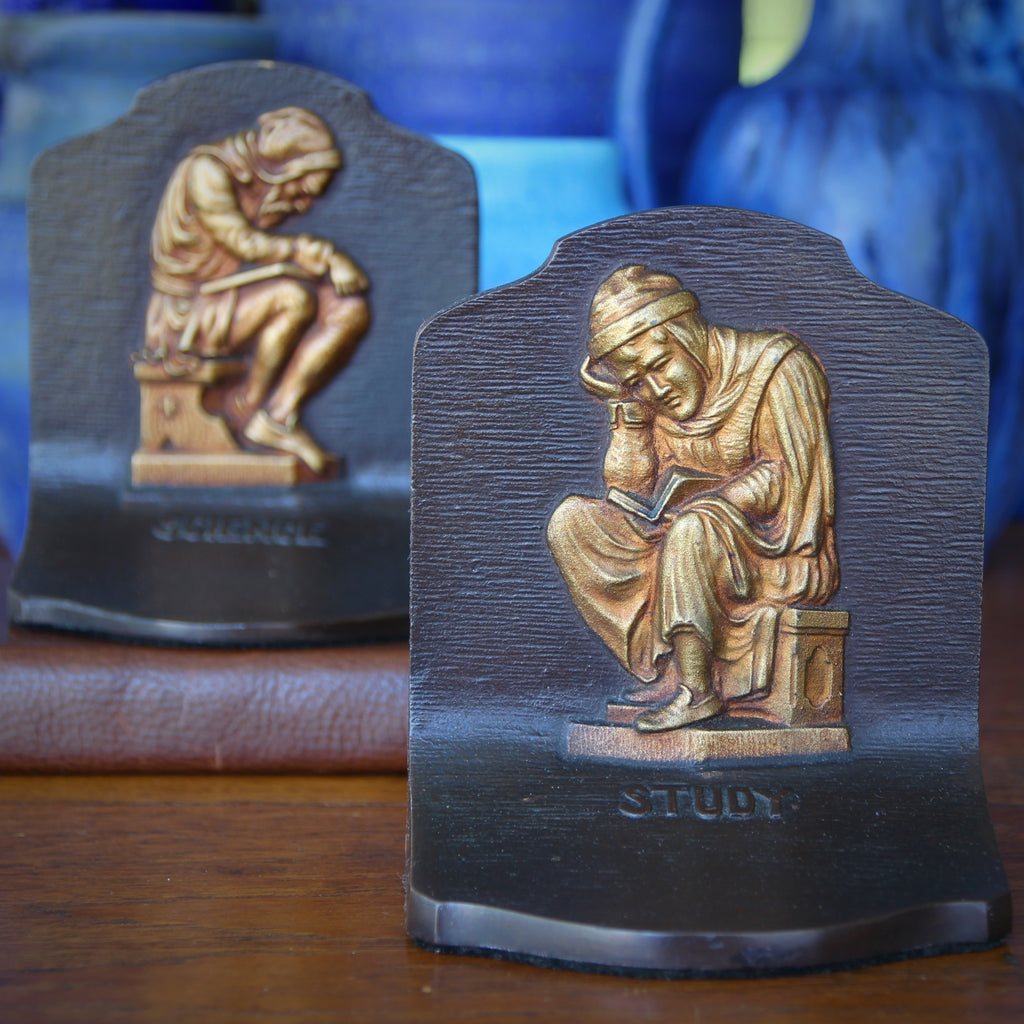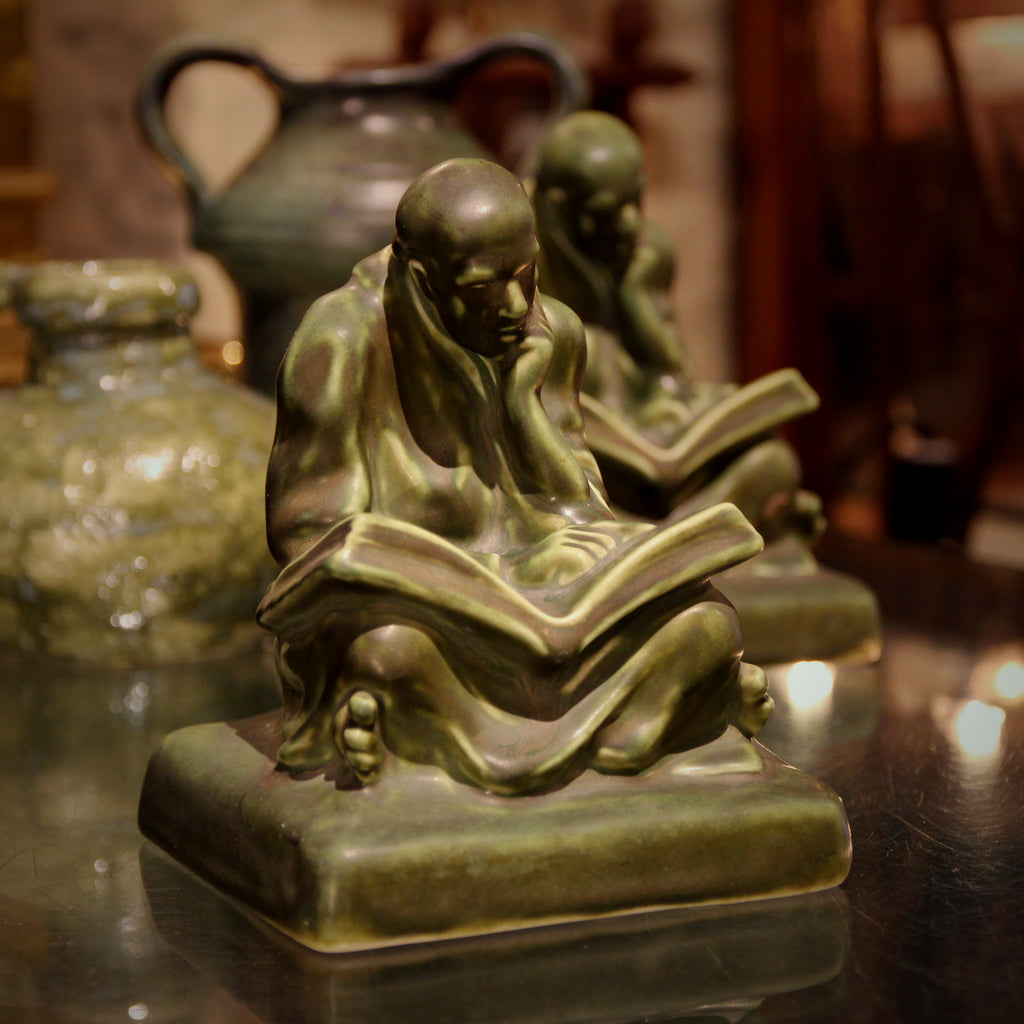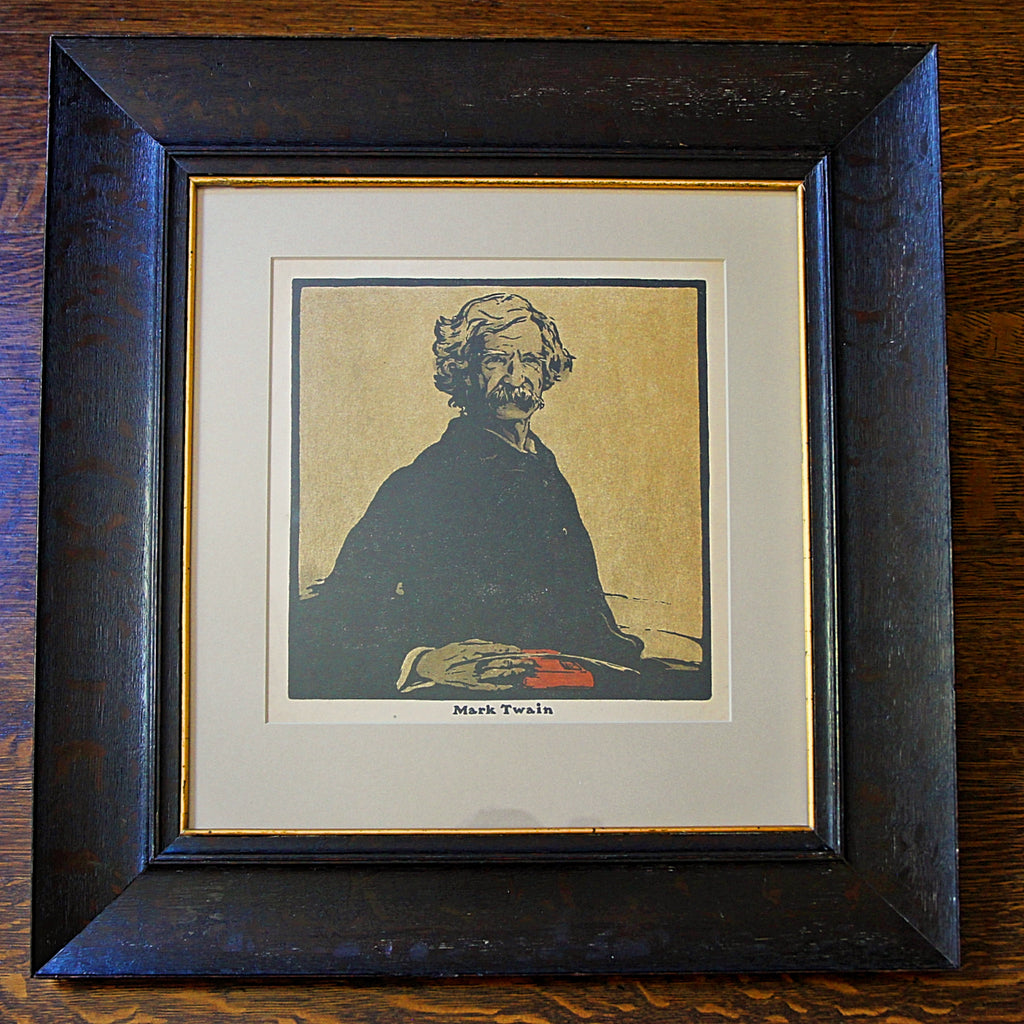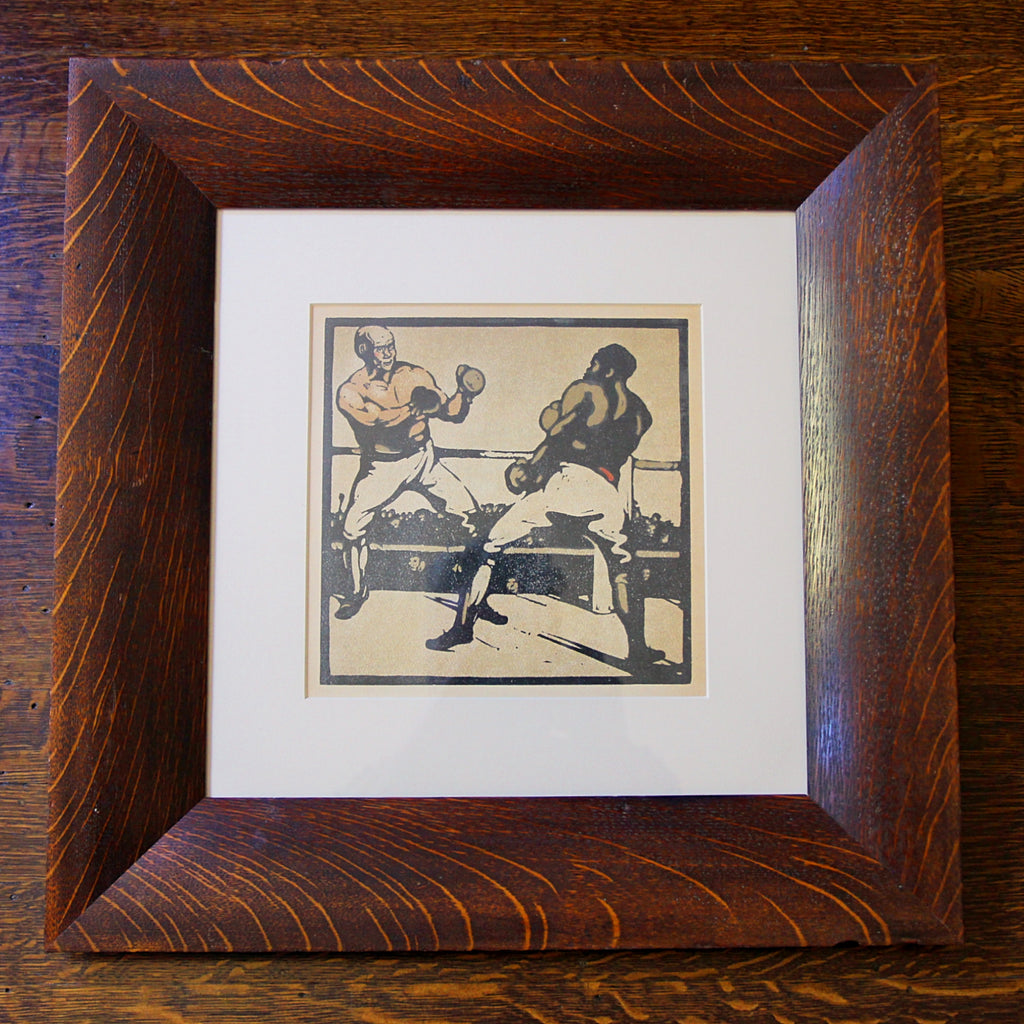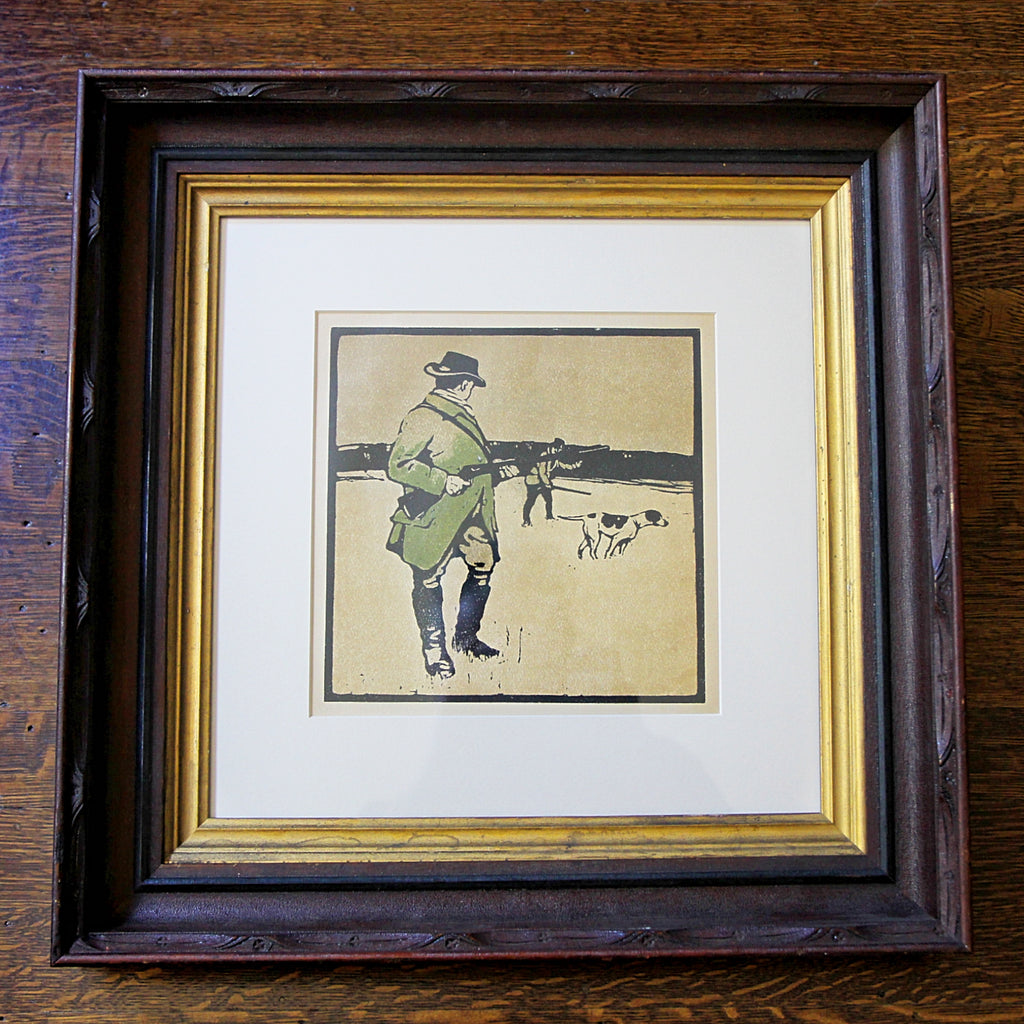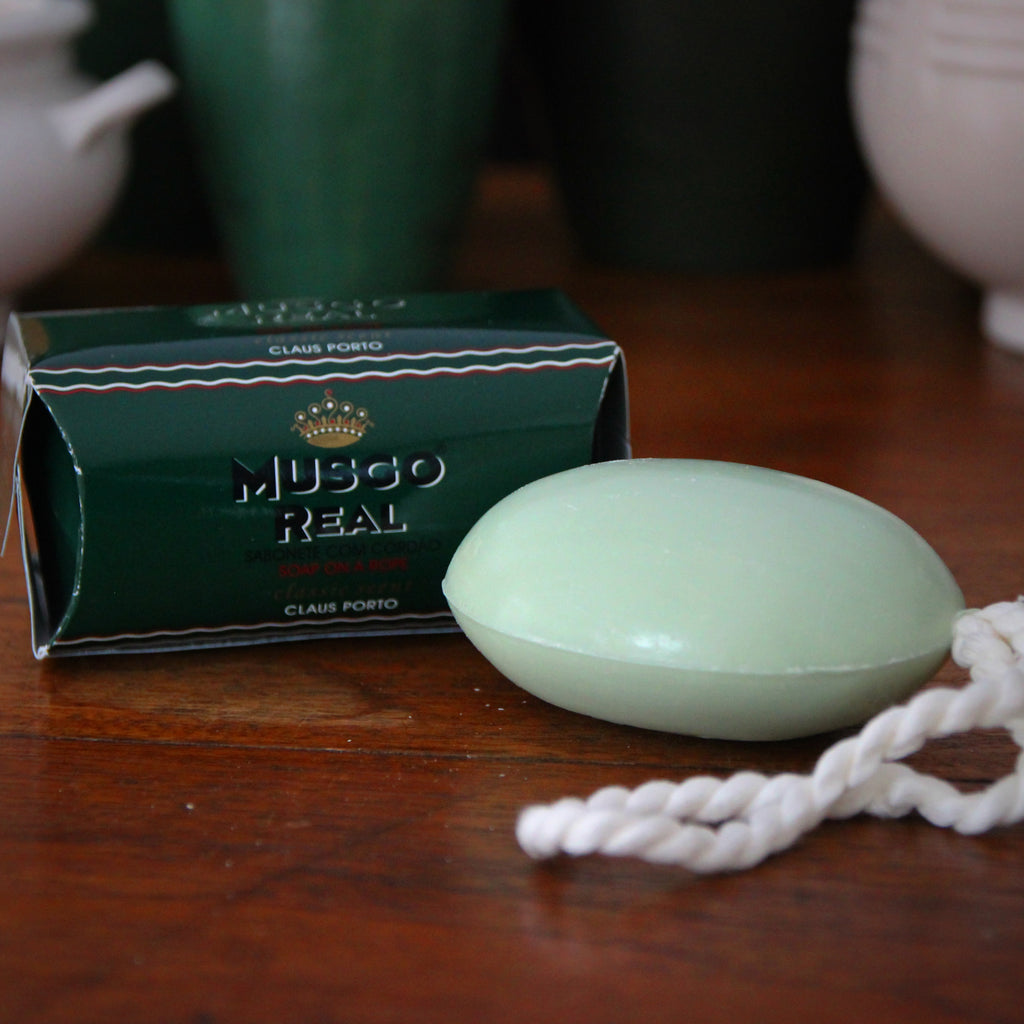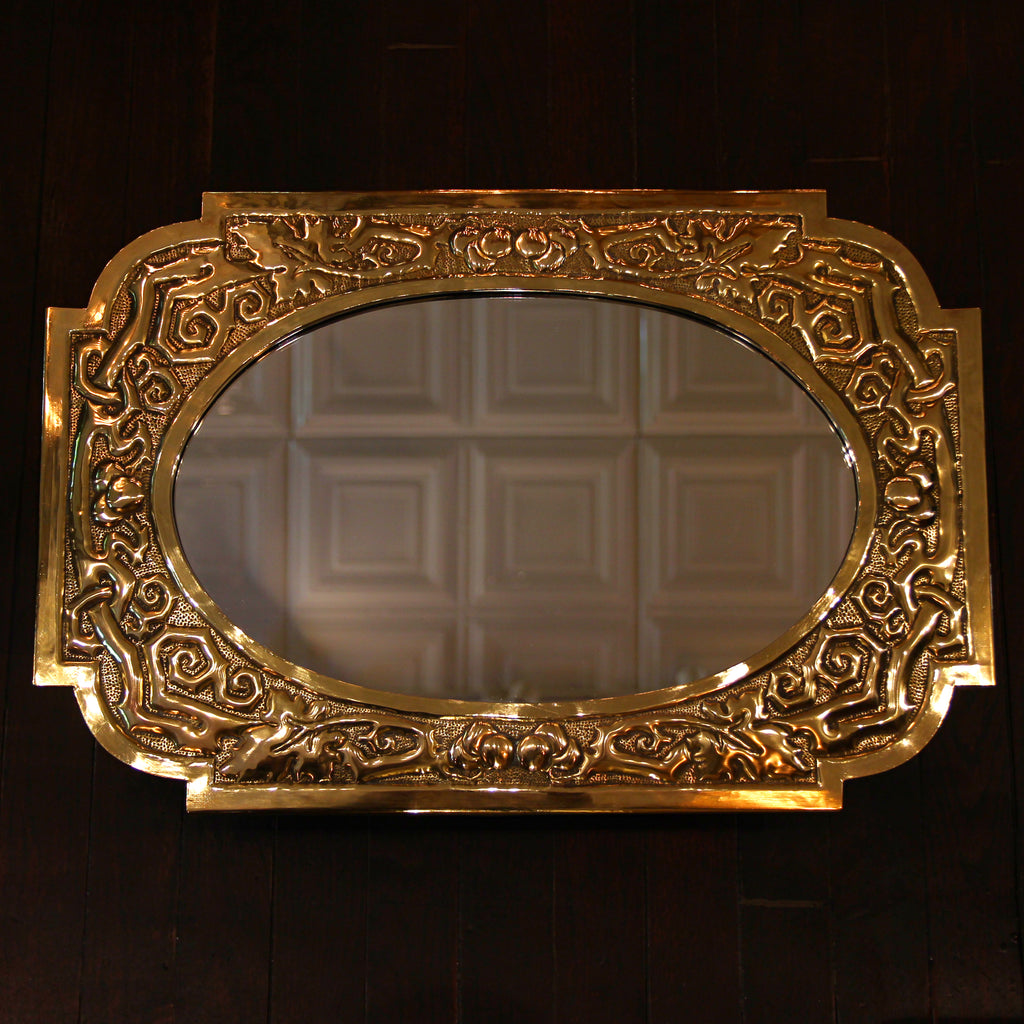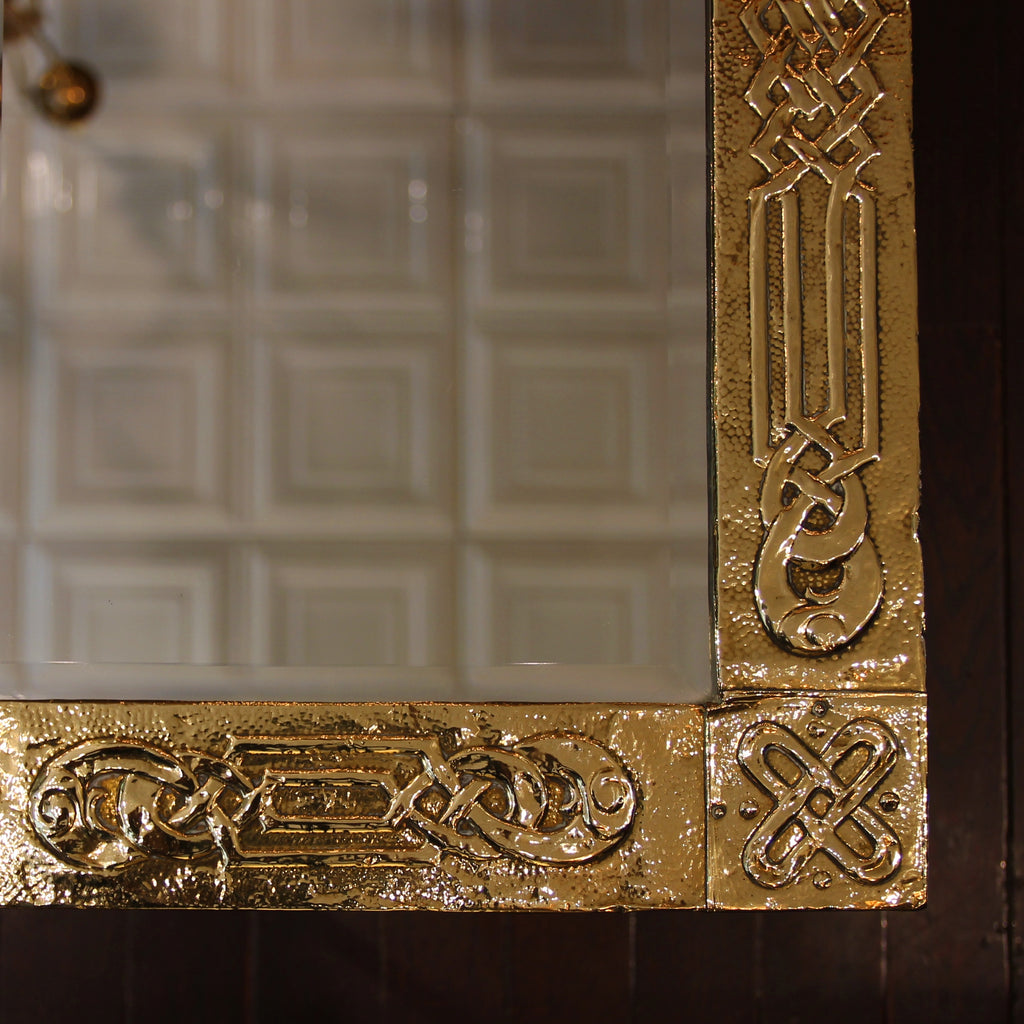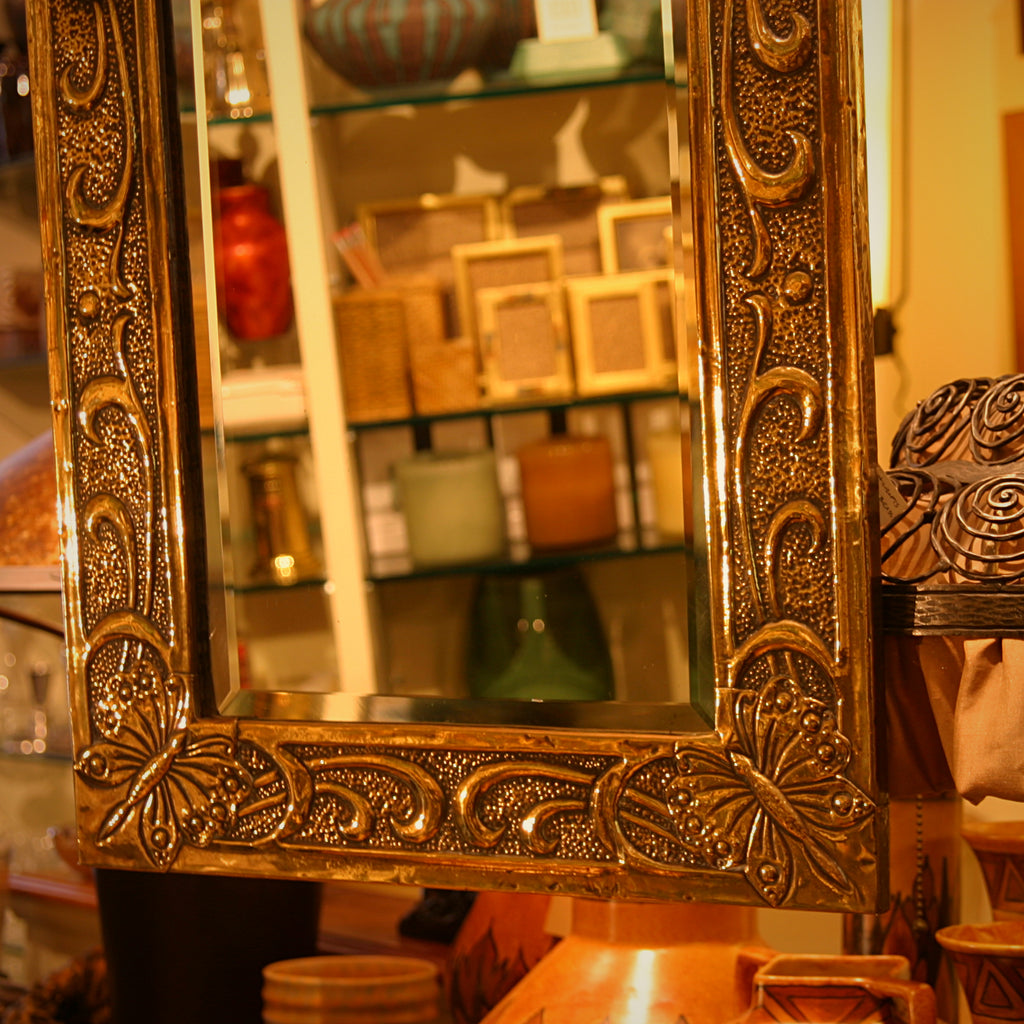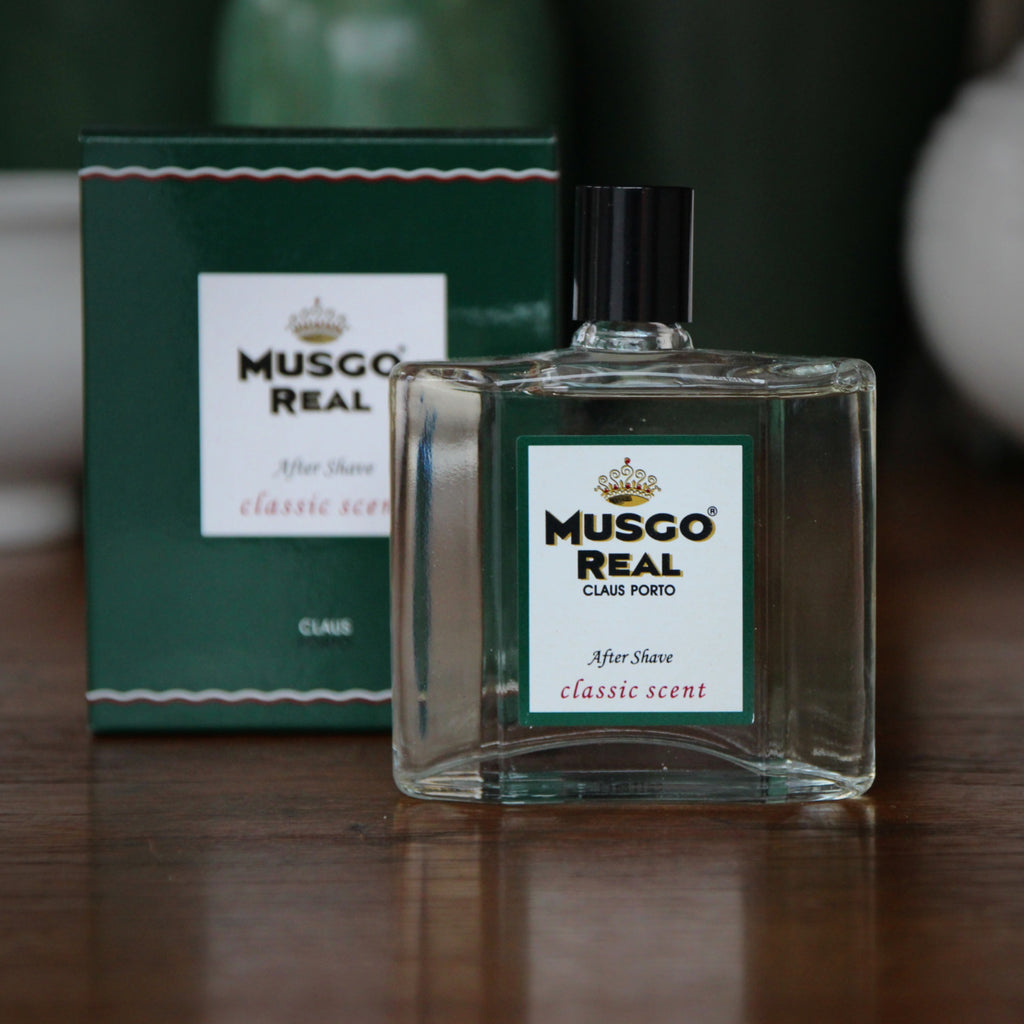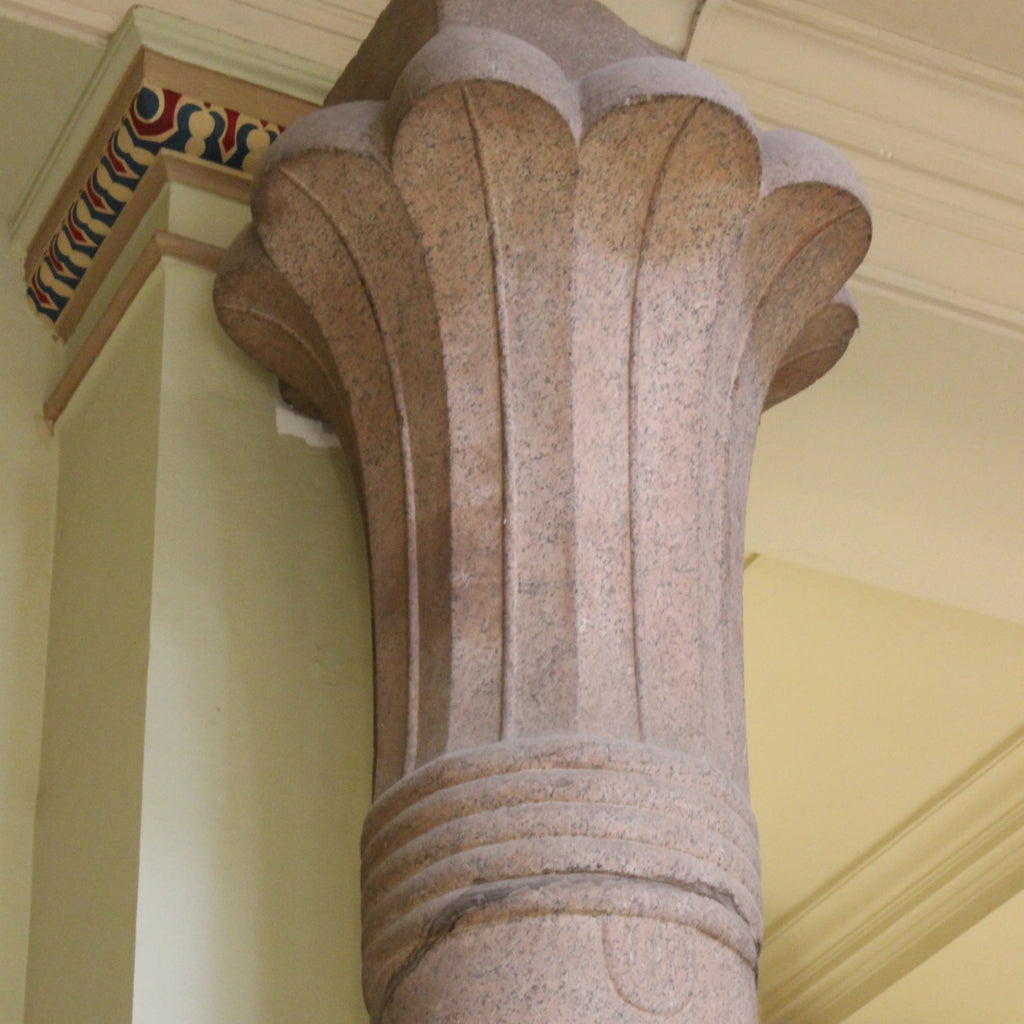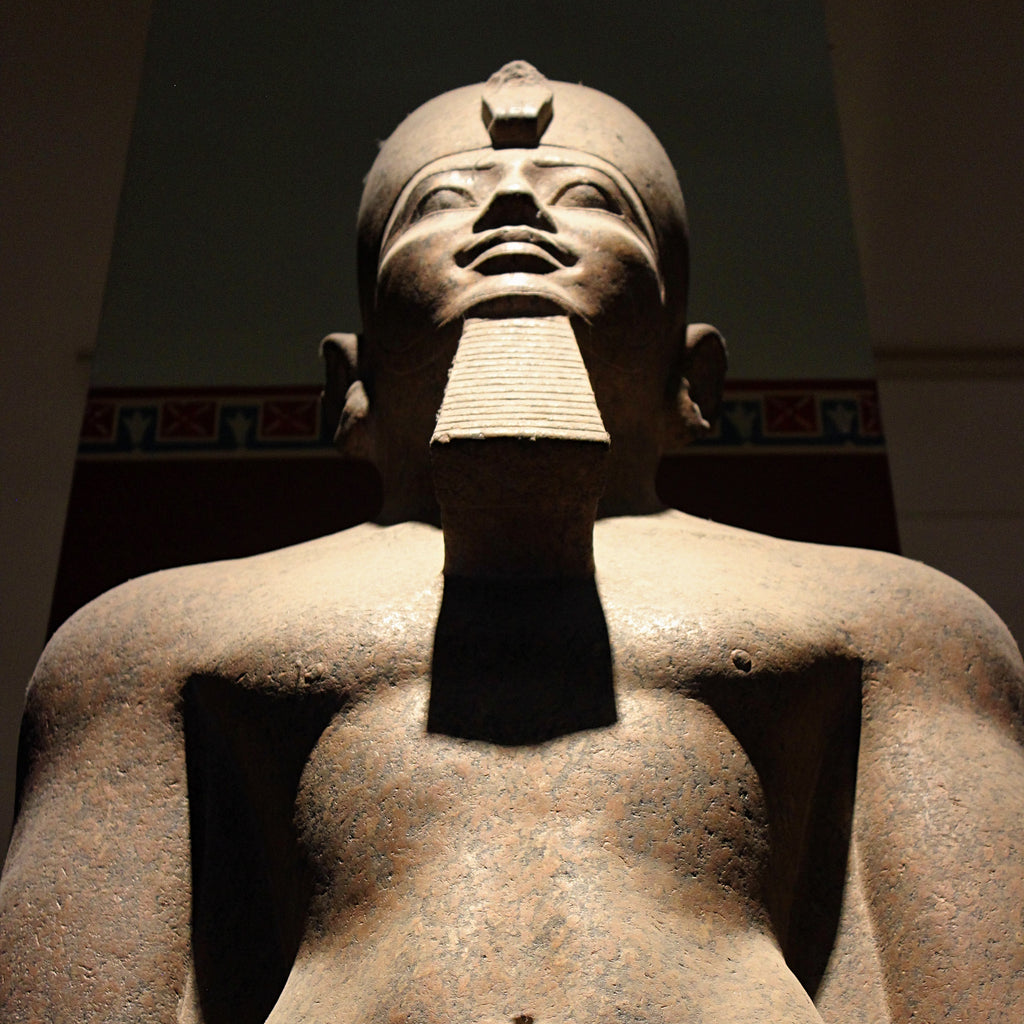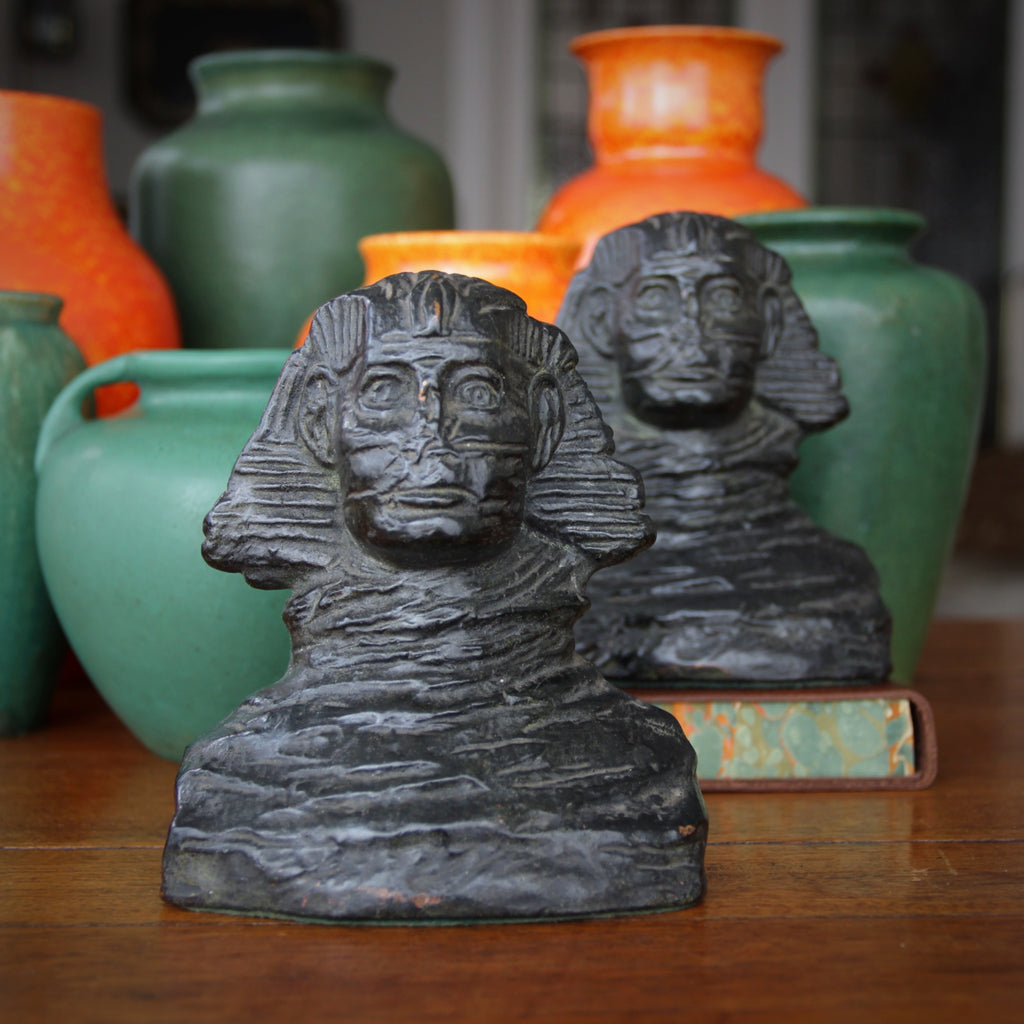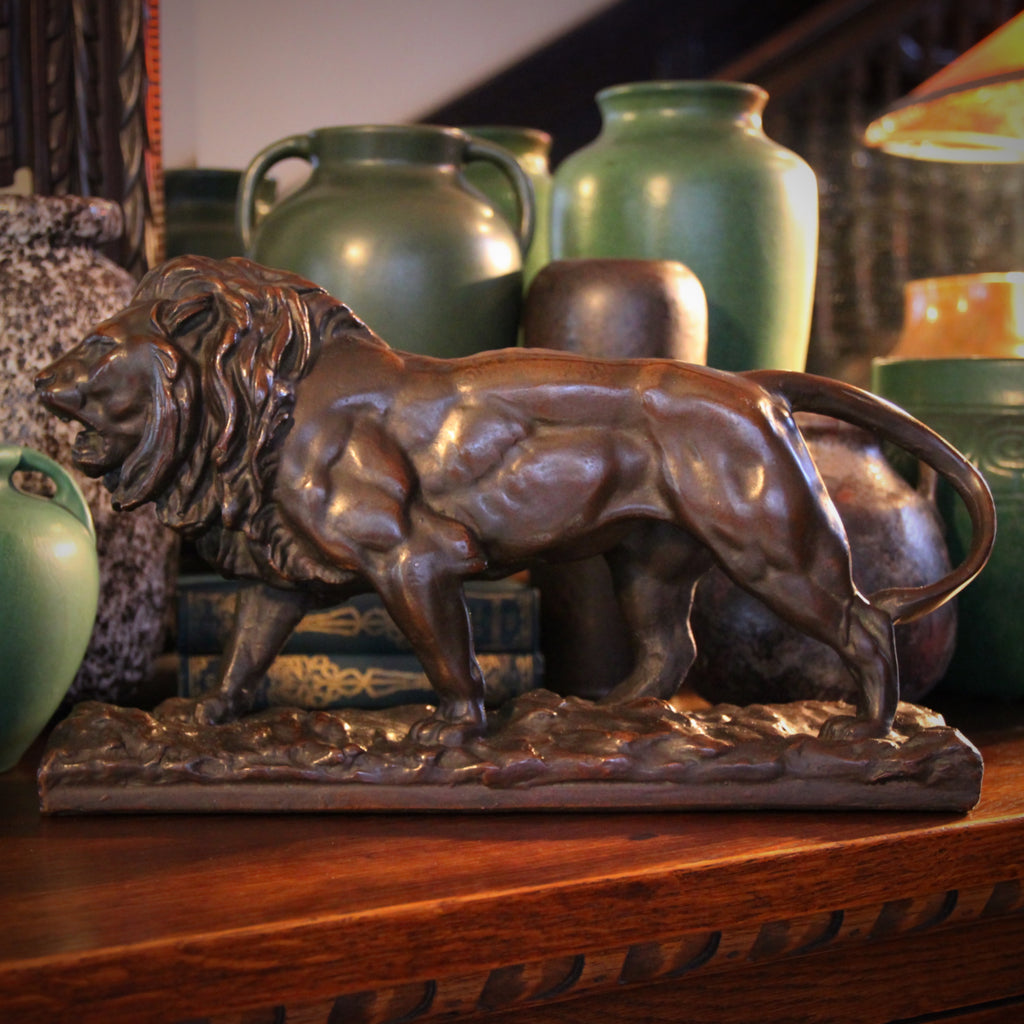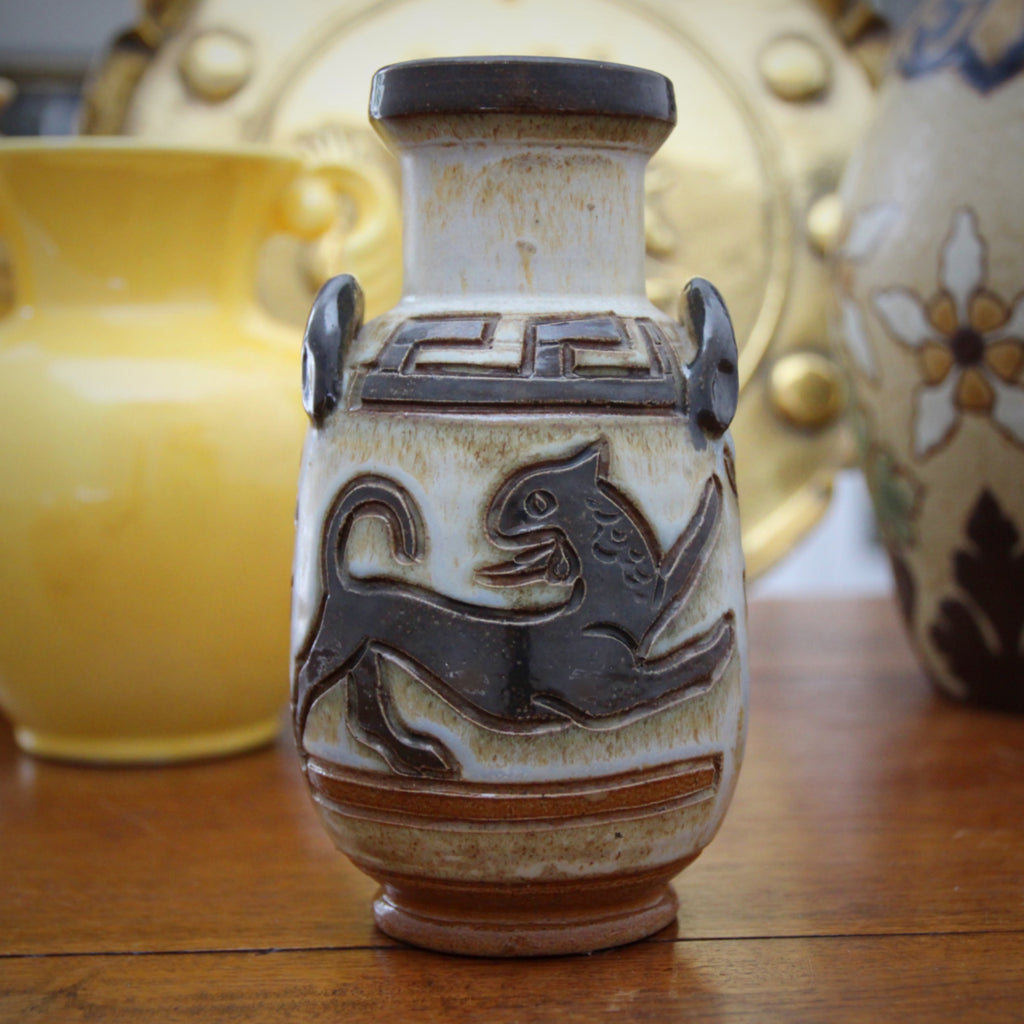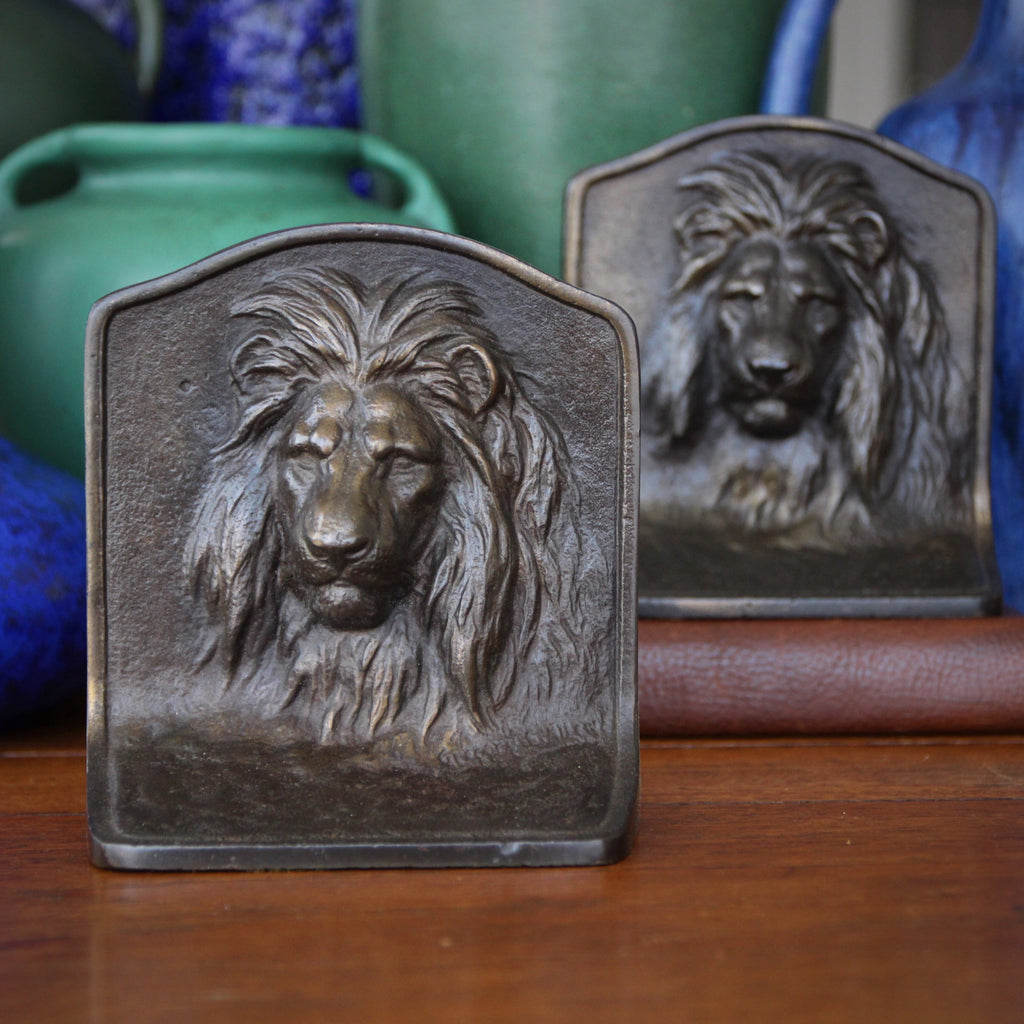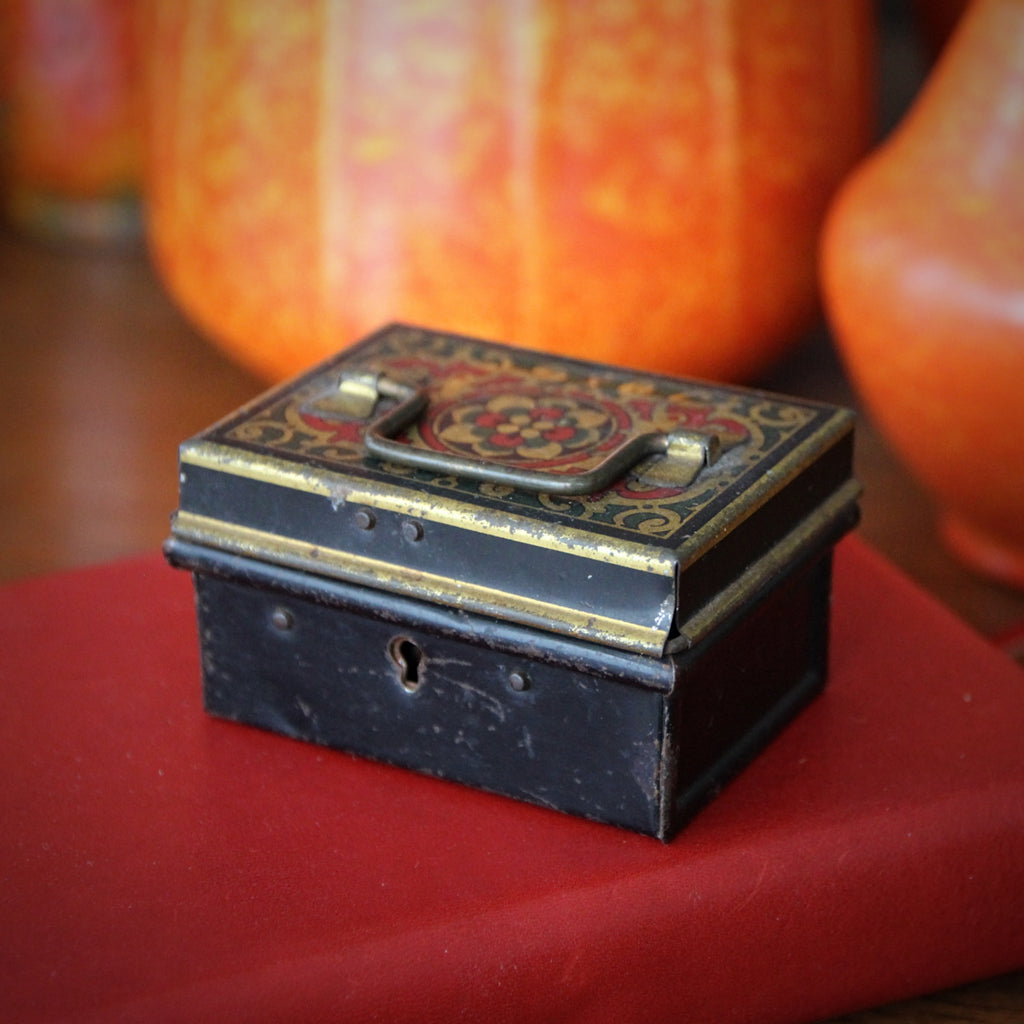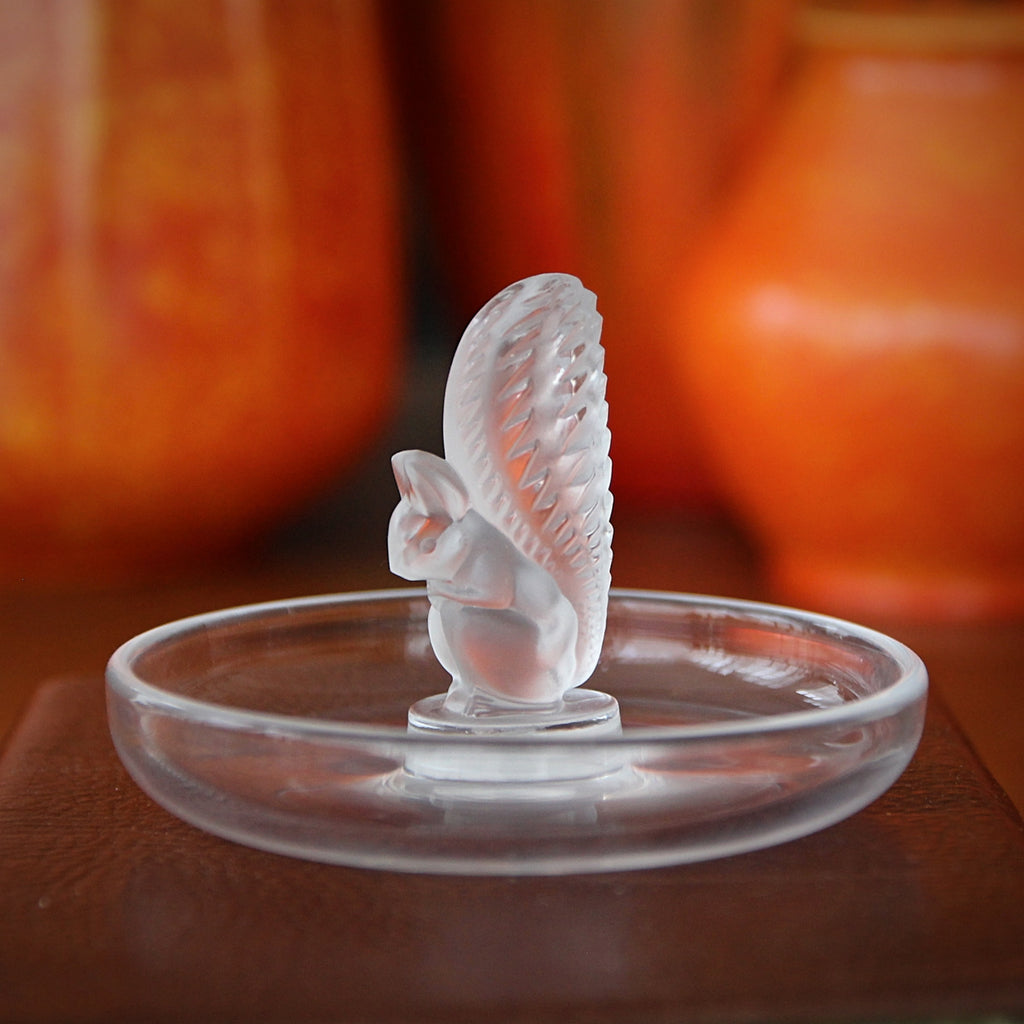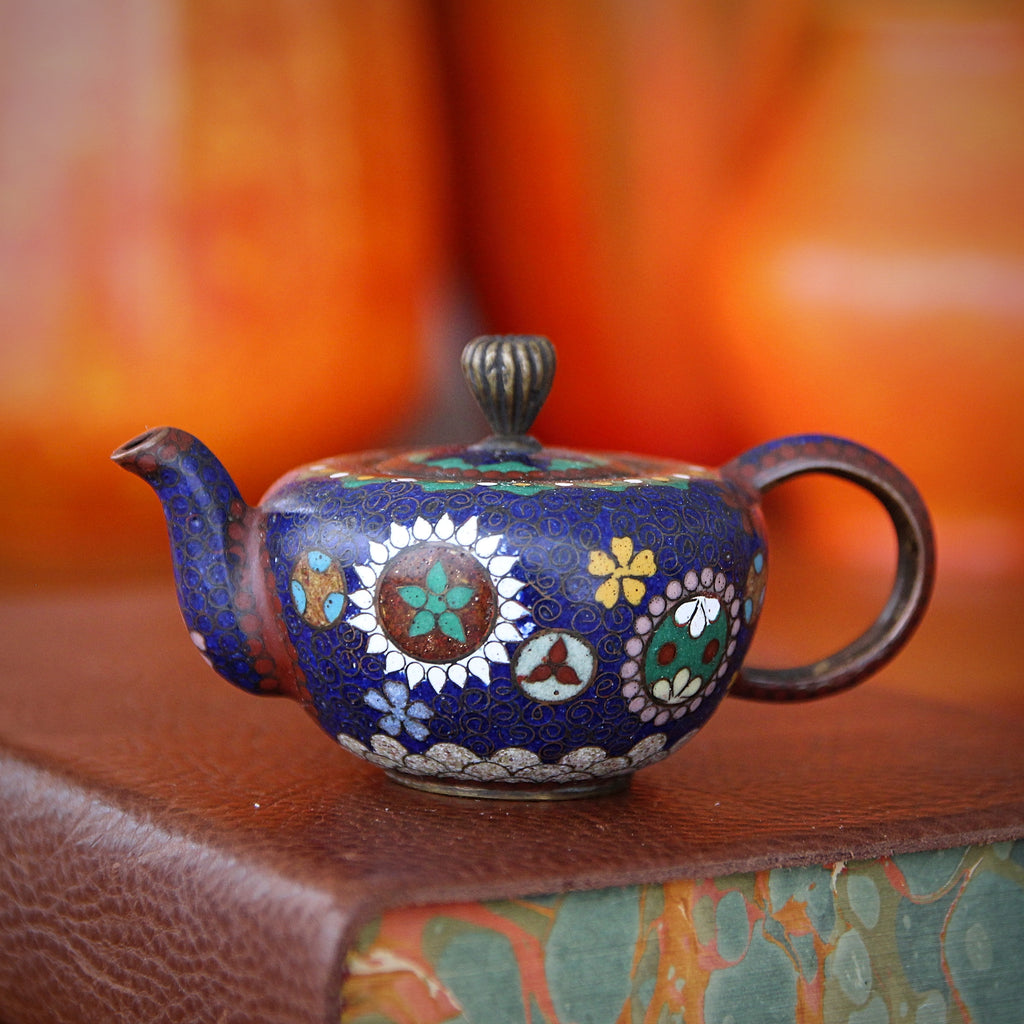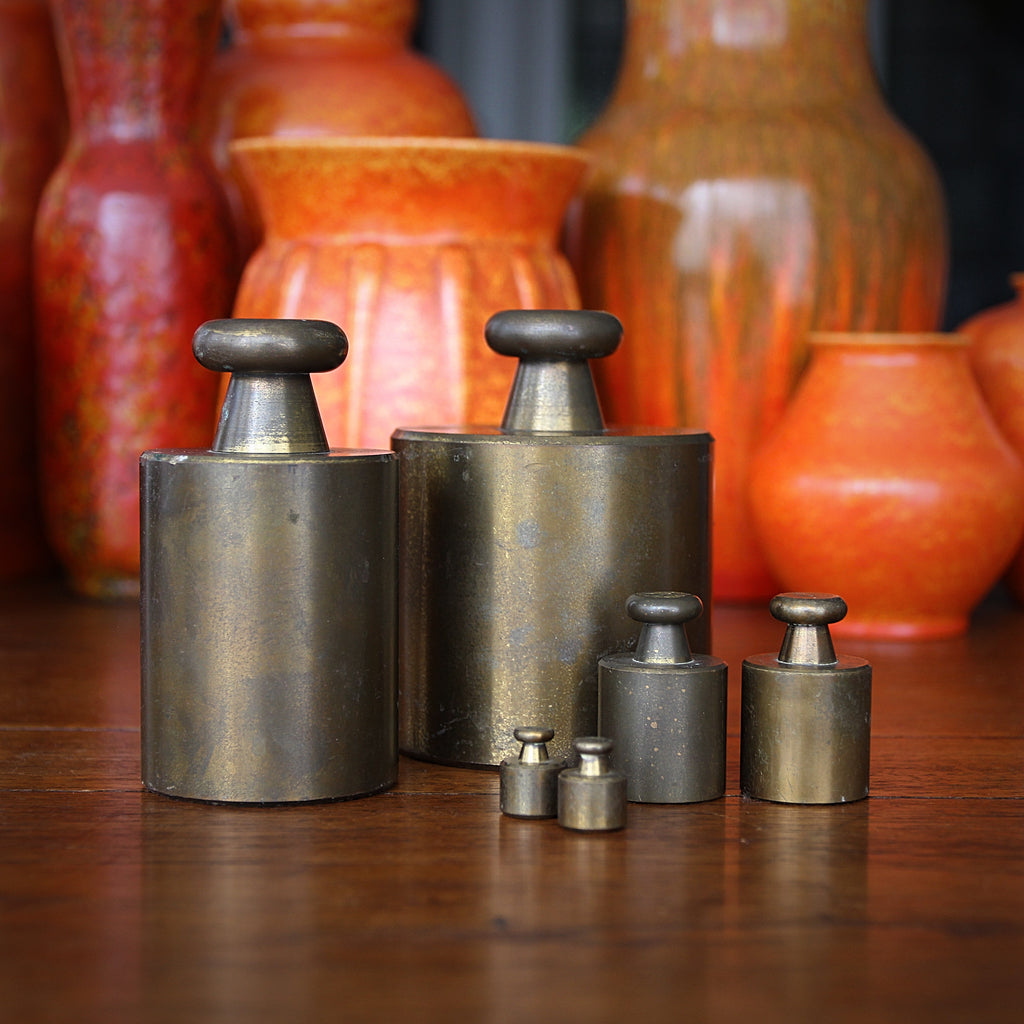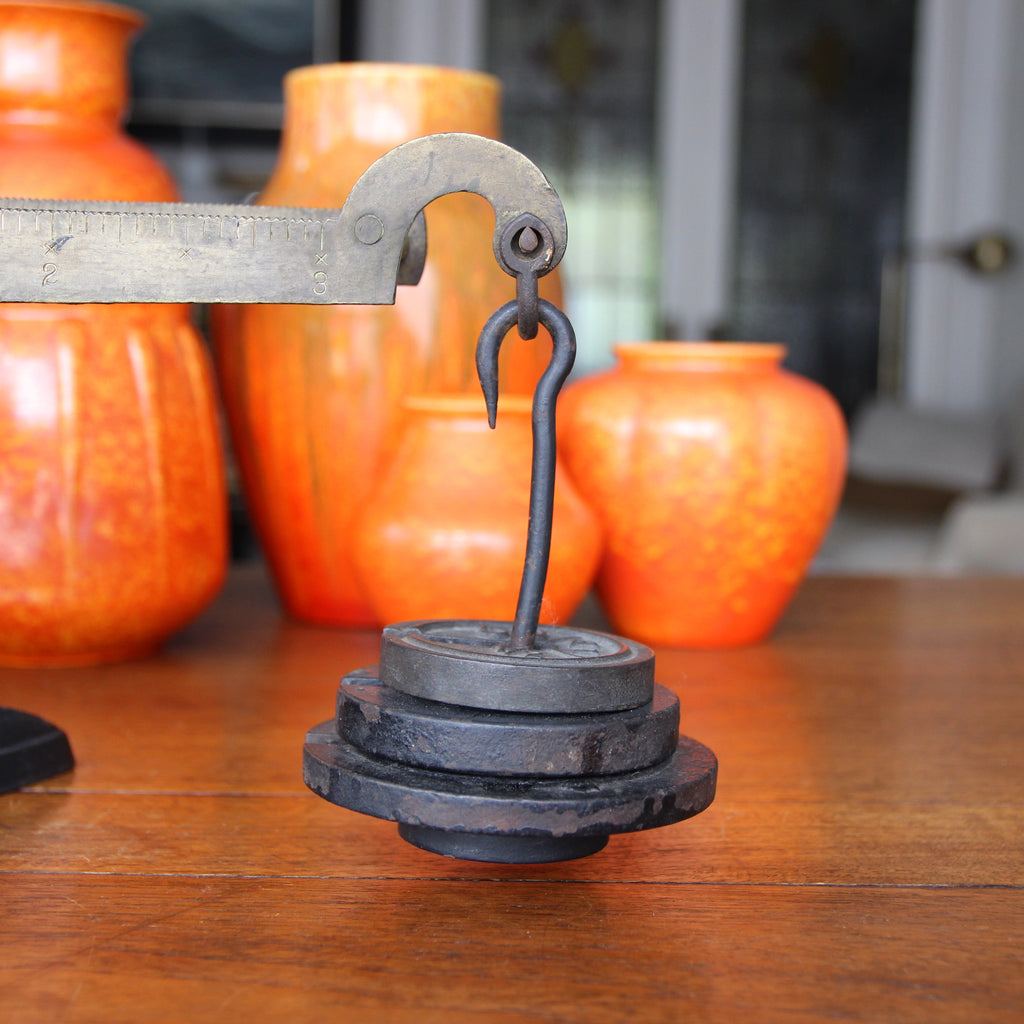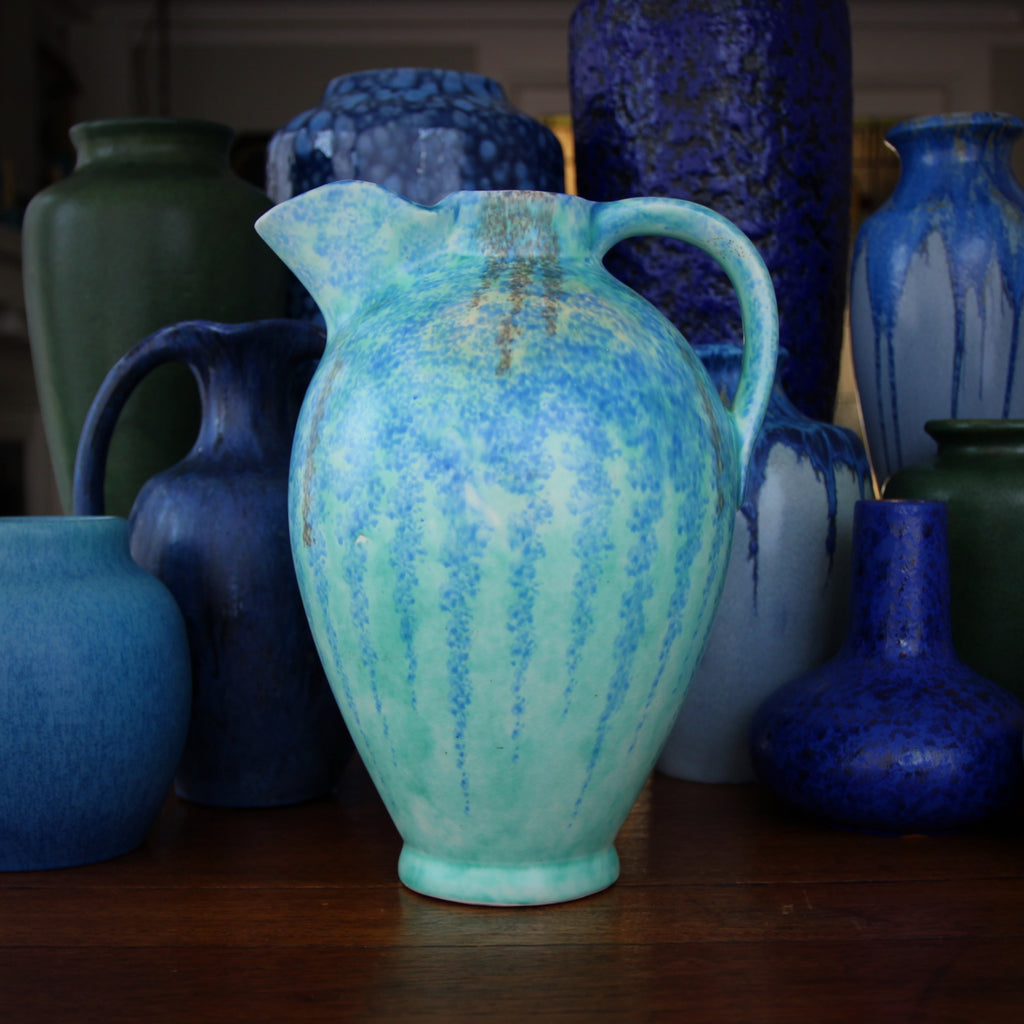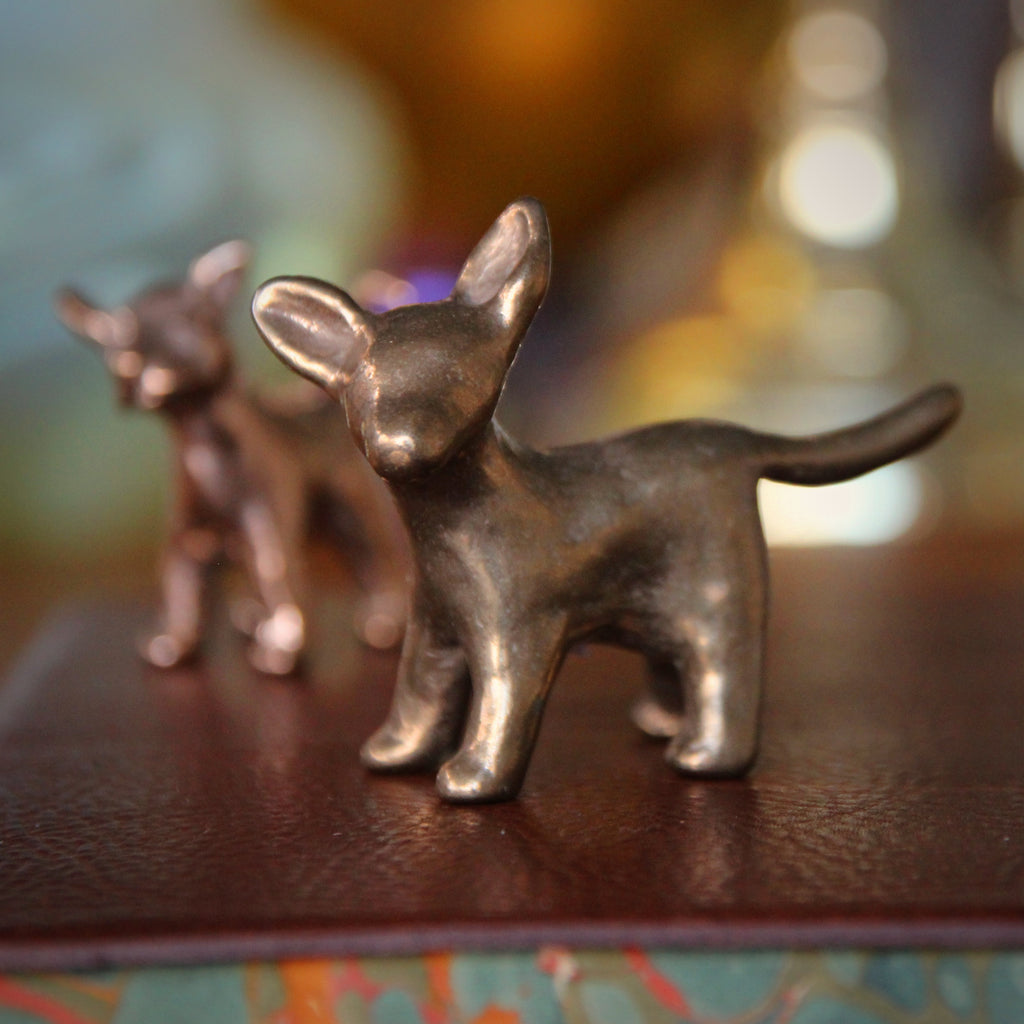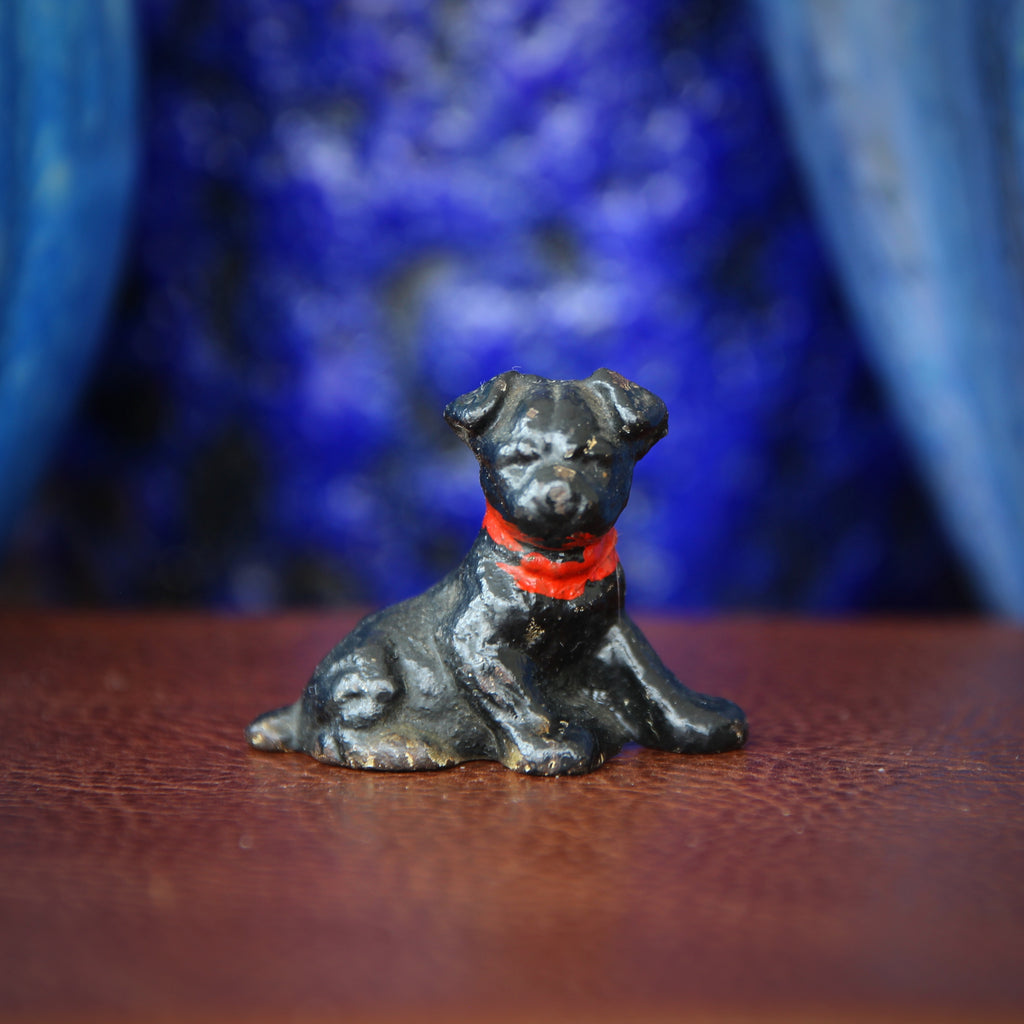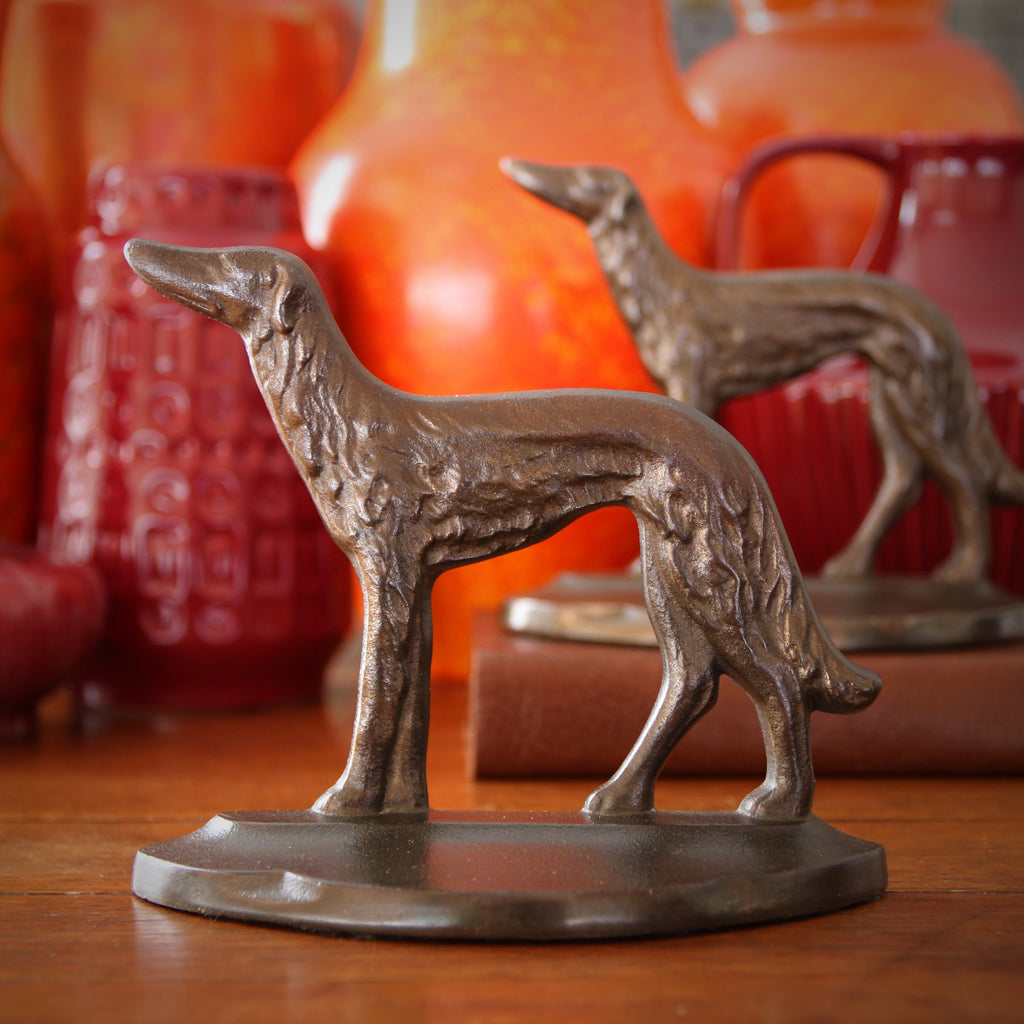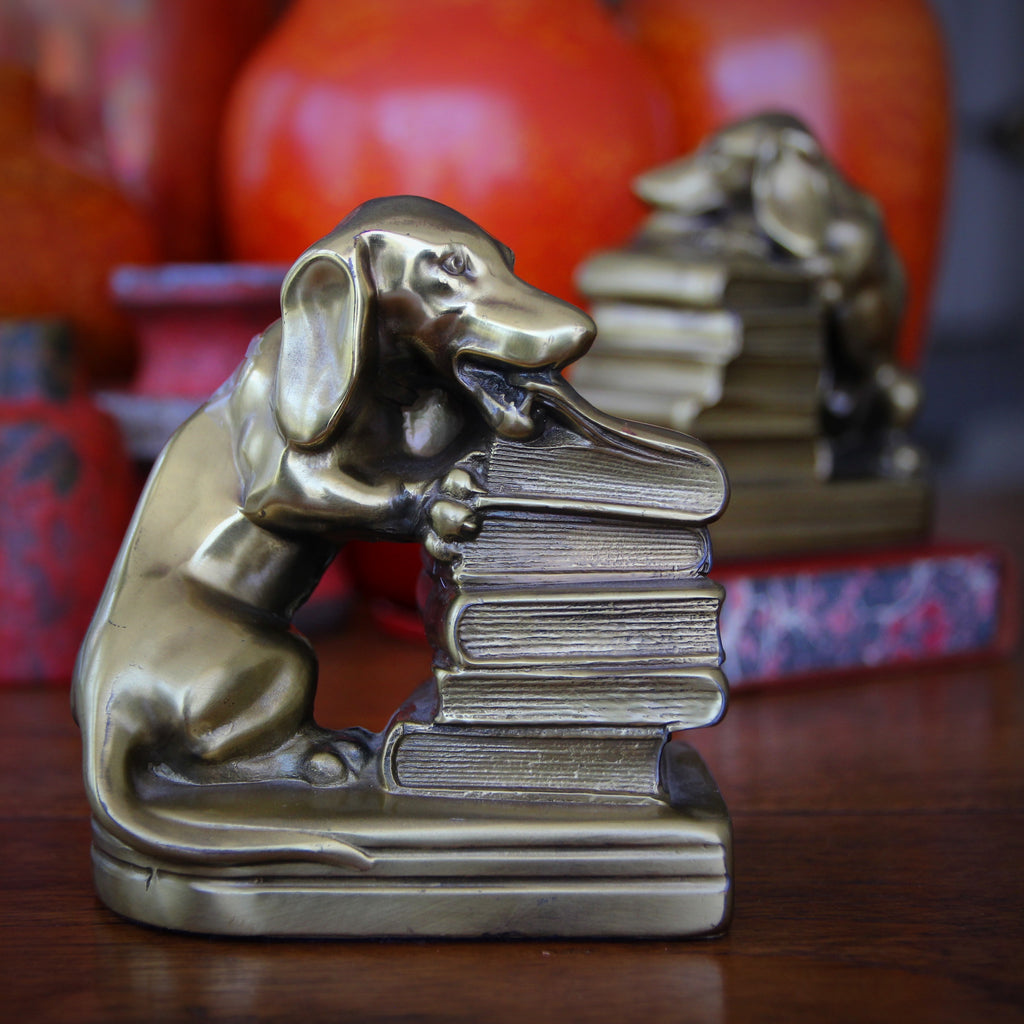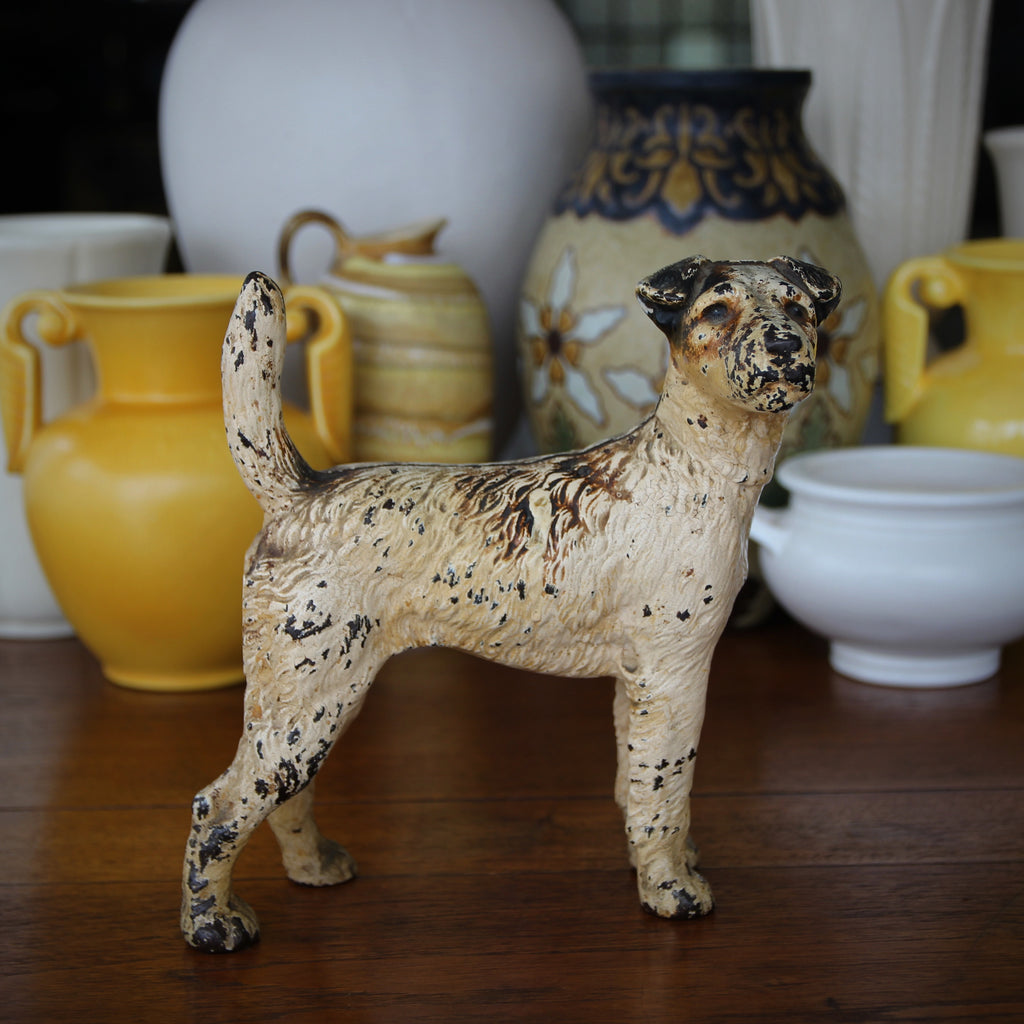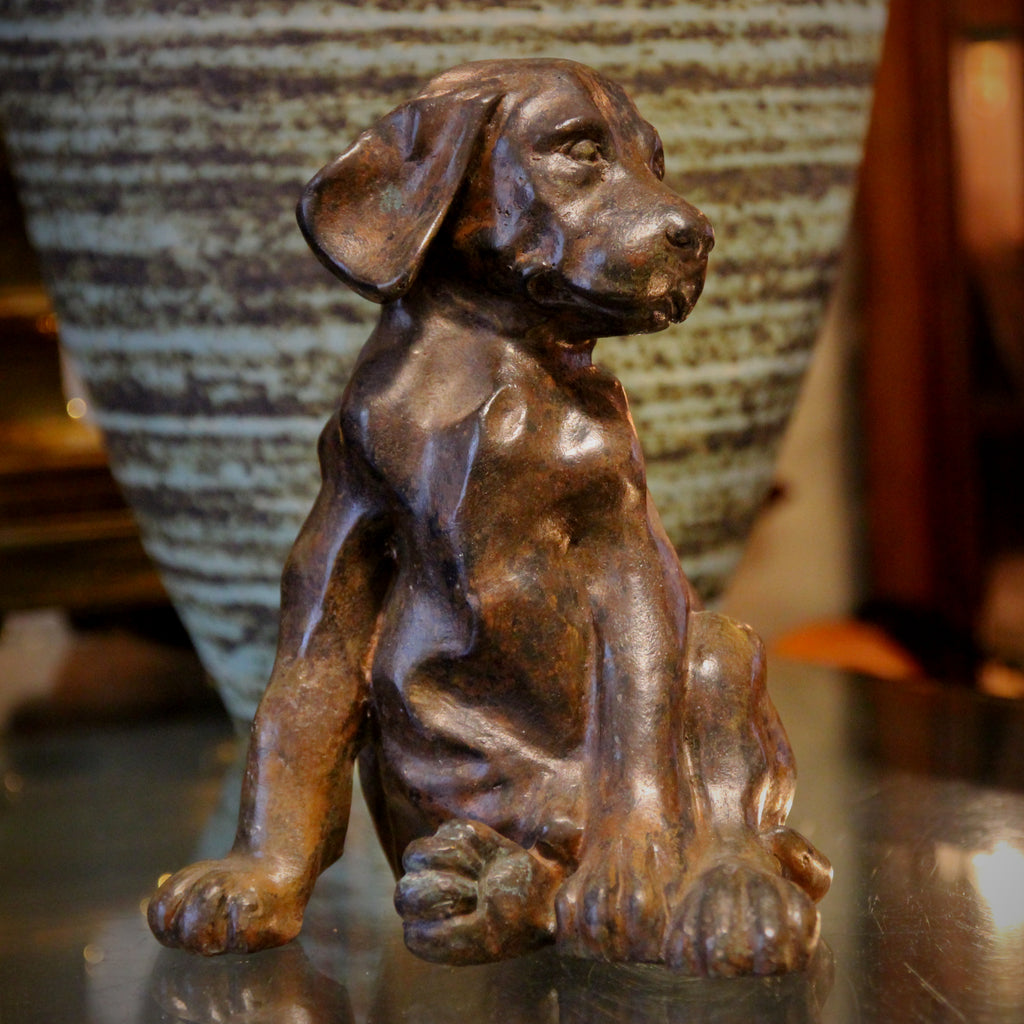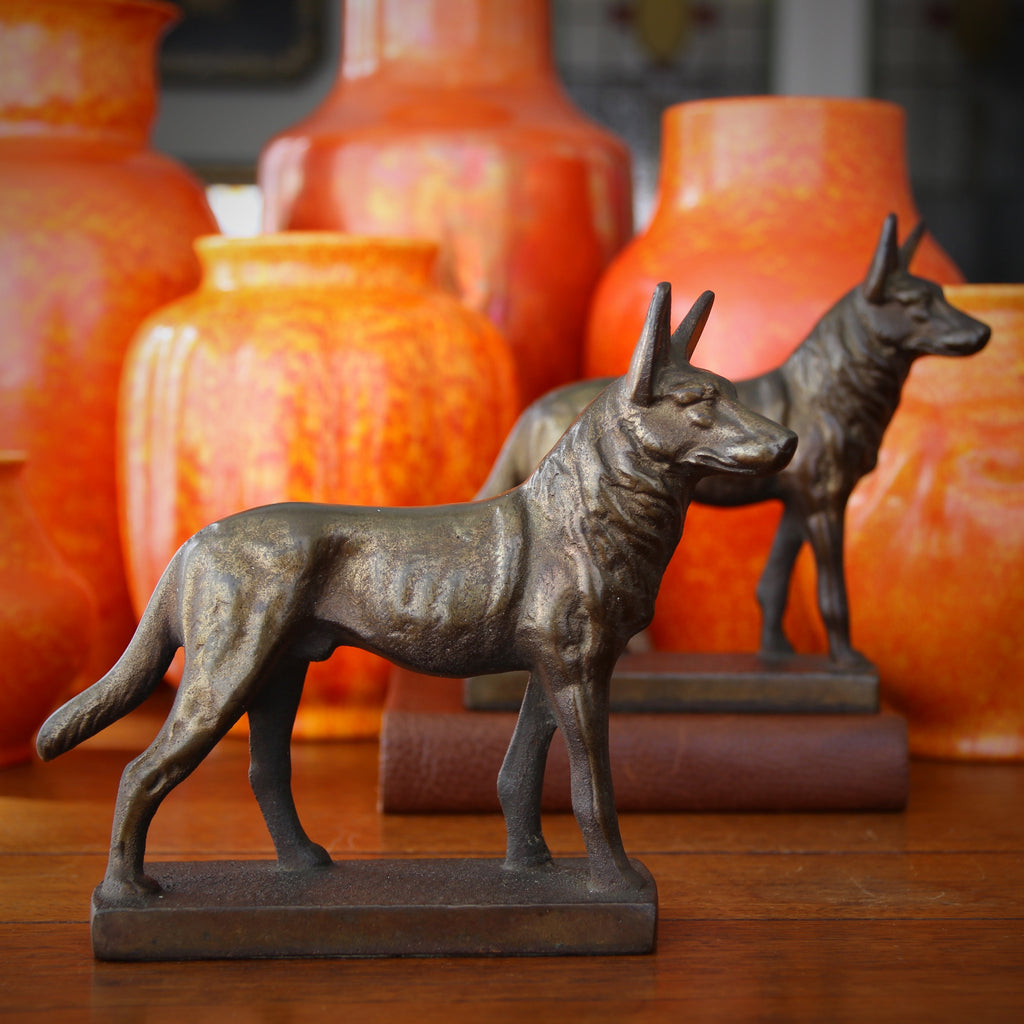JOURNAL RSS
I have never liked smoking. I just don't understand the allure of bathing one's lungs in carcinogenic smoke. One's first cigarette—and the disgust it induces—should be enough to preclude a second one. The act seems so foreign to me. However, I must admit, I really do like many smokers. And I love the accoutrements of smoking: tobacco jars, pipe holders, smoking cabinets, humidors and cigarette cases. And, of course, beautiful ashtrays. Shown above, a large Italian Modernist ceramic ashtray—impressed, incised and glazed in a "Rimini Blu" glaze. It was designed by Aldo Londi for Bitossi and made in the Sixties. The Bitossi family had been making ceramics in Tuscany since 1871. In 1921, Guido Bitossi founded his own pottery workshop outside of Florence....
Durable and Good-Looking, Too
Metallic candlestick and ceramic candlesticks are both popular and commonplace. This pair combines both of those looks: a pair of porcelain candlesticks, glazed in a lustrous, metallic platinum gunmetal. The design also straddle the Classic and the Modernist. They were made in the Twenties by Fraunfelter in Zanesville, Ohio. Charles Fraunfelter was born in Akron, Ohio, in 1866. His wife's uncle was the president of Roseville Pottery and Charles worked his way up in that company: clerk, secretary, sales manager. In 1915, he (and a group of other business partners) purchased the Ohio Pottery Company and hired Austrian ceramicist, John Herald, to guide design and production. At this point, the company was mostly making stoneware kitchenware items like mixing bowls and...
Stoneware Thrown
Stoneware crockery has been used to hold items—often, but not always, foodstuffs—since the Dawn of Civilization. While the manufacturing precision and methodologies have improved, the basic technology has long remained the same: clay is harvested, shaped, fired, glazed and fired again. The English Modernist lidded pot, shown above, was probably made in the 1960's or 1970's. It is crafted of hand-thrown stoneware (a fairly course variety of clay), incised with a band of hearts, and glazed in an organic, variegated brown glaze. A vessel like this is perfect in the kitchen: for holding sugar, pasta, or tea (either bagged or loose). In the bathroom it can keep-handy cotton balls or cotton swabs. And, to be frank, I've sold more than...
Game Time
With the Holiday guests coming—and the long, quiet Winter to follow—indoor family games could become more popular in many a household. Card games, like poker and black jack, use chips as stand-ins for actual money. Likewise with roulette (though most homes are more likely to have a deck of cards on-hand than a roulette table). This hardwood English Art Deco poker chip caddy is ready to help entertain your Holiday guests (or speed-up those long Winter nights). Red, white and blue interlocking poker chips surround the perimeter of the caddy. A burled inlay adds a bit of pop around the handle. And a stitched leather cover keeps everything tidy and secure between games.
Election Day!
Today is General Election Day! I'll be spending about 16 hours squirreled-away in the Soldiers & Sailors Memorial Hall ("Gettysburg Room"), two short blocks from my house. My neighborhood is the nexus of four local colleges, so students and teachers are a big part of our voter base. Then, come 10:00 pm or so (once the voting machines are closed and secured), I'll race home to turn-on the election news recap. The Soldiers and Sailors Memorial Hall was conceived as a monumental, Beaux-Arts tribute to Union soldiers (some of whom mustered on this very site during the Civil War). It was designed by the legendary Pittsburgh architect Henry Hornbostel and built between 1908 and 1910 (shortly after my house was...
Tomorrow's the Day
Tomorrow is General Election Day 2023—a precursor to "The Mother of All Elections" one year from now. I'm sure that tonight, many-a-candidate is hoping for a "lucky result" for him- or herself. Perhaps this sterling silver wishbone, shown above, will add a touch of luck? Or you might know someone, on the cusp of greatness, who can use just such a boost of confidence?
Somethin's Comin'!
What!!! Election Day 2024 is one year away! Get your sleep. Eat your Wheaties. And buckle-up! (It's gonna be a bumpy ride.) There is much to happen between today and the next 5 November.
The cast iron donkey bottle opener, shown here, was made by Hubley in Lancaster, Pennsylvania, just after World War II. It is beautifully hand-painted and will be a delightful addition to the bar cart of your favorite Democrat.
Olde King Coal
In the Edwardian Era—indeed throughout much of the last three centuries—England was driven by coal. It was coal that powered industry. Coal supplied mechanical transport. And coal kept people warm in their homes or flats. Even in tightly-inhabited places like London, most people (who had heat) enjoyed it by burning coal in small fireplaces. Some homes or flats had a coal-burning fireplace in numerous rooms. Next to such a fireplace, one might find a "coal scuttle," basically a bin or hopper to hold a stock of coal in readiness for burning. To handle the dirty carbon chunks, a pair of coal tongs would be kept in or near the scuttle.
The Right Hold on Books
When reading a large, heavy book—a reference tome, a Bible, a cookbook—it is often easier to read when placed on a stand. There are also times when one must use his or her hands while referencing the book. In such cases, a sturdy (and handsome) bookstand, like the one shown above, comes to the rescue.
This Nineteenth Century English bookstand is made of pierced brass, stands atop four feet, and has an adjustable "tilt" to create just the right angle for reading. And the whole unit folds shut for storage when it's not being used. It is also a fine place for displaying a framed photo, a piece of art, a menu, or a sign atop a table or credenza.
Fashion Plates
In the late Nineteenth and early Twentieth Centuries, Pochoir printmaking was a popular technique, especially in Paris. The French word "pochoir" (pronounced poe-SCHWA) literally translates to "stencil." In this technique, a stencil is made to create a limited number of fine-lined prints—which are then hand-colored. Sometimes a collection of the limited edition plates, related in theme, were bound in a portfolio (for example, pochoir prints of the Ballets Russes). Although the pochoir stencil-print method allowed prints to be duplicated quickly, the high level of handcraft allowed each one to be considered an original work. And, as the ink was daubed over the paper stencil, it would create a varied, hand-drawn look to the line work. Of course, the extensive hand-coloring...
November is Here!
Welcome, November, and your birthstone the Citrine.
The Citrine is a pale yellow variety of quartz. Its sunny color is thanks to the iron content within the chemical structure of the gemstone. And Citrine's sunniness was not lost on Greeks—who first used the stone around 300 BC—who believed that the gemstone could help alleviate depression. At the time, Citrine was very rare, thus expensive, opulent and luxurious. As larger deposits were later discovered and mined (notably in Brazil), the gemstone became more common and fell within reach of more and more admirers.
All Hallows' Eve
Today is "All Hallows' Eve"—Hallowe'en—the night before the important Christian Holyday of All Saints' Day. All Saints' Day began in the Fourth Century as a commemoration of Christian martyrs. By the Ninth Century, Christian communities in England were celebrating All Saints' Day on 1 November—a practice which was soon thereafter mandated worldwide by Pope Gregory IV. All Saints' Day (a Holy Day of Obligation for Roman Catholics) is the solemnity at which all saints—known or unknown—are commemorated. In the Christian faith, a saint is simply any soul which has reached Heaven (and is with God). Although we (mere mortals) don't always know who has already reached Heaven or not, the Church has designated certain souls as having "made it"—based on...
Franz Liszt
Romantic musical superstar, Ferenc Liszt, was born in the Hungarian village of Doborjan—at the time part of the Austro-Hungarian Empire and today a part of modern Austria (called "Raiding"). Ferenc (called "Franz" in the West) was born to a musician father who began teaching his son to play the piano by the age of seven. By eight Franz was crafting simple compositions and, by nine, he was performing concerts. After hearing the prodigy play, a group of wealthy music patrons agreed to finance Franz's musical education in Vienna—the capital city of the Austro-Hungarian Empire. Liszt spent the rest of his boyhood studying, composing and touring. When his father died in 1827, the 16 year old Franz quit touring, moved with his...
Long-Legged Beauty
After unfolding its spindly legs, and taking first steps—tentative and shaky—a newborn foal will soon find its way to its mother's milk. This first drink is rich with colostrum—packed with antibodies which a newborn foal needs to create its own immunity system. Usually, amazingly, by the end of the first day, a newborn foal will be cantering (quite comically) around its mother's paddock—like a rocky hobby horse, as much up-and-down as back-and-forth. Horses are born with its legs at nearly adult length; they will only get a little longer as the horse grows up. It takes a week or two before the foal will begin to nibble at grass or its mother's grain. Domesticated horses may start eating grain in...
Holiday Prep
The Holiday Season in fast approaching. Baking. Dinners. Holiday gatherings. Perhaps it's time to spiff-up that bar cart? Shown here, a set of four silver-plated "bar bottle" collars. They are made in a "horse hoof" form, designed to snap around the narrow neck of a bar bottle or long-necked decanter. Years of polishing have left the enameling a little worn—and portions of the underlying brass shine-through—but they are still legible and still very stylish.
Terriers
Terriers comprise a wide and diverse range of dogs, originally selectively-bred for particular working or sporting purposes. Their sizes span from the smallest, at two pounds, to the largest, tipping-the-scales at 130+ pounds. In earlier days, these purpose-built breeds tended to stay fairly well-isolated geographically—that is, genetically distinct, not interbred with other regional terriers too much. The farmers, hunters and business owners who kept these dogs tended not to travel as far (with their dogs) as people do today. Before modern transport, people (and their dogs) tended to keep within tighter geographic circles. For this reason, in Scotland alone, we see many well-known varieties of terriers which were developed over the years: Scotties, West Highland Terriers, Cairn Terriers, Skye Terriers, Dandie Dinmont...
Blow, Raffaellesco, Blow!
The giant of Italian Renaissance Painting, Raffaello Sanzio da Urbino, is believed to have first painted this arrangement of "grotesques" and "arabesques"—those monstrous creatures whimsically surrounded by delicate sprays and curlicues. In this case, the "grotesque" is actually a benign deity, Raffaellesco, the protective god of sailors and merchant seamen. He blows gentle winds to keep seafarers moving forward and on-course. Raffael's home town, Urbino, was just a little over 20 miles from the seaside. Sailors (and merchant traders) would have been well-acquainted with the (fairly) nearby port of Pesaro. And the ceramics manufacturing town of Deruta, where this umbrella stand was made, although further inland, would have produced highly-decorated ceramics which would appeal to coastal Italians and would commemorate...
Bird Bell
A proper Victorian household would not be complete with a broad collection of bells, scattered variously about the house. A "quick tinkle" of a tea bell would summon the servant to bring-in the tea, collect a letter for posting, or to escort a guest from the sitting room. Bells should sound nice, of course, but their sound must also travel a reasonable distance, sometimes through walls or closed doors. The handsome Victorian bronze tea bell, shown above, may have helped keep a proper household properly moving. The handle is in the form of a parrot. And the hand-painted coloration (on the bird and on the skirt of the bell) is referred to as "cold painting"—that is, paint applied to the...
Monkey Business - IV
This great ape raises his arms in victory—a Modernist sculpture by the Danish artist Knud Carl Edvard Kyhn (1880-1969). Under the artist's careful supervision, this piece was produced in 1969. The original was sculpted by Kyhn from which a small number were produced each year—enough to satisfy collectors without over-saturating the market. Each piece is date-marked which makes it easy to determine its year of manufacture. This particular sculpture is an appropriate gift for the monkey lover who has just completed a Herculean feat: graduation, publication, business start-up
Monkey Business - III
Here a mother monkey cuddles her little one. Is that a worried expression on her face? Made by Knud Carl Edvard Kyhn (1880-1969) during his many years working with Royal Copenhagen in Denmark. Kyhn was an important figure in the world of Danish Modernist ceramics—especially figural sculptures. He was also a painter and illustrator. This sculpture was produced in 1969.
Monkey Business - II
A pensive monkey contemplates great thoughts. This sculpture was made by Danish artist Knud Carl Edvard Kyhn (1880-1969) during his long association with Royal Copenhagen. It was modeled by the artist and is finished in Kyhn's signature "Sung" glaze.
Monkey Business - I
For thirty years, I have been collecting works by the Danish sculptor Knud Carl Edvard Kyhn. He was born in 1880 and, after completing art school, began his career working for various Danish ceramics manufacturers: Royal Copenhagen, Herman Kahler, Bing & Grondahl. The bulk of his working years was at Royal Copenhagen where he designed (and supervised the production of) a line of stoneware sculptures finished with "Sung" glazes. Most of these were animals though there were the occasional people or mythological creatures. Royal Copenhagen was in the business of producing "collectable artwork" so they carefully produced a limited number of each design every year (enough to satisfy the collector's market without over-saturating the market with too many pieces). For this...
Brushing-Up
When did brushes become obsolete? When I was a boy, I remember the monthly visit of the Fuller Brush Man. My mother would often place a small order with him—kitchen brushes, vegetable brushes, hair brushes, even brush-cleaning brushes. And, not so long ago in Edinburgh, I remember a shop on a twisty road, just off "The Golden Mile," which was entirely devoted to the stocking and selling of brushes. Every manner and style of brush could be found—hung from every rafter, covering every wall, sprouting from crates on every horizontal surface, even pulled-out (like fresh flowers in buckets) onto the sidewalk.
Three Wise Monkeys
There is a very important shrine in Japan for Shinto Buddhists, namely, the Tōshō-gū Temple in Nikko, Japan. Seventeenth Century wooden carvings by sculptor Hidari Jingoro depict the Three Wise Monkeys: Mizaru, Kikazaru and Iwazaru. These monkeys (actually Japanese Macaques) wisely see, hear and speak no evil. But 900 years earlier, in the Eighth Century, Buddhist writings from China made their way to Japan, conveying a similar maxim. And more than a thousand years before that (during the 4th to 2nd Century BC), Confucius's writings (probably collected by his followers) advise us to "Look not at what is contrary to propriety; Listen not to what is contrary to propriety; Speak not what is contrary to propriety." Monkeys—in Asia and elsewhere—are...
Bleu Français - Trois
As inventive as every generation aims to be, sometimes the past just cannot be improved upon. Such is the case with Chinese ceramics design (whom the Western World had been trying to copy for centuries). Thus, ceramicists, in every place and time, pay occasional homage to the Chinese masters of the past—and their forms which have proved classically enduring.
The Pierrefonds French Art Nouveau vase, shown above, is of classic Chinese form. But the glaze treatment is all Art Nouveau. A steely blue-grey underglaze wears a cape of dripping, organic glazes on its high shoulders. Light crystals are encrusted along the shoulders while tendrils of glaze drip languorously down the sides of the vessel
Bleu Français - Deux
The upscale ceramics workshop Societe Faiencière Heraldique de Pierrefonds was founded in 1903 by the painter Olivier de Sorra, the Count Hallez d'Arros. He was enchanted by the picturesque village of Pierrefonds, about 50 miles Northeast of Paris. He built a pottery in the shadows of the commune's handsome chateau—decorated as it was with plenty of turrets and gargoyles. The Count's original plan was to make handsome dinnerware—plates, bowls, tureens—bearing painted heraldic decoration. The plan didn't fly and soon Art Nouveau sculptor, Émile Bouillon, came-in to try something new. Bouillon's highly-sculptural works, beautifully-glazed (sometimes with crystalline finishes), scratched the world's Art Nouveau itch—and business took off. Soon Pierrefonds was selling in the smartest Paris shops (as well as in London, New...
Bleu Français - Un
Amongst my favorite trio of vases—in my LEO Design collection—is this set of three French Art Nouveau vessels, which I shall share over three days, made by Pierrefonds in the early Twentieth Century. Classic forms of heavy ceramic stoneware are glazed with a steely blue-grey underglaze, then capped with an organic, dripping blend of blue glazes: cornflower, royal, cobalt blue. The crisp, classical forms are juxtaposed against the random, uncontrolled embellishment—creating an artistic, dynamic tension.
This high-shouldered vase is a classic—even an ancient—form. The dripping glazes pool and curdle within the eddies of the flat ridge encircling the neck.
Monarch of the Glen
The "Monarch of the Glen" stands proudly atop his rocky outcrop with this pair of oversized cast bronze bookends, made in the 1920's. Besides their size (large), their material (bronze), and their handsome sculpting, they are also a mirrored pair—that is, the two mates face in opposite directions, This allows you to place them on your bookshelves with both bookends facing forwards. They would also look wonderful standing at opposite ends of a rustic mantelpiece—as a beautifully-sculpted decorative touch in your home or weekend cabin. Mirrored bookends required considerably more effort, time and expense to create. Because the two mates use different moulds, two original models needed to be sculpted. And different moulds required greater attention to detail—ensuring that a...
Basic Black
This handsome "dress set"—cufflinks, shirt studs, buttons—was crafted in the Art Deco Thirties, with an eye on the Modernism to come. They were made by the jewelry-maker Larter (Newark, NJ), founded at the conclusion of the Civil War in 1865. Soft squares of black mother-of-pearl are set into rolled-gold mountings for a nice, finished look. One of the nice things about black mother-of-pearl is its versatility—its ability to complement nearly any color shirting or suiting fabric. The soft, natural iridescence of the shell material reveals a subtle rainbow of colors: blues, grey, reds, pinks, purples, greens, golds. This flexibility makes it a useful accessory, especially for the man who doesn't (yet) have a broad collection of cufflink color options. These cufflinks go...
On the Range...
This majestic Monarch of the Range stands atop a crisply-cast prairie—one can almost see the wild grasses rustling in the breeze. And the animal, himself, is beautifully sculpted and cast, too. Despite the American Bison's status as an icon of America strength, independence and determination, they nearly were driven to extinction in the 1880's—a full five decades before these bookends were cast. In the year 1800, an estimated 60 million buffalo roamed the Great Plains. By the end of that century, all but 500 had been exterminated by overhunting. Cattle ranchers attempted to breed their domesticated bulls with bison cows, though the results were poor. The hybrids were generally weak and only the female offspring were fertile. Luckily, today, about...
Art Nouveau Belge
This Belgian Art Nouveau bronze platter ticks so many boxes for me. It's Art Nouveau. It's Belgian. It is highly sculptural. It is cast of heavy bronze. And it features an exuberant spray of highly-realistic tulips—each one dressed in a gilded bronze patina. Is it practical? Well.... Sure, you could place business cards on it. It could be used to hold pens or clips on the desk. It's perfect for corralling few cufflinks, collar stays or earrings at the bedside. And it could even present a small offering of wrapped candies on a table. But its greatest feature is its beauty. It would perform no task better than being a beautiful accent on a flat surface—a Nouveau punctuation on your...
Back to Abu Simbel
After my Summer's Trip of a Lifetime—to Egypt and Jordan—I am more committed than ever to collecting Egyptian Revival decor: bookends, paintings, desk accessories. I love items, even Western items, which express the world's riveting fascination with Egypt's ancient treasures, some of them being rediscovered after centuries of being buried under sand. The bookends shown here, made by Bradley & Hubbard in the Twenties, remind me of the Temple of Rameses II in Abu Simbel, Egypt (in "Upper Egypt," that is, in the South of the country, close to the border with Sudan). While the artist-sculptor took great liberties with the arrangement of elements, here we see the temple entrance, flanked by seated likenesses of the pharaoh, Rameses II. The "Winged...
Make Your Mark
"Handsome and Useful" has always been my lodestar—at least when it comes to selecting gifts and other antique items to offer in my shop. The dressmaker's "Skirt Marker," shown above, ticks both of these boxes. A cast iron base holds the boxwood measuring stick used to achieve a level hem while marking the skirt or dress. It is patent-marked from 1940 and was probably made shortly thereafter (before America diverted much metal production to the war effort). Perhaps you've fashioned your final couture creation? Well, this piece of vintage sewing paraphernalia will help maintain the atmosphere of an old-time tailoring shop. It would also be a cool gift for a fashion designer friend or graduate.
Crisp and Clean
Show-off the last of your Summer tan against the clean, white enameling of these Art Deco sterling silver cufflinks from the Twenties. Machine-turned guilloché work rests below the bright white enameling. A bold ring of Danish blue enameling encircles the white. Clean and classic, these handsome cufflinks will work regardless of the season.
Autumn is Here - part XV
Let's end our procession of Autumnal Offerings with this fat and fluffy bird—apparently well-fed and ready for the Winter! Is that a disgruntled look? Or is he just feeling a bit overstuffed? He is cast in brass, finished with a verdigris bronze patina. Bigger than a golfball—but smaller than a tennis ball—this little bird would make a wonderful paperweight or quiet companion on your desk, windowsill or bookshelf.
Autumn is Here - part XIV
Squirrels aren't the only wildlife wreaking havoc in my urban garden. Deer—over-populated and starving in the forested, nearby Schenley Park—have begun to cross into the city streets in-search of food. Since the mountain lions (which once roamed the area) are now gone, the deer population has exploded and they have stripped their wooded domain of grass, leaves and bark. As they venture out of the forest, they bring numerous problems with them. Automobiles hit them. Ticks (possibly bearing Lyme Disease) drop-off the deer, lying-in-wait for the next dog or human to pass-by. (A colleague of mine is currently battling the devastating effects of Lyme Disease—and not well.) And the starving creatures devour my lovingly-tended plants, sometimes just as they emerge...
Autumn is Here - part XIII
As the Autumn chill increases, we find ourselves hanging-up the garden tools and returning to our indoor pastimes: reading, baking, arts & crafts. For those who sew (or practice other needlecrafts), this hand-carved Swiss Blackforest pincushion might be a handsome and practical solution. Leaves and scrolling branches provide the frame—which, if desired, can be hung right on the wall (next to one's sewing spot). It can also be stored in a sewing basket or on a sewing room table or shelf. If sewing isn't your hobby of choice, this pincushion might be a useful place to hang some of your jewelry: pin-on the brooches directly and hang earrings or necklaces on a straight pin. It is also a clever and handsome...
Autumn is Here - part XII
With Autumn in full-swing, the bears are making final preparations for their months-long Winter hibernations. In the Fall, bears enter a period of "hyperphagia"—gorging on up to 20,000 calories per day (and gaining three pounds per day). They need to prepare for up to five months of confinement (depending on their climate zone) during which they will not eat, drink or eliminate waste. While they may not technically "sleep" right through their entire hibernation, their respiration and heartbeats will drop significantly, conserving precious energy, energy which they will need to complete the hibernation. Bear breeding season in in the late Spring or Summer. Pregnant bears, however, can "suspend their pregnancies"—that is, forestall their fertilized eggs from implanting into their...
Autumn is Here - part XI
The Art Deco ceramic rosebowl, shown here, made by Roseville in the Thirties, is an amalgamation—an artful melding—of two very different aesthetic sensibilities. First there is the form: a high-concept, industrio-mechanical sculpture, reminiscent of the vents on a piece of machinery (if not the gills on a robotic, Jules Verne shark). It's a hard, cold structure—practical, technical, efficient. (And a little scary, like a piece of equipment on the Star Wars Death Star.) Laid upon that is the second factor, the glaze. Its soft, mottled, earthy and organic coloration belies the hard, industrial form beneath. This juxtaposition of the gentle and the stern provides a wonderful contrast—a tension—in the final piece. And, as one can see, the glaze...
Autumn is Here - part X
Dressed in glazes of rusty, fallen Autumn leaves—with just a glint of metallic golden-bronze—this French Art Nouveau ceramic covered pot is animated with organic bas relief botanical elements: swaying leaves and twigs. It's the perfect size for keeping something special, perhaps those souvenir ticket stubs from flights to cherished holidays. Or something more mundane, like collar stays, cotton swabs or potpourri. The covered pot was made by Denbac around 1910.
Autumn is Here - part IX
The Autumn Season is Sweater Season—that most forgiving of garments. Shown here, a faux mohair teddy bear, with posable joints and a knitted, red, white and blue striped sweater. This little guy will make the perfect (quiet) companion—for you or for a youngster in your life.
Autumn is Here - part VIII
October is here! And with it comes the marigold—birth flower for the month of October.
Marigolds originated in Mexico and eventually spread South into Central and South America. This pungently-scented plant has been used medicinally, sometimes drunk as a tea, and it is also employed as a culinary herb. In South Asia, marigolds are used decoratively—strung into garlands or arranged as a carpet—for celebrations and Hindu religious ceremonies.
Over many years, the marigold has been developed into an easy-to-grow garden plant. Its fragrance, which some find unpleasant, is repellant to certain insects (thus marigolds are sometimes planted alongside other plants which require protection from infestation). And many varieties of marigolds have been produced by specialist gardeners.
Autumn is Here - part VII
Amongst the delights of urban home ownership is contending with the wildlife—wildlife which one would think should be living somewhere else (perhaps in a forest). Crows select their urban Winter night roosts every October (and you should hope that that tree is not in your yard . . . or over your car). Deer mow-down any tender shoot as it struggles to break-free of the ground. And the squirrels work all day, every day, to get into (and empty) your wild birdseed feeder. Despite these realities, crows, deer and squirrels all make wonderful decorative subjects in one's home. The squirrel on the stoneware ceramic plaque, shown above, is sculpted in perfect bas relief—from the tense hunch of its back to...
Autumn is Here - part VI
As much as I love the film Gosford Park, the notion of shooting pheasants out of the sky is abhorrent to me. Such beauty deserves to live and thrive! Nevertheless, a "shooting party" is a time-worn, aristocratic Anglo-Autumnal pastime.
Lucky for me (and all those beautiful pheasants), this handsome bird is crafted of finely-painted terracotta. It was hand-made in Italy, by Valeria Vestrini, probably in the 1980s. The painting is exceptional. It is numbered 53/500.
Autumn is Here - part V
Arts & Crafts movements—around the world—sought to "revive" (or "pay homage to") the ancient cultures, histories, art or literature of their particular countries. It was a way of "going back to the older, better times" which haunted the memories of contemporary people. The Brits referenced Medieval literary figures in their Arts & Crafts creations: knights, maidens, monarchs and heraldry. The Germans revived their Gothic folklore and fairy tales. The Celts restored their ancient, Viking-inspired decorative elements (knots, crosses, dragons and hearts). While in America, Arts & Crafts designers paid homage to the ancient, native cultures which populated the country before the arrival of Europeans: Native Americans.
Autumn is Here - part IV
Even a Non-Canadian is likely to agree: the maple leaf is a beautiful thing. Add to that the splendors of "birdseye" or "curley" maple wood—and let's not forget the wonder of maple syrup. O, Canada!
Shown above, a cast pewter maple leaf "dish," finished with a brassy patina. It could be used to hold rings, cufflinks, collar stays, paper clips, wrapped candies or a stack of business cards.
Autumn is Here - part III
Like a misty, autumnal tree scape, the Impressionistic decoration on this Arts & Crafts style ceramic plate provides a moment of calm. Though I do not know where it was made (or when), I enjoy looking at it. The organic green gazing on the rim is especially handsome. It bleeds gently into the landscape, providing a strong but soft framing for the image.
Autumn is Here - part II
Autumn leaves are the surest (visual) sign of the Fall season. Hilltops blush—first with a tinge, then with a flame of color. Sidewalks, eventually, are blanketed with crispy, desiccated leaves. Before long, the skeletal "arms" of trees—trunks, branches, twigs—will lay bare against the silvery winter sky. It's all part of the seasonal cycle of trees, and their leaves, which reminds us that the year moves-on, with or without our consent. But not to worry; the soft green buds of spring will be back in a matter of months. And the whole cycle will begin again.
Autumn is Here - part I
Autumn has begun! Time to pull-out the sweaters, time to feather the nest. Over the next several days, we'd like to share some of our seasonal—Autumnal—items with you. Enjoy the season!
Shown above, a set of six Mid-Century highball glasses, frosted and embellished with 22 karat gold "falling leaves." Though perfect for any time of the year, these glasses embrace the Autumn more than any other season.
Autumn Equinox
This morning at 2:50 Eastern Daylight Time, the Earth will undergo the Autumnal Equinox. The Earth spins on an axis which runs through the center of the Earth, from the North Pole to the South Pole. This imaginary "stick," on which the Earth spins, tilts toward and then away from the Sun over the course of its annual cycle. When the Northern Hemisphere of the Earth is tilting toward the Sun (as it does during the Spring and Summer), the days in the North are longer and warmer. When the Northern Hemisphere of the Earth leans away from the Sun (as it does during the Autumn and Winter), the days in the North are shorter and colder. This cycle of...
Back-to-School - III
Back-to-School cannot be (must not be) all study and drudgery. American Football plays a major role at many schools across the nation. Get into the school spirit with this Japanese crystal football by Sasaki, c. 1960's -1970's. Click on the photo above to learn more about it.
Back-to-School - II
Nothing illustrates the drudgery of academics quite like this pair of bookends, made by Bradley & Hubbard (Meriden, Connecticut) in the Twenties. Cast iron bookends portray a bas relief studious monk, leaning sleepily over his book. The bookends are finished with a bronze patina, the figurals in a golden bronze. Bradley & Hubbard started small—with six employees—in 1852. They produced finely-crafted, decorative metal desk accessories and other household objects. Bradley & Hubbard's design, style and quality was always very good. But they did not have a carriage trade business like, say, Tiffany Studios. Bradley & Hubbard's well-made product line was aimed squarely at the growing Upper Middle Class (and the aspirational Middle Class). By the 1890's, Bradley & Hubbard...
Back-to-School - I
By now the kids (small and big) are back-at-school. These days, "hitting the books" may be an obsolete phrase. But it shouldn't be. All the best people love and collect books, don't they? And, I don't mind adding, the cream of that crop of booklovers also need lots of bookends! Shown above, a pair of Arts & Crafts ceramic bookends made by R. Guy Cowan of Cowan Pottery. They portray a sculpted monk bent over his tome. The piece is glazed in a wonderful, organic dark green. The Cowan workshop was opened in 1912 in Lakewood, Ohio. Initially, most of the production designs were the work of Cowan himself. The studio closed temporarily while Cowan was serving in World...
Unearthing a Trove of Nicholsons - III
Let's end our tribute to the brilliant English artist, Sir William Nicholson, with a tribute to the brilliant American writer, Samuel Langhorne Clemens—better known as Mark Twain. In 1899, Nicholson published his first series of Twelve Portraits, published in London by William Heinemann. This was after Heinemann had already published three other Nicholson portfolios: An Almanac of 12 Sports (1897), London Types (1898), and The Alphabet (1898). Heinemann was keen to keep the business rolling. He proposed a second series of twelve portraits—and even suggested the list of luminaries to be included. The problem was, Nicholson was quite busy! He was running a successful graphic arts and printmaking business with his brother-in-law, James Pryde (called The Beggerstaffs). He was asked...
Unearthing a Trove of Nicholsons - II
In the late Nineteenth and early Twentieth Centuries, a number of Black (mostly American) boxers persevered in their challenging rise to prominence in the competitive boxing circuit. Such matches were certainly freighted with measures of fear, racism and "exotic spectacle"—especially when a Black fighter was matched with a White one. But Black boxers were popular, some developing legions of fans—in America and internationally.
Jack Johnson (1878-1946) was one of the most famous Turn-of-the-Century African-American professional boxers. Others included Joe Jeanette, Sam Langford and Sam McVey.
Unearthing a Trove of Nicholsons - I
I've been collecting William Nicholson prints for nearly thirty years. When I closed the store in Greenwich Village (and moved to Pittsburgh), I brought with me a flat file full of "frameable orphans"—antique pictures waiting to be adopted, that is, placed in a suitable, "forever frame." These prints and paintings have been sitting (in the dark, in Pittsburgh) for the last six-and-a-half years, waiting for me to find them frames. In truth, some of these pictures (including a number of Nicholsons) had been sitting in that flat file for an additional 20 years before the move. What slows-me-down is finding the right, period-correct frame for each special print. Although I collect antique frames, only a small percentage of my "private reserve" frame...
Musings on Central Park
Last week I drove-back to New York to transact some LEO Design business. Now that we no longer have a Manhattan apartment, we stay at a hotel on the Upper West Side. Until moving out of town, we had never required a hotel in the city. I must say, staying in a New York hotel is great, despite the expense. During most visits to New York, I cross Central Park to visit an elderly friend on the Upper East Side. Traversing the park is always one of the highlights of any Manhattan visit. And photo opportunities are always plentiful. On this trip, I pondered the enormous civilizing effect Central Park has on New York City life—especially for those lucky enough...
Musgo Real: Soap-on-a-Rope
When I was a boy (in the Sixties and Seventies), soap-on-a-rope was THE classic Father's Day gift. And it wasn't precious or expensive. I know; I used to buy it for my dad! Alas, today, soap-on-a-rope is very hard to find. I suppose that there is a level of handwork involved (inserting the rope?) which makes it far more costly than traditional bar soap. Furthermore, young men today seem to like body wash and liquid soaps. I guess soap-on-a-rope is a vestige of times past. Lucky for me, I seem to like all things "times past." The soap-on-a-rope shown here was made in Portugal by Claus Porto. It is in their classic Musgo Real ("Royal Moss") fragrance, a masculine blend...
Arts & Crafts Mirrors - III
This Scottish Arts & Crafts mirror is not large, but it packs a big punch. It was hand-crafted in Glasgow around the Turn-of-the-Century. The heavy brass frame is handsomely tooled with deep, scrolling "botanical whatnots"—like a wreath of intertwining rose stems. The crisp medallion-form frame, inspired by Adams (a Scotsman!), manages to confine the piece's sprawling, sculptural energy—which seems to want to burst-forth from the brass.
Arts & Crafts Mirrors - II
Different Arts & Crafts movements—in different parts of the world—sought to "travel back in time" by making references to their country's important historical, cultural, literary or aesthetic past. By reviving these ancient cultural elements, in an aesthetic manner, the Arts & Crafts movement was distancing itself from the Industrial present (and the social problems that came with modern life). Arts & Crafts movements endeavored to resurrect a feeling of the past—"a better, purer time" long, long before. In Scotland (and Wales and Ireland), Celtic motifs were a popular Arts & Crafts aesthetic theme. These "ancient and unspoiled" Celtic decorative elements ticked all the boxes: they were well-know yet primitive; they lent themselves to sophisticated handcraft; and they provided a tasteful...
Arts & Crafts Mirrors - I
When it comes to Arts & Crafts decoration, mirrors are heavy hitters for making a big impact, very quickly. Hammer-in a nail, hang the mirror, and there you go: instant architectural interest. Even in modern, non Arts & Crafts interiors, a handful of period mirrors will give your space a terrific aesthetic upgrade. Best of all, you can move them around easily and take them with you when you move!
The English Arts & Crafts bevelled mirror, shown above, was made around the Turn-of-the-Century. It features hand-hammered butterflies surrounded by classic, Art Nouveau whiplashing. The brass sheeting was hand-tooled and then wrapped around a wooden frame, for support.
22 Years On
22 years later.
At times it seems like just yesterday;
other times, it seems so long ago.
One in five Americans weren't even born, yet,
when the towers came down.
Musgo Real: Aftershave
In 1887, two German businessmen, Claus & Schweder, formed a soap and fragrance company in Porto, Portugal. Over the decades, the company—now called Claus Porto—made fine bath products for Portugal's carriage trade. Some families commissioned their own custom soap fragrances, milled and packaged specifically for their household. Claus Porto's Musgo Real range (that is, "Royal Moss") was born in the Art Deco Thirties. The classic, original fragrance (shown above) is a masculine blend of patchouli, neroli, bergamot, lavender, violet, vetiver and musk. The 3.4 ounce bottle of aftershave comes in an Art Deco inspired bottle. Note that fragrance is labeled and sold within strict industry (and legal) guidelines, based on the percentage of essential oil in the formula (in order: aftershave,...
In Search of the Pharaoh's Daughter - XVII
The ancient city of Jerash is amongst the best-preserved Roman cities outside of Italy. It lies about 30 miles North of Amman, Jordan (previously known by its Greek name, "Philadelphia"). Ancient Greeks called the city "Gerasa." While very old human remains have been found in the area (possibly dating from 7,500 BC), the city really got its start under Alexander the Great—while he was heading home from Egypt in 331 BC. After Greek rule, it was possessed by Jews, Romans, Byzantine Christians, and Muslims. After a massive, destructive earthquake in 749 AD, the city seems to have been abandoned for several centuries until Crusader armies camped here in the Twelfth Century. In time, Ottoman Muslims took the city. The years...
In Search of the Pharaoh's Daughter - XVI
We started our short trek into Petra rather early in the morning—hoping to avoid the heat, dust and crowds. We were only partially successful. It seems that Petra is high on many people's "Bucket Lists." And the mid-day heat is oppressive. Every step on the way into the complex requires the same step taken on the way out. The sandstone mountains and rocky outcrops create a beautiful, otherworldly atmosphere. The anticipation builds as we get closer to Petra. Along the way, we begin to see tombs—both modest and ambitious—like the "Obelisk Tomb" (ambitious) shown above, carved out of the solid rock of the sandstone cliffs, probably in the First Century AD. Bodies of the aristocratic family members would have been...
In Search of the Pharaoh's Daughter - XV
Today proved to be an unexpectedly touching day. We visited Mount Nebo, in Biblical Moab (now modern day Jordan), the site where God lead Moses to view the Promised Land. As the biblical account tells us, Moses was allowed to see the land with his own eyes, however, God informed Moses that he would not make it there himself. He was to die at Mount Nebo and would be buried there. Shown above, the view Moses might have witnessed some 3,500 years ago. Jerusalem and Jericho are hidden in the haze. Today there is a Franciscan Church over the site presumed to be his grave (though there are other competing claims, as well). Being able to visit such a site—any...
In Search of the Pharaoh's Daughter - XIV
The heat and stillness are overwhelming at the Dead Sea. And the thick, soupy water is extremely salty—not refreshing at all. I was warned to avoid getting the water into my eyes or mouth (which did happen). But they say the water is great for a float, especially after applying a thick layer of Dead Sea mud all over your face and body. It didn't dry as quickly as I would have thought; perhaps I was perspiring too much in the heat. But, I must admit, while I did not look any younger after a dip, my skin did feel smooth and hydrated.
In Search of the Pharaoh's Daughter - XIII
It's our last day in Egypt and we decided to explore Cairo's Coptic Quarter—a neighborhood populated with some of Egypt's diminishing Christian population. It's a lovely change of atmosphere from the gritty, bustling commotion of modern Cairo. Almost zen-like. Though full of people, the neighborhood seems to have a calm and centered air. The word "Coptic," in its simplest sense, means "Egyptian." "Coptic Christians" simply means "Egyptian Christians." Though, today, the word Coptic (alone) has come to refer to Egyptian Christians. The Coptic Orthodox Church has its own pope and rites and has been separate from the Roman Catholic or Greek Orthodox Churches since 451 AD. Coptics name Saint Mark (who was evangelizing in Alexandria, Egypt) as their founder. It...
In Search of the Pharaoh's Daughter - XII
The Temple of Horus was built in the Ptolemaic (or Hellenistic) Period (332-30 BC) when the Greeks were in-charge. Alexander the Great kicked-out the Persians from Egypt in 332. He crowned himself King, though he was careful to observe all Egyptian customs and artistic requirements when building structures to commemorate his powerful (and deified) reign.
Shown above, a black granite sculpture of Horus the falcon, the Patron God of royalty, strength and protection. Here he wears the pharaonic crown. In Ancient Egypt, gods were king and kings were gods. Horus is one of the most important gods in the Ancient Egyptian pantheon, and this sculpture (as pharaoh) reinforces the belief that kings were gods on Earth.
In Search of the Pharaoh's Daughter - XI
Today we visited Aswan and took a motorboat out to Agilkia Island to visit the Temple of Philae Complex: a temple dedicated to Isis and the unfinished Trajan's Kiosk. In 1902, the Aswan Dam was built. Though it helped Egypt to control and regularize the flow of the Nile (so crucial to agriculture and the feeding of a growing population), the dam also endangered numerous ancient archaeological sites and the Egyptian homeland of the Nubian people. A second dam further upstream, called the Aswan High Dam (conceived in the Fifties), also would have submerged numerous important archaeological sites. When the controversial dam opened in 1970, it displaced many Nubians living in that area. They were forced to relocate; some moved down...
In Search of the Pharaoh's Daughter - X
If you love old columns—as I do—Luxor is for you. In fact, what are ancient stone columns but an architectural form of sculpture? And I love all sculpture including columns and (especially) their capitals. There are two significant temples in Luxor (the city once called Thebes), each packed with handsome stone columns: the Temple of Luxor and the Temple of Karnak. Between the two temples lies a 1.8 mile processional walkway called the Avenue of Sphinxes. In ancient times, on certain festivals, statues of the gods would be carried in procession from one temple to the other. This lane was once lined along both sides with over 600 sphinxes. Many remain, though some of them are now damaged or...
In Search of the Pharaoh's Daughter - IX
Hatshepsut (1507-1458 BC) had real Girl Power. She was the daughter of Pharaoh Thutmose I, married her half-brother, King Thutmosis II, and served as his queen. When the king died, Hatshepsut's stepson, Thutmose III, was crowned Pharaoh at the age of two. Hatshepsut served as Queen Regent to her stepson, ruling in his stead. That, however, didn't suit Hatshepsut's ambition, ability and power. She crowned herself King and began portraying herself with all the male titles, dress and appurtenances that came with the masculine office. Hatshepsut built many important monuments during her reign including the Temple of Karnak and her own impressive mortuary temple, shown above. Hatshepsut insisted in being portrayed as a man (as seen in her sculpture as...
In Search of the Pharaoh's Daughter - VIII
King Tutankhamun ascended the throne at nine and was dead at 18. This left insufficient time to plan and start building (let alone finish) a proper tomb for The Boy King. Instead, the tomb of an aristocrat in The Valley of the Kings was appropriated and adapted—very quickly!—for the burial of King Tutankhamun. Embalming and mummification took about 70 days, which did not leave much time for an elaborate tomb to be built, decorated and furnished. Howard Carter was a British archaeologist working in Egypt whose exploration was funded by Lord Carnarvon (of Highclere Castle of "Downton Abbey" fame). He began working in the Valley of the Kings in 1906 and is credited with discovering the Tomb of the pharaoh...
In Search of the Pharaoh's Daughter - VII
We awoke this morning to a pastel view of The Valley of the Kings, across the River Nile, in Luxor, Egypt. We were eager to explore the hot and dusty limestone crevices of this hidden valley—a place where pharaohs, queens and (invited) noblemen have lain buried for thousands of years. These desert mountains are certainly an inhospitable place for nosy on-lookers or ruthless grave robbers. The pharaohs (and their teams who planned their funerals) believed that this desolate place would provide privacy and protection until their royal souls could come back and re-animate their carefully preserved corpses. But people did find their graves—grave robbers, mercenaries and scholars—some as far back as antiquity and some in the Twentieth Century. Though the...
In Search of the Pharaoh's Daughter - VI
Today we sailed to Qena in Upper Egypt. Observe that "Upper Egypt" is to the South (closer to the source of the Nile) while "Lower Egypt" is to the North, closer to the Mediterranean (where the Nile ends). The Nile has provided life-sustaining water and transport to Ancient Egyptians (and Modern Egyptians, too). When one travels "Up the Nile," he is traveling South, towards the river's headwaters. In Qena, we visited the Temple of Dendara, shown above, dedicated to the worship of the Goddess Hathor. It was built circa 54 BC, during the Roman occupation. Carved and painted decoration during this time will often show the Roman (or Greek) conquerer depicted as a Pharaoh, accompanied by the gods and...
In Search of the Pharaoh's Daughter - V
Why shouldn't Egypt be hot? It's 90% desert. And it's August. Nevertheless, the sights are worth every drop of sweat. Today we travelled to Giza, the site of magical, mysterious and iconic sights. Even a person who has never been here before might feel as though s/he knows it . The images already are ingrained in every curious mind. We had been here once before, ten years ago, and are impressed with how the Egyptian government, the Ministry of Antiquities, has improved the visitor areas around the sites since then—all for the improvement of protection, scholarship and public education. But it's still hot and dusty. Occasional breezes will blow fine limestone sand into one's hair, upon one's moist skin and...
In Search of the Pharaoh's Daughter - IV
The Mosque of Muhammad Ali Pasha, Ottoman ruler of Egypt during the first half of the Nineteenth Century, can be seen from much of the city of Cairo. It is built high on a hill, within the fortified "Citadel" complex, the Medieval Islamic fortress which was the seat of Egypt's rulers for centuries. The mosque was built between 1830 and 1848 of limestone, alabaster and lead—for the silvery metallic domes and other metal roofing. The architect, from Istanbul, modeled it on the Sultan Ahmed Mosque in his city, also know as "The Blue Mosque. Muhammad Ali Pasha is buried in this mosque.
In Search of the Pharaoh's Daughter - III
Nothing (or almost nothing) is ever truly new. Artists, designers and craftsmen have been stealing good ideas from their predecessors since, well, forever. In fact, it is those artists who attempt to be inventive who often end-up disappointing me the most. In my humble opinion, taste, aesthetics and execution are what makes good art—not novelty or innovation (unless taste, aesthetics and execution also are employed). I love finding links between the great design of today (or yesteryear) and the design which came well before that. Today I will show you three ancient examples—all to be found in the Egyptian Museum, Cairo—which have found their ways into Nineteenth and Twentieth Century art and design. Shown above, a hand-carved granite "palm column," made...
In Search of the Pharaoh's Daughter - II
A Phalanx of Pharaohs assemble to greet visitor at the Turn-of-the-Century Egyptian Museum in Cairo. Big ones, little ones, stone ones, wooden ones: they are all impressive, commanding, and meant to display the best attributes of the Pharaoh King. They are also beautiful.
We also see King Menkaure (who reigned in the late 2500's BC) in a "triad" sculpture alongside two goddesses, Hathor and Bat. He wears the conical crown of an Upper Egypt king. The trio is carved in grey-green schist and it was found in Giza in 1908. It was carved between 2530 and 2494 BC.
In Search of the Pharaoh's Daughter - I
After twenty-four hours of traveling—door-to-door—we staggered into our comfortable and quiet hotel room in Cairo, desperate for a shower and a nap. We'll stay here for three nights before heading South to sail Up the River Nile. The photo, above, shows the view which greeted us this morning, out our hotel room window—across the Nile to Zamalek Island. At 4,130 miles, the Nile is the longest river in the world (my Egyptian guide assures me, despite recent claims that the Amazon might be slightly longer). It is fed by two tributaries: the Blue Nile (which begins at Lake Tana, Ethiopia) and the White Nile (which begins at Lake Victoria, Uganda). The Nile flows northward, emptying into the Mediterranean Sea, but...
Cairo-Bound
After three years of cancelled vacations, we are finally enjoying a long-wished-for holiday: a visit to Egypt and Jordan. We've already visited Cairo and Alexandria—two fascinating cities—ten years ago. But we've never been further inland. This time, we will get to see some important archeological sites along the Nile and visit the ancient city of Petra in Jordan. By the time you read this journal entry, we should have touched-down on the African continent. Egypt holds a complex fascination for us. For most of 2020 and 2021, my husband, Robert Perdziola, spent 18 hours a day hunched over his drafting table, designing the sets and costumes for the ambitious Nineteenth Century ballet, The Pharaoh's Daughter for the Mariinsky Theatre in...
Last Days of LEO - Part III
Let's mark the last day of LEO with this sensational, impressive piece. It is a beautifully-rendered model of the 1840 "Walking Lion" by French animalier par excellence Antoine-Louis Barye (1795-1875). Barye, who had little formal education, began his artistic career working for his father, a goldsmith and military engraver. He later was apprenticed to Napoleon's master goldsmith. After military service (1812-1814), he found work in a painting studio, followed by work with a sculptor. From 1818 to 1823, Barye studied at the esteemed École des Beaux Arts. His public debut as a sculptor occurred at the Paris Salon of 1831—after which he generated many government, religious and private commissions. When key patrons died, and commissions slowed, Barye began producing limited...
Last Days of LEO - Part II
The Minoan Civilization—centered on the Mediterranean island of Crete—is considered the first civilization in Europe, which coalesced some 5,000 years ago. Around 1450 BC, they came under the domination of the Mycenaeans (Ancient Greeks) and a hybrid culture developed. But the art and society of the Minoans (as can be seen at the Palace of Knossos) was lively, energetic and wonderful. The island boasts a small but terrific museum. The vase above, made in Art Nouveau Belgium by potter Antoine DuBois, is inspired by ancient ceramics such as those found in Crete. A Minoan or Greek-inspired lion leaps beneath a band of Greek Key fretwork. On the reverse, a Greek stylized palm leaf can be found, similar to those found...
Last Days of LEO - Part I
We're in the last three days of LEO; Virgo is waiting in the wings. Let's countdown the last days of LEO with an assortment of handsome feline gifts.
Shown above, a pair of cast iron bookends with portraits of a regal King of the Jungle. They were modeled by the talented sculptor Gregory Seymour Allen who was born in New Jersey in 1884 and died in Glendale, California in 1934. Alas, I can find little biographical information about the artist or his life. But I can see that he was a talented sculptor, judging by his work on this pair of bookends.
Money, Money, Money
Every country has its typical, traditional National money box—a place where money-changers, shop keepers and street vendors can keep their cash (safe and organized) while doing business. In England, cash boxes seem frequently to be black-painted steel with gold edging, sometimes with additional decorative painting on the top. In other countries I've seen other commonly-used styles: wooden boxes or trays (with or without denomination dividers), plastic "tackle" boxes with a top handle, or even old coffee cans. In America, at least within my lifetime, I've always observed merchants using the same very utilitarian, hinged rectangular metal boxes—usually finished with soft grey or putty colored baked enamel. A removable black plastic coin tray usually sits inside.
René Jules Lalique
René Jules Lalique was a French jeweler, interior decorator, medal sculptor, and (most famously) the designer and maker of luxurious decorative art glass wares during the Belle Epoque period. He was born in Aÿ, France, in 1860 and moved with his family to Paris at the age of two. As a teen, he took drawing classes at school, supplemented with night courses at the Ecole des arts décoratifs. When Lalique's father died, René became an apprentice jeweler to a Parisian goldsmith. learning the trade of jewelry production. He continued taking art classes at the Ecole des arts décoratifs. At twenty one, René began providing freelance jewelry designs to such luminaries as Cartier and Boucheron. At 26, Lalique founded his own jewelry...
My Little Cabin
Modern people—especially urban denizens—often long for a little place in the country where they can get-away from the bustle of workaday life. A place to go, perhaps for the weekend, where they can relax amidst nature and "recharge their batteries." The Adirondacks in Upstate New York is full of city dwellers (at least on the weekends). Bostonians choose Cape Cod, New Hampshire or Maine to get away. And the many (many) islands which populate the waterways near Stockholm are dotted with thousands of cute red and white weekend cabins. Whether used for hunting, fishing, reading or cooking, these little weekend homes provide the rest and relaxation needed to counteract the hustle-and-bustle of modern, city life. This little log cabin,...
Japanese Cloisonné
Cloisonné is the French word for the enamel work technique in which a metal surface (usually copper or brass) is artfully subdivided with metal wires or strips to create small fields—each holding a different color of enamel. Glass powder is blended into a paste and applied to each field (called a "cloison") following the designer's color plan. Once the colored pastes are applied, the piece is fired in a kiln (to melt, that is "vitrify," the glass powder into enamel), cooled and polished to create a smooth, lustrous surface. In some cases, whole gemstones were cut-to-fit and inserted into the fields. But the use of glass enameling was a quicker, less costly way of achieving an impressive effect.
Counterbalance
Before digital scales were invented, objects were weighed by "balancing" the object against another group of objects whose weights were already known and could be added-up. On one side of the balance, a measure of grain. On the other side of the scale, a group of counterweights which balance the weight of the grain.
The handsome—and sculptural—industrial scale weights, shown above, were made in the early Twentieth Century. Each brass weight (raging from .8 ounces to 10 pounds) is marked with its weight. These counterweights would have been used, in combination, to ascertain the weight of some other object. Add and subtract weights until balance is achieved. Then, simply add-up the total weight of the multiple counterweights.
St. Johnsbury to the World
Thaddeus Fairbanks, of Saint Johnsbury, Vermont, was an inventor, mechanic and wagon-maker. He developed a cast iron plow and a cast iron oven, yet he was disappointed with contemporary weighing scales. They were inaccurate and difficult to use. With his brother, Erastus, he formed the E & T Fairbanks Company. With their clever new inventions, the brothers' business rocketed—and their timing was perfect, right at the start of the Industrial Revolution. By the 1860's, at the time of the American Civil War, Fairbanks scales were the most famous American product in the world. Thaddeus achieved ease and accuracy of weighing by applying the physics of leverage to reduce the amount of counterweight needed to measure heavy objects. He developed...
. . . And a Sublime Summery Sky
We're sharing selections from our collection of art pottery, now in-stock at LEO Design, which reminds us of the Summer: the sea, the sky. This English Art Deco piece, made by Beswick in the Thirties, is a delicious combination of aqua glaze, topped with sponged-on cornflower "tendrils." The bright, optimistic coloration can only mean Summer. And the form—reminiscent of a fat penguin—adds to the piece's happy mien. It's large enough to make a statement on its own. It would also look wonderful anchoring a collection of aqueous ceramic vessels.
Summer's Last Tide . . .
The Summer ends six weeks from today—on Saturday 23 September. While six weeks of Summer sounds like a good, long time, in fact, the kids will be heading back to school in a matter of days (if they're not in-class already). The snap of Autumn (along with apples, sweaters and pumpkin spice) will be with us before you know it. So, let's bask in the glory of Summer warmth for a few more days. This impressive West German Modernist vase is tall, topped with four "strap-ring" handles, and is dressed in a foamy, aqueous glaze—like turquoise seawater churned with traces of foam. Its bright, optimistic color certainly reminds me of Summer. Perhaps it will take us back to those wonderful,...
The Dog Days of Summer - Part X
Let's end our parade of Summer "Hot Dogs" with this curious little pup—a cast bronze canine, a symbol of "Puppy Love." For on the bottoms of each of his paws are found the letters L, O, V & E. Give him to a sweetheart. Or keep him for yourself, a reminder of that special someone who once (inexplicably?) haunted your consciousness. This little rascal—impressionistic though he is—radiates playful curiosity and energy.
The Dog Days of Summer - Part IX
We are counting-down the last of the "Dog Days of Summer"—a forty day period scheduled to end on 11 August. To commemorate these waning days of Summer, we'd like to share some of our favorite "canines" from the LEO Design collection. Consider sending one as a gift to your favorite dog lover.
Our little pup, shown above, is as winsome as he is determined. Formed of cast iron, he is painted—mostly black, but finished with a red bow. Click on the photo above to learn more about him.
The Dog Days of Summer - Part VIII
We are counting-down the last of the "Dog Days of Summer"—a forty day period scheduled to end on 11 August. To commemorate these waning days of Summer, we'd like to share some of our favorite "canines" from the LEO Design collection. Consider sending one as a gift to your favorite dog lover.
Scotties—formally called Scottish Terriers or Aberdeen Terriers—were developed in Scotland as "ratters"—dogs bred to capture and kill rats around the home or on a farm. The first reference to them was in literature published in 1432. In the Seventeenth Century, English painter Joshua Reynolds included a Scottie in a portrait of a young girl.
The Dog Days of Summer - Part VII
The Russian Wolfhound, despite its imperial bearing, is no palace lap dog. In fact, they were originally developed to hunt wolves with their human masters—a grueling and dangerous activity, indeed. The breed was developed in the 1500's, a cross between the Saluki and other European "Sighthounds." A "sighthound" is a type of dog which hunts with vision and speed (as opposed to "scent hounds" which track game with their advanced sense of smell). Russian Wolfhounds have a wavy top coat and a thick undercoat to keep them warm in the winter (which falls away in the warmer months). Russian Wolfhounds were so beloved of the Tsars that Russian subjects were not allowed to purchase one. The only way one could...
The Dog Days of Summer - Part VI
A "naughty dachshund" is featured on this pair of cast metal bookends, made in the Seventies. A bronze alloy is moulded in this highly three dimensional figural—a stack of books, with the top volume being gnawed by the problem pooch. They are finished with an antique golden bronze patina and stand ready to hold-up your collection of favorite tomes.
The Dog Days of Summer - Part V
Before the days of residential air conditioning, windows were left open—and doors required "fixing-open," to prevent them from slamming-shut in a breeze. A wooden wedge-shaped offcut was all one needed to stop a door. But how much fun is that? Metal foundries stepped-in to produce a wide variety of doorstops (and other metal household items), often highly decorative). Hubley Manufacturing was one such company. Founded in Lancaster, Pennsylvania, in 1894 by John Hubley, the company made a range of decorative sand-cast iron doorstops, some of them modeled after different breeds of dogs. The process started by carving an excellent wooden model—complete with details like fur, musculature and facial features. The model was then pressed into a tray of sticky sand,...
The Dog Days of Summer - Part IV
We are counting-down the last of the "Dog Days of Summer"—a forty day period scheduled to end on 11 August. To commemorate these waning days of Summer, we'd like to share some of our favorite "canines" from the LEO Design collection. Consider sending one as a gift to your favorite dog lover.
Speaking of the Dog Days, this "Slouchy Puppy" really hits the mark. His sculptor imbued the form—cast brass finished with a rustic verdigris patina—with a slouchy puppy's energy (or lack thereof). He could be used to hold-up some hardbacks. But he was made to sit on your coffee table, bookshelf or nightstand—relaxed, attentive and always ready to join you on the next adventure.
The Dog Days of Summer - Part III
This pair of antique bookends—I've had a few of them during LEO Design's 28 years in business—has always been a customer favorite. Handsomely sculpted, proudly alert, these Shepherds are noble, fit and fine. They were made in the Twenties, the heyday of German Shepherd Superstar "Rin Tin Tin." Rin Tin Tin was a German Shepherd who appeared in 27 Hollywood films. He was immensely popular, worldwide, and ignited an interest in German Shepherds as American household pets. An American soldier had discovered him, his mother and four littermates in a bombed-out kennel in France (1918). The soldier rescued the dogs giving four of them away. But he kept one male and one female puppy for himself—eventually sneaking them aboard his...


